Skateboarding community gathers to celebrate the life and legacy of Tyre Nichols.
 By EJUN KIM | PHOTOGRAPHY BY DUWAYNE PADILLA P. 14
By EJUN KIM | PHOTOGRAPHY BY DUWAYNE PADILLA P. 14
‘This feels like losing a family member’

Skateboarding community gathers to celebrate the life and legacy of Tyre Nichols.
 By EJUN KIM | PHOTOGRAPHY BY DUWAYNE PADILLA P. 14
By EJUN KIM | PHOTOGRAPHY BY DUWAYNE PADILLA P. 14
‘This feels like losing a family member’
EMAIL: (FIRST INITIAL)(LAST NAME) @CHICAGOREADER.COM
04 Shop Local Offcut turns scrap lumber into custom designs.
06 Sula | Profile Meet the rising bread queen of Chicago.
08 Drinking A bar in a downtown Mariano’s is a go-to oasis.
years in Chicago.
17 Money Lawmakers cozied up to cryptocurrency firms.
19 Joravsky Vallas, the “great white hope”?
28 Plays of Note Anna in the Tropics Chlorine Sky, and other plays to see

30 Harold Dennis Sheri Flanders speaks to the longtime Chicago actor.
32 Alamo The Texas movie theater chain brings its fare to Lakeview.
20 Cardoza | Books Jake Bittle wrote a book on climate change.

22 Rebecca Makkai Checking in with the author and her new book
23 Art | On Roe Two shows consider reproductive justice.
24 Art Reviews Sentrock at Elmhurst Art Museum, a biennial at Western Exhibitions, and more art shows

12 Tyre Nichols The skateboarding community gathered to celebrate his life and legacy.

14 Brown | Feature The Black Child Book Fair celebrates four
25 Irish Drama Chicago playwright Shannon O’Neill brings The Kelly Girls to Factory Theater.
26 Review Caryl Churchill’s Fen at Court Theatre
34 Movies of Note Our reviewers take in All That Breathes, Creed III, and more films of recent release.
40 Galil | Dem Hopkins A tribute to the former owner of legendary Chicago bar Oz
44 Chicagoans of Note Caroline Patton, founder of the Chicago Weekly Show Calendar
46 Early Warnings New concerts and other updated listings
46 Gossip Wolf Avant-garde soprano Amanda DeBoer Bartlett drops an album 16 years in the making, Bitchin Bajas play a rare set of their Sun Ra material at a screening of Space Is the Place, and more.
48 Shows and Records of Note
Previews of concerts by Greg Ward’s Rogue Parade, Dear Silas, Bill Callahan, and others, plus reviews of releases by Arriver, Laraaji, and the Kendrick Scott Trio
52 Jobs
54 Savage Love Dan Savage offers advice, solicited and unsolicited, to bisexuals.
36 Galil | “Jumpin’” Perez The longtime Chicago house music DJ makes a run for alderperson.
The Joffrey’s Anna Karenina moves between darkness and light.
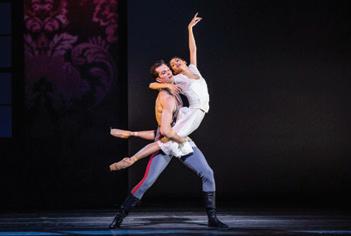
In a new performance and exhibition, artist Nereida Patricia and collaborators explore the politics of trans visibility.

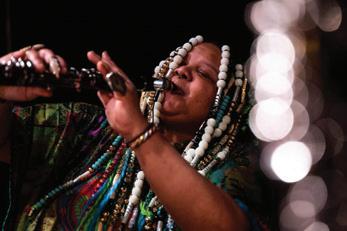
80 years
With a new album and a concert
PUBLISHER AND PRESIDENT SOLOMON LIEBERMAN EDITOR IN CHIEF ENRIQUE LIMÓN
MANAGING EDITOR SALEM COLLO-JULIN
PRODUCTION MANAGER KIRK WILLIAMSON
SENIOR GRAPHIC DESIGNER AMBER HUFF
STORY EDITOR SUJAY KUMAR
NEWS EDITOR JIM DALEY
THEATER AND DANCE EDITOR KERRY REID MUSIC EDITOR PHILIP MONTORO
CULTURE EDITOR: FILM, MEDIA, FOOD & DRINK TARYN ALLEN CULTURE EDITOR: ART, ARCHITECTURE, BOOKS, LITERARY ARTS KERRY CARDOZA ASSOCIATE EDITOR AND BRANDED CONTENT SPECIALIST JAMIE LUDWIG SENIOR WRITERS LEOR GALIL, DEANNA ISAACS, BEN JORAVSKY, MIKE SULA STAFF WRITERS DEBBIE-MARIE BROWN, KATIE PROUT LISTINGS COORDINATOR MICCO CAPORALE COPY EDITOR SKY PATTERSON
EDITORIAL INTERN EJUN KIM
VICE PRESIDENT OF OPERATIONS ANN SCHOLHAMER
DIRECTOR OF PEOPLE AND CULTURE
ALIA GRAHAM
DIRECTOR OF MARKETING VIVIAN GONZALEZ MARKETING PROJECT STRATEGIST SHAWNEE DAY NEWSLETTER ASSOCIATE CHASITY COOPER SOCIAL MEDIA MARKETING ASSOCIATE NIESHA DAVIS
TECHNOLOGY MANAGER ARTURO ALVAREZ OFFICE MANAGER AND CIRCULATION DIRECTOR SANDRA KLEIN
DIRECTOR OF CHICAGO INDEPENDENT MEDIA ALLIANCE (CIMA) SAVANNAH HUGUELEY
SENIOR VICE PRESIDENT OF GROWTH AND STRATEGY AMBER NETTLES VICE PRESIDENT OF SALES AMY MATHENY SALES TEAM VANESSA FLEMING, TIM OGDEN, WILL ROGERS DIGITAL SALES ASSOCIATE AYANA ROLLING MEDIA SALES ASSOCIATE JILLIAN MUELLER
ADVERTISING ADS@CHICAGOREADER.COM
CLASSIFIEDS: CLASSIFIEDS.CHICAGOREADER.COM
NATIONAL ADVERTISING VOICE MEDIA GROUP 1-888-278-9866 VMGADVERTISING.COM
JOE LARKIN AND SUE BELAIR DISTRIBUTION CONCERNS distributionissues@chicagoreader.com 312-392-2970

READER INSTITUTE FOR COMMUNITY JOURNALISM, INC.
CHAIRPERSON EILEEN RHODES
TREASURER REESE MARCUSSON
SECRETARY KIM L. HUNT DIRECTORS ALISON CUDDY, DANIEL DEVER, MATT DOUBLEDAY, VANESSA FERNANDEZ, TORRENCE GARDNER, ROBERT REITER, CHRISTINA CRAWFORD STEED
READER (ISSN 1096-6919) IS PUBLISHED BIWEEKLY BY THE READER INSTITUTE FOR COMMUNITY JOURNALISM 2930 S. MICHIGAN, SUITE 102 CHICAGO, IL 60616 312-392-2934, CHICAGOREADER.COM
COPYRIGHT © 2023 CHICAGO READER PERIODICAL POSTAGE PAID AT CHICAGO, IL ALL RIGHTS RESERVED. CHICAGO READER, READER, AND REVERSED R: REGISTERED TRADEMARKS ®
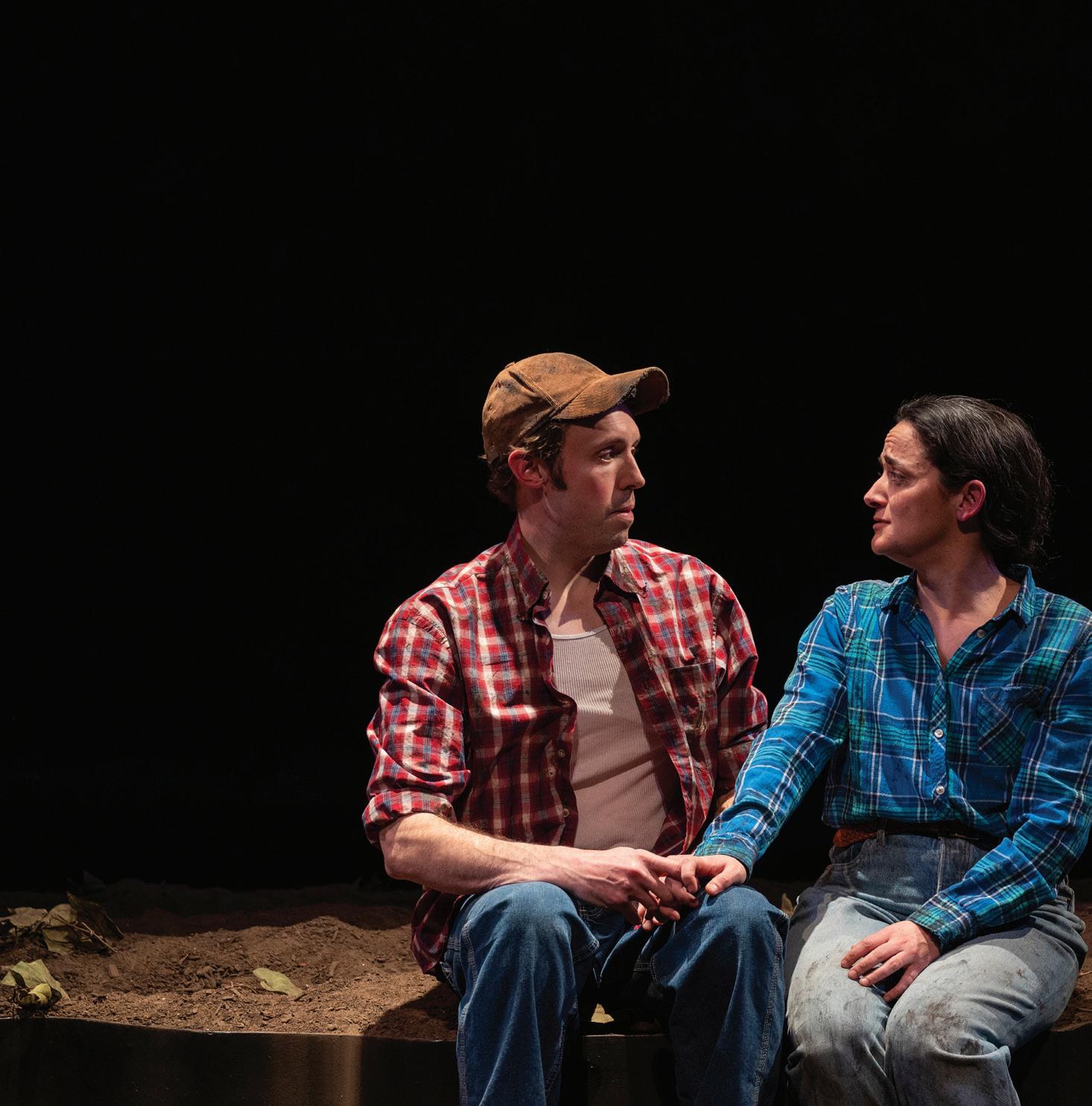
OFFCUT CUTTING BOARD WORKSHOP

Sat 3/4, 10 AM-noon, noon-2 PM, or 2-4 PM, JLF Projects, 3951 W. Belden. $100, register at offcut.shop/products/make-it-take-it
brush mark and hardware that’s exposed and things like this that typically aren’t so popular. We’re gonna make them popular.”
If you’ve ever dabbled in woodworking, you probably have a sense of just how much scrap material can go to waste. Lumber is sold in predetermined sizes, like the ubiquitous 2x4, so once you have the cuts you need, you’re likely to end up with various odds and ends that are hard to put to use. It’s a problem that woodworker and designer Jason Lewis has been thinking about for a while, and one that he may have figured out an answer for.
O cut is a line of furniture and home goods made from the detritus of Lewis’s busy custom woodworking shop, JLF Projects. The name Offcut refers to the scraps of boards that are left over “in the process of making lumber into furniture,” Lewis says; those scraps not only served as the inspiration for the project but are also the raw material for the pieces. In 2020, Lewis and his team moved into a new space at the western edge of Logan Square, and soon after, Offcut became a reality, thanks in part to the addition of local sculptor-turned-woodworker Lesley Jackson, who serves as Offcut’s codesigner and manager.
Lewis’s 2,500-square-foot showroom includes a mix of both his personal works— which are fl awless in execution and tend to showcase the original look of the wood—and O cut designs, which are a bit more eclectic.

Lewis and Jackson work on O cut projects together, using a quick, almost spontaneous design and execution process that’s unusual in the world of designed objects, where cre-
ators might spend months or years tweaking an idea.
“From the beginning, the idea was we do a product a week,” Lewis says. Once an object is completed, it gets photographed, uploaded to O cut’s Instagram, and sent out via their email newsletter.
“Basically it’s coming in on Monday, looking at the scrap that’s been produced through the custom commissions that the shop is doing, and then the two of us brainstorming, like OK, what could this material be?” Jackson says.
To date, the pair have created a panoply of items, from a series of sculptural lamps, to a chainsaw-sculptured plywood side table, to hanging shelves made of tiny patchworked shapes. “We’re working quickly through ideas with this sheer determination to use the material and not overthink and like really focus on functional, simple forms,” Jackson says.
The objects are often elevated aesthetically using water-based dyes or paint washes that are applied by hand, such as a minimal cubed mirror holder, made with a checkerboard of light and dark wood, which respond differently to the paint. These flourishes also add a touch of the designer’s hand, which is often missing in fine furniture production. “The hand is there, but you don’t see it,” Jackson says. “It’s been sanded away and shaped to perfection. We try and fi nd ways to embrace those moments and just celebrate the paint-
Jackson estimates that the wood shop, which employs nine people, creates three or four 30-odd-gallon buckets of scrap per week. Lewis estimates that about 90 percent of what the shop works on in a given week are custom commissions, from smaller-scale residential furniture to bigger commercial jobs. As Offcut has evolved, there are some items they can plan on creating in advance, such as the sculptural lamps, which are now designed in batches. Jackson shows me a bin where she stores funny geometric scraps that she knows will work for the lamps: rounded end pieces, long, narrow strips. “These pieces just sort of happen over time,” she says. “Put a block and take it away, and come back the next day and move it an inch over.”
Lewis entered the woodworking trade randomly, over 20 years ago. At the time, he was doing unsatisfying o ce work. He stumbled upon a custom furniture shop in Oak Park that also ran a one-year apprenticeship program. He signed on and never looked back, and now he wants to help provide learning opportunities for the public through a new series of Make It Take It workshops. The one-day workshops aim to accommodate a diverse range of folks, so you don’t necessarily need woodworking experience to participate. Some will be based around simple composition and assembly work, like making candlesticks, and others are more hands-on and technical, such as a March 4 event where participants will make their own cutting boards. Jackson has a background in teaching—she used to help manage the wood shop at the School of the Art Institute and also runs workshops through the experimental design studio The School of Many Questions.
Offcut is also collaborating with SAIC’s Department of Designed Objects on a new course this spring, wherein students will design and create pieces using O cut’s scrap. The collaboration will culminate in an exhibition at Lewis’s showroom later this spring.
“We are excited about that because we’re really interested in just helping other designers to promote their work,” Jackson says. Lewis hopes to continue to use the space to connect and showcase the work of other designers and to help foster a community. “That’s definitely something that’s driving what we’re doing,” he says.
@booksnotboys
Offcut turns scrap lumber into custom designs.Offcut’s Yellow Patchwork Shelf COURTESY OF JLF PROJECTS The Make It Take It workshop on March 4 will teach participants to make their own cutting boards. COURTESY OF JLF PROJECTS

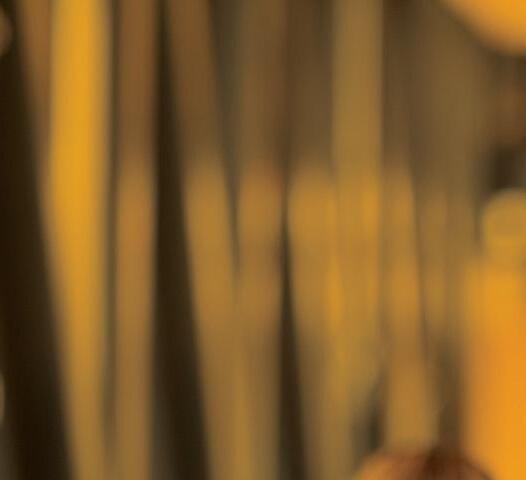















“Bread King of Lagos,” commissioning independent hawkers to distribute the rectangular loaves across the country’s railway system and beyond.
Agege bread became known by the name of the Lagos suburb where a particularly prolific baker was headquartered, according to food writer Ozoz Sokoh. Today the bread is sold everywhere: on the streets, in shops, and in bakeries, and—cutting across class lines—it’s eaten by everyone. It swaddles fried eggs. It’s used to scoop up the steamed bean pudding moin moin. It’s spread with butter and jam (or peanut butter) and made into sandwiches with the fried, savory bean cakes akara.
In the video for the song “Agege Bread,” the late comedian Sir Kay Kamoru plays a naif—a rural, Igbo visitor to the UK who, when confronted with a full English breakfast (bacon, sausages, eggs, beans, tomatoes, etc.), embarks on a madcap quest across London in search of the soft, squishy brioche-like staple bread of Nigeria. It ends in a tug-of-war with a shopkeeper over an unpaid loaf, with the approaching bobbies’ sirens howling in the distance.
Six years ago, Nigerians in Chicago weren’t quite that desperate. Agege-style loaves were shipped to Chicago’s African and Afro-Caribbean groceries from Minnesota, Ohio, or Canada. But for expats like Olugbemisola Olawumi, who grew up in Lagos buying and eating fresh agege bread each day, they were a poor substitute.
“You shouldn’t be getting it from out of state,” says Olawumi, who opened Joba Foods and Bakery for retail in December in a small Bucktown storefront on Western Avenue, selling Nigerian meat pies and large, pillowy, subtly sweet loaves of the freshest, whitest agege bread this side of Lagos. Before she started her wholesale operation, the only other passable local alternative was denser, heavier, Jamaican-style hard dough bread.
In fact, the origins of agege bread began in Jamaica in 1918, after a budding industrialist named Amos Shackleford, inspired by Marcus Garvey and the back-to-Africa movement, resettled in Nigeria and opened a bakery. There he introduced the dough brake, a kneading machine that produced the bread’s signature lush texture and allowed him to scale up. Shackleford eventually became known as the
As a radical alternative to the pandemic sourdough obsession, Olawami recommends it for avocado or French toast. It’s ideal for any situation that might call for a Pullman loaf, brioche, or Japanese milk bread. I was planning to give bread pudding a try with a Joba loaf until, after just two days’ scarfing down PB and Js and grilled cheese, I realized it was all gone.
Olawumi’s foregone coronation as the Bread Queen of Chicago began not with flour, water, salt, and yeast, but with small chops—the family of Nigerian finger foods essential to every party and gathering. Seven years ago she was working in corporate public health when she shifted gears after her pastor suggested to the congregation that there was a good business opportunity for someone with the gumption to open a moin moin catering operation. Olawumi prayed on it and went for it, launching Joba Small Chops, and began cooking for weddings, parties, and everything: bean pudding, jollof rice, sausage rolls, and the sugar-dusted deepfried doughnuts called pu -pu s.
Relying on her lab experience studying at Chicago State University, she eventually tackled agege bread. Along with some help from baker contacts back in Nigeria, she learned to adjust her recipe for differences in ingredients between West Africa and the U.S. and sudden changes in ambient temperature and humidity.
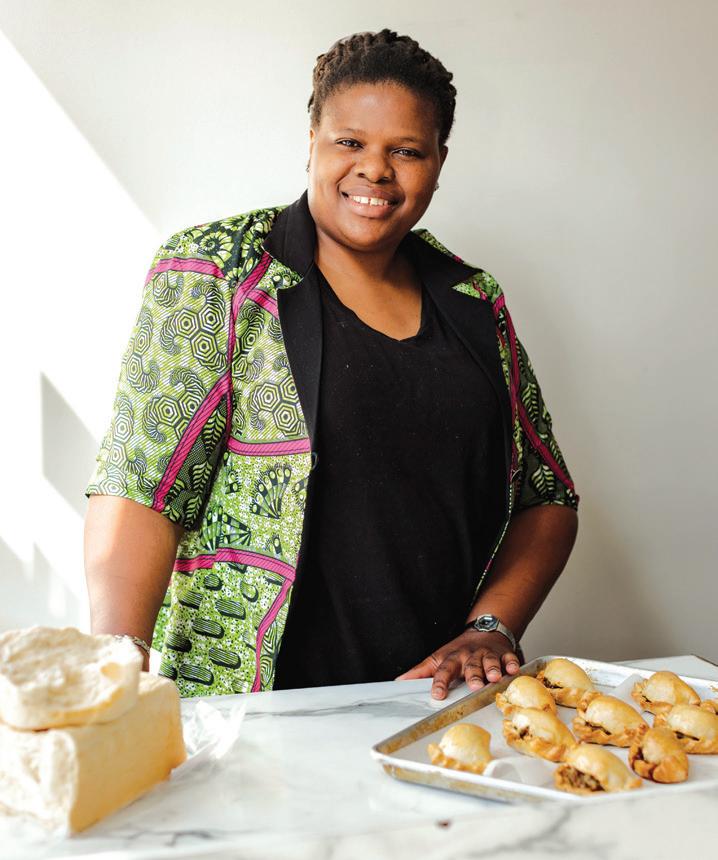
“If it’s super humid out, the fermentation process is now super fast, where there’s almost zero flavor in the bread,” she says. “It doesn’t get the pillowy texture that you want. It can kind of get crumbly if it’s too cold.”
She conducted R&D in her home kitchen, testing the results on friends and family and learning by trial and error. When she eventually nailed it, she started charging for it and began taking samples of the bread to groceries around the city and suburbs.

2039





Thu-Sat




In 2018 she was ready to scale up, dropping the “Small Chops” from the name and moving operations into the Western Avenue storefront, bringing on a crew of three to four bakers. Before their overnight shift, Olawumi preps a proprietary blend of ingredients to be added to batches of flour, yeast, salt, sugar, and water at 110 to 115 F. The dough is portioned, rolled in pans, and allowed to rise for 40 to 45 minutes before going into the oven for 20 minutes between 320 to 350 F. She makes three to four runs in a week,

producing about 800 to 1,000 loaves distributed among some ten small groceries in the city and suburbs. Agege bread is made with minimal preservatives, and it does tend to dry out relatively quickly—not usually a problem when you’re eating it every day. Olawumi gives hers two weeks tops in the bag, but it doesn’t stay on the shelves that long; she restocks her customers every few days. She recommends buying two loaves at a time and freezing one for later.
In December things were running smoothly
enough to open the storefront for a small retail operation, selling agege bread along with some Western-style sweets like chocolate chunk cookies, banana bread, and scones. On the savory side, she’s brought back a few small chops too: thyme and curry-seasoned chicken or beef and potato meat pies. She’d like to reintroduce more, but demand for bread is high. Like Amos Shackleford, her primary goal now is expansion. Coming full circle she o ers
two-day shipping out of state and sends it to regulars in Wisconsin, Florida, and Georgia.
“[In Nigeria] pretty much every table, every breakfast, every family will have the bread represented in the meal,” says Olawumi. “The original idea was to represent in Chicago. Now the goal is to be able to get it into neighboring cities and give people a taste of home.”
@MikeSula
and programs for Special Olympics athletes in Illinois.
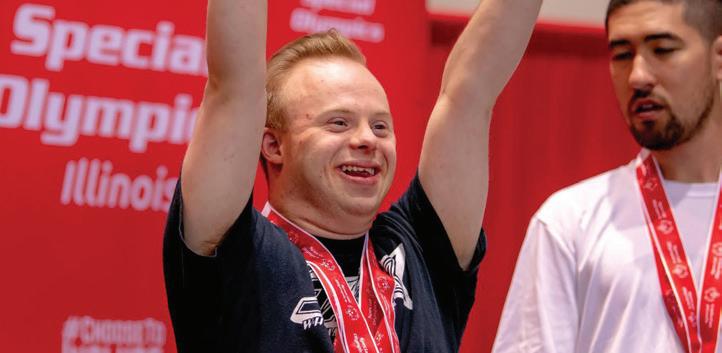
Lakeshore East Park is a hidden garden situated in Chicago’s New East Side, a newly demarcated downtown neighborhood enclosed by the city’s illustrious landmarks: the Chicago River, Lake Michigan, Millennium Park, and the bustling Michigan Avenue.
Though small in size, the mixed-use development offers it all: a local coffee shop, boutique nail and hair salons, an international school, an upscale Greek restaurant, a breakfast diner, Subway, an Indian mart, and a dog
The employees appeared to outnumber the few shoppers. Muffled chatter echoed from one side of the store, by the wine and liquor department.
Behind the counter of the M bar, 51-year-old bartender Kristopher (aka Kris) was drying wine glasses with a cloth while he chatted with his coworker, Henry. Above him, a mounted TV played TMZ on TV. I sat at the end of the counter and fished out my notebook and an Alani Nu energy drink from my tote bag. From now on, this would be my usual seat.
“Can you turn the TV to ESPN?” Henry asked Kris. Henry works by the cash registers, but he regularly pops into the bar to catch glimpses of a game or chat with Kris. “Sure, I didn’t have this crap on,” Kris said.
On ESPN, the White Sox were playing the Kansas City Royals. “I hate baseball,” Kris said, turning to face me. “Almost as much as I hate hockey, which is a racist sport.”
It’s often said that bartenders are like free therapists. But Kris leans on his customers for his own emotional well-being. He’ll go o on what he calls his “batshit rants,” about American cinema, sports, and his compulsive gambling, among other things. He’s a great listener, though, if you can manage to get a word in.
By BOUTAYNA CHOKRANEpark.
But the centerpiece isn’t what you’d expect. It’s the Mariano’s Fresh Market—a true Chicago staple.
On the upper level of 333 E. Benton, a smoothie bar serves superfood shakes. During the summertime, shoppers can order sizzling hotdogs and burgers at the outdoor barbecue.
On the lower level, nestled between the wine and beer aisles, is Nob’s Wine Bar.

Despite the popularity of the wine bar in Mariano’s locations across the city, nobody
knows who Nob is or how the grocery store bar got its name. Regulars call it the M bar, for Mariano’s. And at the M bar, neighbors love to hang out and grab a drink—or three.
On a soggy, spring afternoon, Lakeshore East Park was quiet, except for the consistent caws from the crows who inhabit the quarter too. Inside Mariano’s, the energy felt similar. Wet footprints stained the streaky brown floors.
A middle-aged man with blue eyes, Kris is tall, bald, and full-figured. This day, he sported a periwinkle floral button-down and black trousers. His white-haired beard was unkempt (per usual), which he commonly talks about since he stopped dying it and decided to embrace aging. “I knew God had a sense of humor when all the hair disappeared from my head and showed up in other places on my body,” he told me.
“You can turn it up, Henry,” Kris said, referring to the muted baseball game.
“No, I don’t want to listen to these airheads anyway,” a voice chimed in, referring to the commentators. It was Bruce—an elderly man who hangs out at the bar nearly every week, sometimes while his wife grocery shops. He sat at the counter while Kris poured him a glass of sparkling white wine.
As five o’clock approached, more people
With cheap drinks and familiar company, a grocery store bar is the hidden oasis in downtown’s Lakeshore East development.Nob’s Wine Bar—or M bar, as it’s known by most DANIEL ZALKUS FOR CHICAGO READER
trickled in with their wet coats and umbrellas. When Kris checked the time on his phone, he remembered he had to place today’s NBA bets on DraftKings, a sports betting app he frequently uses. He couldn’t do it inside because of the store’s restricted WiFi.
He checked in on each of his customers before excusing himself. “Henry, you’re in charge!” he hollered on his way out, heading to the dog park across the street.
A few moments later, a damp Kris returned with zero bets. “It’s raining too hard,” he said. “I don’t know if this thing is waterproof.” He smacked his Motorola. “I dropped it in the toilet recently and it still works, so I guess it is.” Bruce teased Kris, saying he must have been drunk. “I’m the most sober person in this room,” Kris replied in self-defense. “I only drink in New Orleans.”
Kris grew up in Bridgeport, but nonetheless declares himself “a New Orleans guy.” He started working at the M bar seven years ago. After his second divorce, he sought a job where his employers could monitor his drinking. According to him, he lost his second wife due to his gambling and drinking habits. After the divorce, he wanted to quit both, and Mariano’s was where he felt he could stay on track.
Kris only started gambling again recently when he discovered DraftKings, which he says makes it almost too easy. “Now I can lose all my money and not get yelled at,” he told me.
Kris now lives in a one-bedroom apartment on the north side with his 16-year-old cat Clu— who he named after The Return of the Living Dead actor William Martin “Clu” Gulager. Growing up, he wanted to be a screenwriter and even briefly moved to Los Angeles, where he sold one of his screenplays, The Ride, a 1997 movie, starring actor Michael Shannon, about three men stealing a car.
With the money he received, he could only afford six months of Hollywood rent and returned to Chicago shortly after.
In 2020, when the bar closed for six months, Kris was out of work and spent that time at home, working on his screenplays: a mobster comedy and a vampire parody. He’s hoping to sell one of them to the same producer who
bought his last screenplay. During the lockdown, Kris could’ve worked at Mariano’s as a cashier, but he insisted that he’s “strictly a bartender.”
At one point, Kris even tried stand-up comedy, booking gigs at local pubs like Irving Park’s The Abbey. He stopped during the Trump administration, because he says he feels like people got “too sensitive” about his jokes. Some of his bits can be found online—where he spouts about cunnilingus and how “gay” high school wrestling is, and makes a derogatory comparison regarding what it’s like to grocery shop while you’re stoned. When I asked him about his outwardly offensive stand-up, Kris said, “I’m not a racist or a homophobe, but I grew up around these people, so I should be able to [speak on it].”
Back at the bar, later in the evening, Kris was surfing through the channels. “Not the news, that’s depressing,” he mumbled to himself. “It’s probably about Ukraine or Roe v. Wade.” He skipped Animal Rescue because “That’s probably also depressing.” He ended up settling for ESPN again.
“Baseball is like purgatory,” Kris said to me. Then, he proceeded to do an imitation of a newscaster in purgatory. “Coming up is hockey, followed by Sons of Anarchy, then Tucker Carlson for hours,” he said in his best anchor voice.
Anne knows everybody, and everybody knows Anne.
At the counter, I often find her—a 74-yearold woman with shoulder-length graying hair that frames her eyeglasses—sipping red wine and munching on SkinnyPop popcorn or cheddar-flavored Kettle Brand chips. The Lakeshore East resident almost always wears her signature fuschia half-zip sweater.
On a Thursday evening, Anne walked into the bar holding a stalk of celery she had just bought. “I almost got hit by a motorized scooter,” she announced to anyone who was listening, in the midst of several, separate
tipsy conversations. No one responded, but Anne didn’t seem to mind.
At the counter, Anne—two seats away from me—gave Kris the celery and requested he keep it cool in the beer cooler. “I’m only having one glass today,” Anne told Kris. She’s getting up at five tomorrow morning to go swimming. Anne often proclaims a one-drink limit; Kris likes to tease her about it.
There were ten people seated at the bar and all the wine glasses were taken, so Kris started serving customers wine in red solo cups, which he wasn’t happy about. “It’s a wine bar with six wine glasses,” he complained to almost every customer who walked in that day.
“Do you want the big glass?” Kris asked Anne, reaching for a tulip beer glass.
“Sure, I need to strengthen my arm,” Anne replied as she curled her bicep. “Can’t you just order more glasses?”
“I can’t do anything about it,” Kris said, visibly peeved.
“Just go to Target and buy a bunch of them,” Anne told him. Then she added, “You’re not in a good mood today.”
“He’s always like this,” Tom, another frequenter, chimed in.
“No, he seems stressed out today,” Anne disputed.
“Really?” Kris asked.
“Yeah, you’re wired,” she replied. And before he could answer, Anne made an educated guess. “Oh . . . you lost money today,” she said with a smirk. She was right. Later, Kris told me he lost a lot of money on bets the day before.
An hour passed, and Anne finished her second glass of wine. Kris o ered her a “splash” of tequila. (A splash is a free sample. Kris typically o ers a splash to his regulars.) “Is it gluten-free?” Anne asked Kris, who had already walked off to serve other customers. With a quick Google search, I was able to clear the tequila for Anne, which she leisurely sipped while we chatted. I mentioned that I was writing a story about the bar and that I’d noticed her presence almost every day. “I don’t really consider this a bar,” she said. She did not provide an alternative term for the place.
After two glasses of wine and a tequila
splash, it was just past eight o’clock. “I’m usually asleep by nine o’clock,” Anne said to the crowd. Then, she whispered to me, “Do you really see me here every day?”
“No, just a few times a week,” I replied, softening the blow.
“Well, that’s depressing,” Anne said.
On a random Tuesday afternoon, Sarah, a 28-year-old enterprise consultant, walked into the bar and sat at the corner next to Anne and a couple, who were chatting with Kris. She had just gotten out of work and was waiting for her ride back to Andersonville, where she lives. Her friend was picking her up, and in exchange, she was helping her friend move.
Sarah requested her usual, a sauvignon blanc. She usually sat alone, scrolling through her phone, occasionally looking up to greet acquaintances. Her blonde hair was styled in an undercut buzz and she wore black dress pants, a ruby-red top, and a black blazer. A maroon pair of heels, the same ones she wore to her wedding at the Woman’s Club of Evanston in the fall of 2021, complemented her business casual outfit.
Sarah was texting, seemingly inattentive, when Kris recounted a “bad joke” he made on Facebook the other day. Something about COVID-19 and how he was the only one on the CTA not wearing a mask. It didn’t land well.
“I hate to say it, but this city is getting too liberal even for me,” Kris said. Sarah glanced up from her phone, raised her eyebrows, and made eye contact with me—a “Can you believe this?” look. Then, she grabbed her drink, coat, and bag and walked over to my side of the counter. “Can I sit with you?” she asked. “I feel much safer here.”
Kris noticed that Sarah moved seats. “What, you wear a mask on the CTA?” he asked.
“Yes!” she scoffed in disbelief. Kris and Sarah knew they held opposing viewpoints (they once argued about hockey for ten minutes), but respect still lingered in their interactions. A few minutes later, Kris o ered Sarah
continued from p. 9
a splash of a new bottle of white wine.
“Another one for you, Sarah?” he asked.
“Yes, please, thank you, Kris,” she replied. Sarah discovered the M bar a few years ago when she was just visiting the downtown area. Now that she works at Blue Cross Blue Shield, which is just around the corner, she stops by after work twice a week to kill time and enjoy some inexpensive wine. Since her wife is a mental health therapist who works after normal business hours, Sarah prefers to hang out there than at home alone. “It’s convenient, and who could say no to three-dollar wine?” she told me.
“I felt starved during the pandemic,” Sarah said, referring to the lack of human interaction. She said she finds the bar refreshing. “It’s a weird, little microcosm,” she said. “I’ve had some fun, random conversations . . . I’ve met a lot of strange people here.” I asked her to elaborate.
“I would put money on those three guys being workers [in the neighborhood],” Sarah told me, discreetly pointing toward the young men in suits sitting at a table drinking beer. “And [Anne], I believe her name is, in the fuschia sweater—she’s a local who comes here to drink.”
During the rest of our time together, Sarah showed me pictures of her cats and of her wedding. “I just love my wife,” she gushed, three glasses and a splash deep.
Her glass was still full when her friend texted her that they had arrived to pick her up. “Want to take it to-go?” Kris asked, reaching for a solo cup.
“I’m pretty sure that’s illegal,” Sarah said, but she still inched toward the wine.
“I aim to please,” Kris said as he handed her the cup.
After she left, Kris picked up the full cup of water he poured Sarah when she first arrived. “She didn’t touch it again,” Kris told me. “Write that down: water waster.”
It was Friday the 13th—and happy hour. A live jazz band played. It was one of the city’s first sunny days after a grueling winter.
Yet, all the seats were taken. Bruce and his wife sat at a corner table. Two women chatted as they sipped their glasses of white wine. Singles wandered around and mingled with the rest of the cheery crowd. A couple enjoyed their ciders while chomping on barbecue chicken nuggets. Their child was sound asleep in the stroller.
Everyone was smiling, except for Kris.
“I hate Fridays, but I need the money,” he told me.
Fridays are the busiest. Kris has little time to chat or rant. The news was playing on the TV, but he was going to switch channels soon, for the Boston Celtics game. He had placed a few bets.
My usual seat at the bar was taken. So, I sat alone at a high-top table in the back and watched the scene unfold around me. In between sets, one of the band members walked up to the bar to chat with a regular. They go way back; they went to school together. Others made their way to the band to o er tips and praise. With the ambiance, I almost forgot it was a Mariano’s, reminded only by people snacking on groceries like peanuts, cocktail shrimp, and Garrett popcorn. And maybe it’s unusual for a supermarket bar to feel like such a community hub, but for some reason, it makes sense in this corner of post-lockdown Chicago, for the people of Lakeshore East.
I o ered my table to a group of friends and said goodbye to Kris before leaving. The jazz band started playing “My Kind of Town” by Frank Sinatra.
“Chicago is one town that won’t let you down. / It’s my kind of town.” v
@boutaynaaa
After “Meditations in an Emergency” (titled after Frank O’Hara) by Cameron Awkward-Rich
who needs hallucinogens when you could get a concussion free of charge? if you pretend. in reality, a slice of my paycheck pays for all this rah rah shit— all this riot gear you know what’s cheaper than a police o cer? a Percocet.
but everyone’s on the front line and We’re sober, getting our asses beat for the low cost of 1.8 billion dollars a year. and the sanitary workers that clean our blood up off the sidewalks need a raise; i pledge my allegiance to them n*ggas too, but back to my troops. who you know could get caught with their empty hands up and still get a 21-gun-salute?
and the whole world will say their name and never even know what it means. and strangers will tag their praises on to walls that get painted over in neighborhoods where n*ggas like that use to live. when a cop dies, the whole neighborhood stops. the funeral procession is a long parade of police cars and fire trucks. my soldiers deserve the same energy. so We organize and stop the whole neighborhood, too. and the cops gone show up whether they’re invited or not.
We got fire trucks, paddy wagons, jail buses and f*ck it garbage trucks too. when washington park got hit by the blizzard this year wasn’t a damn salt truck in sight, but they at this protest though. hell! have the mayor come out and speak a few words, so she can get stomped into the earth where our soldiers been laid. some of Us really know what dirt taste like; that’s what it takes to be a soldier. or so it seems. and i pledge my allegiance to each and every one of Y’all. “hand on my heart hand on my stupid heart.”
Chima “Naira” Ikoro is an interdisciplinary writer from the South Side of Chicago. She is a Columbia College Chicago alum, a teaching artist at Young Chicago Authors, and South Side Weekly’s Community Builder. Alongside her friends, Naira co-founded Blck Rising, a mutual aid abolitionist collective created in direct response to the ongoing pandemic and 2020 uprisings.
A biweekly series curated by the Chicago Reader and sponsored by the Poetry Foundation.






Hours
Wednesday, Friday, and Saturday: 11:00 AM–4:00 PM
Thursday: 11:00 AM–7:00 PM
Open Door Reading: Ari Banias, Joss Barton, Alex Jane Cope, & KOKUMO (Hybrid)
The Open Door series highlights creative relationships in Chicago, including mentorship and collaboration.
Thursday, March 2, 2023, 7:00 PM
Learn more at PoetryFoundation.org
e Negro Motorist Green Book is an exhibition that highlights the history and legacy of “ e Green Book,” the annual guide that provided Black Americans with information on restaurants, gas stations, department stores, and other businesses that welcomed Black travelers during the Jim Crow era.

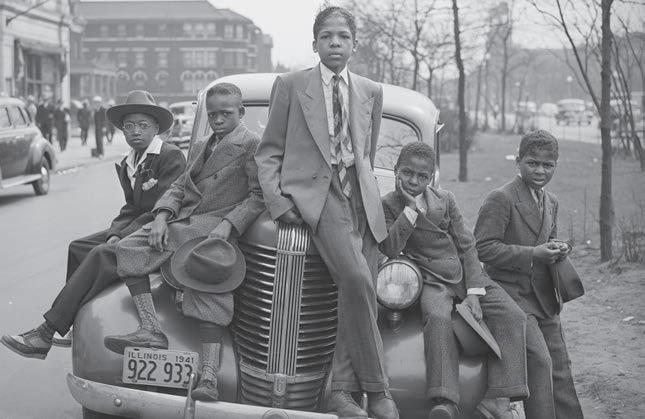
Chicago has one of the largest transit systems in the United States, but despite its size, it has many flaws and challenges that prevent it from serving all Chicagoans equally and equitably. Transit 4 All seeks to change that by expanding and improving public transit while making it safer, more equitable, and more affordable.
Launched in February 2021, the campaign is spearheaded by Chicago Jobs With Justice (the local chapter of national network Jobs With Justice), which formed in 1991 to unite disparate organizations around meaningful campaigns for workers’ rights, and economic and social justice. Today CJWJ is a broad coalition of 40 labor unions and community associations across the city.
“We felt it was important to work on transit because it is so important to a lot of really critical issues that are important to us and important to our coalition members,” says Chicago Jobs with Justice codirector Susan Hurley.
Chief among those issues are accessibility, climate and air quality concerns, and overall quality of life.
DRAWINGS BY MAC BLACKOUT
DRAWINGS BY MAC BLACKOUT
DRAWINGS BY MAC BLACKOUT

PAINTINGS BY LARDO LARSON
PAINTINGS BY LARDO LARSON
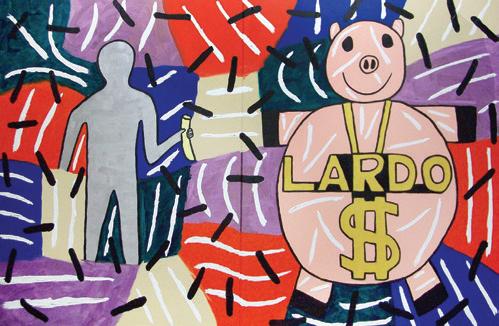
Agitator Gallery 3851 W Fullerton Ave, Chicago
Agitator Gallery 3851 W Fullerton Ave, Chicago
Agitator Gallery 3851 W Fullerton Ave, Chicago
Opening March 4, 2023 6–10 pm
Opening March 4, 2023 6–10 pm


Closing and performances March 24 6–10 pm
Opening March 4, 2023, 6-10 pm
Closing and performances March 24 6–10 pm
Closing and performances March 24, 6-10 pm
“Everyone’s a worker, and so we have to make sure that this city and the transit system is accessible for everyone, and is accessible in every way,” says co-director Jill Manrique.
To that extent, Transit 4 All strives to make Chicago transit more inclusive of everyone, regardless of barriers linked to age, income level, ability, race, or anything else. “Racial equity and racial justice are top priorities,” Hurley says. “We have to do a lot of work on our transit system and our transit service to address gaps in service. There are a lot of parts of our city where it’s just not feasible to get from point A to point B by transit.”
Those issues impact all parts of Chicago to some extent—consider the travel time between Rogers Park and Tri-Taylor via train, for example—but they’re most evident on the city’s far south and southwest sides, where train service is less extensive, forcing people to rely on buses or cars. “Driving itself is an enormous burden,” Hurley remarks. “It o en puts people in harm’s way of our criminal justice system, whether it’s a broken taillight or headlight, or whether you’re able to keep your insurance, keep your license tags, stickers, and your driver’s license up to date. All of these are additional burdens on the individual, let alone the cost of having, maintaining, and parking a car.”
Read the rest of this article online and find out more about Transit 4 All at chicagoreader.com/ transportationseries.
1. Members and friends of local skateboarding collective froSkate
2. A photo of a smiling Tyre Nichols
3. “Once we heard he was part of our skateboarding community, we were hurt on a whole nother level,” said froSkate founder Karlie Thornton.
4. An artist’s rendition of Nichols, surrounded by fl owers and candles
5. Attendees skated in Nichols’s honor at the vigil.
6. By candlelight, people honored Nichols through song, meditation, and collective resilience.
On February 10, Chicago’s skateboarding community gathered at Grant Skate Park for a candlelight vigil in remembrance of Tyre Nichols and all victims of police brutality.
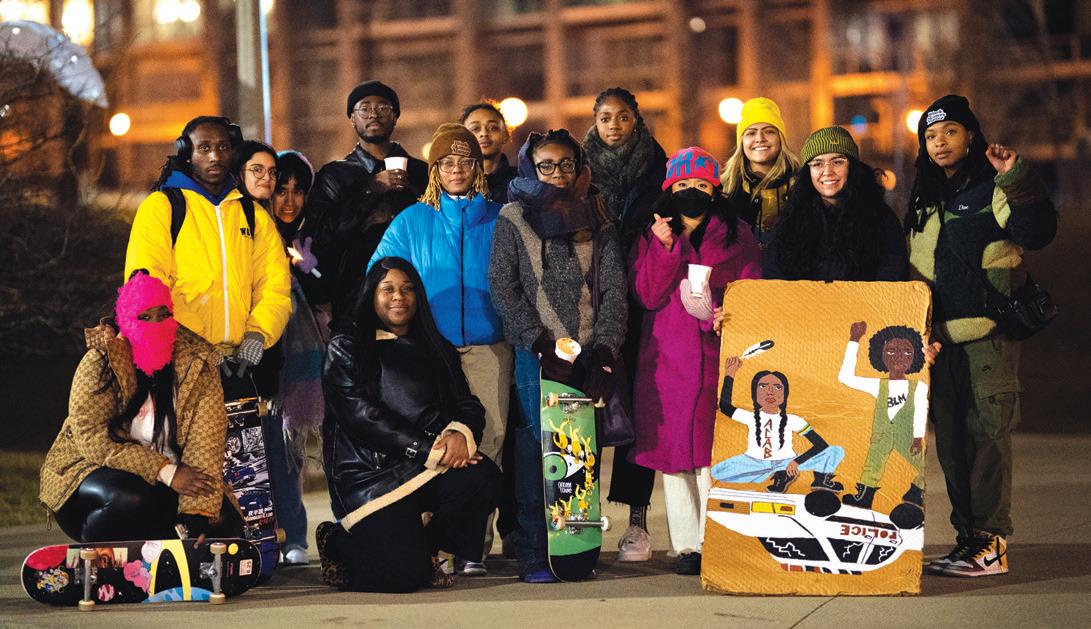
With the horizon awash in baby pink and Creamsicle orange, members and friends of skateboarding collective froSkate huddled together at the skate park to meditate and sing. By the ramps, other community members ladled hot chocolate into Styrofoam cups. In a beanie embroidered with the words “Black Skaters Matter,” froSkate founder Karlie Thornton passed out hand warmers. As both teen and adult skaters launched into
kickfl ips and ramp tricks, the grating sound of board on pavement complemented the solemn flow of song.
FroSkate—the city’s fi rst skate collective centering BIPOC skaters of trans, gender nonconforming, womxn, and queer communities—hosted the vigil at sunset to honor Nichols, the 29-year-old Black man who died three days after being beaten by Memphis police in a tra c stop in early January. According to family members, Nichols went to Shelby Farms, a park just east of Memphis, almost every day to watch the sunset. Vigil attendees were accordingly asked to dress in the colors of dusk.
“Once we found out Tyre Nichols was
murdered, we were, of course, distraught,” Thornton said. “But once we heard he was part of our skateboarding community, we were hurt on a whole nother level because this feels like losing a family member. We felt like doing something in his honor, as we would for anyone else in the community.”
As attendee Blake Davis performed a rendition of Sam Cooke’s “A Change Is Gonna Come,” the crowd swayed together in solace.
Damon A. Williams, vigil guest and cofounder of the #LetUsBreathe Collective, invited attendees to remember not just Nichols, but all other victims of police brutality. He noted that “community and love” are the solutions to “deal with everything we’ve been going
through.” He asked attendees to make eye contact with the people around them and tell them, “I love you.”
As he concluded his speech, Williams’s final message encapsulated the vigil’s prevailing attitude: resilience.
“The only way we can make more freedom is to live and embody freedom,” he said through a megaphone. “Write your poems and sing your songs. But don’t do them alone. Know that you are not an individual—you are part of a collective experience, and we are trying to create this new world.”
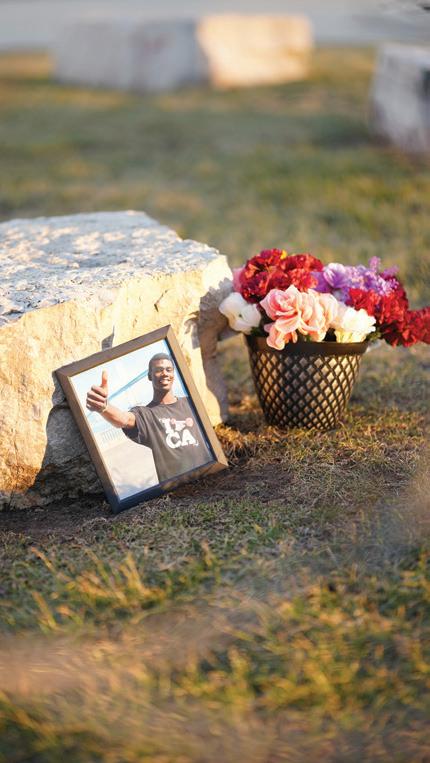


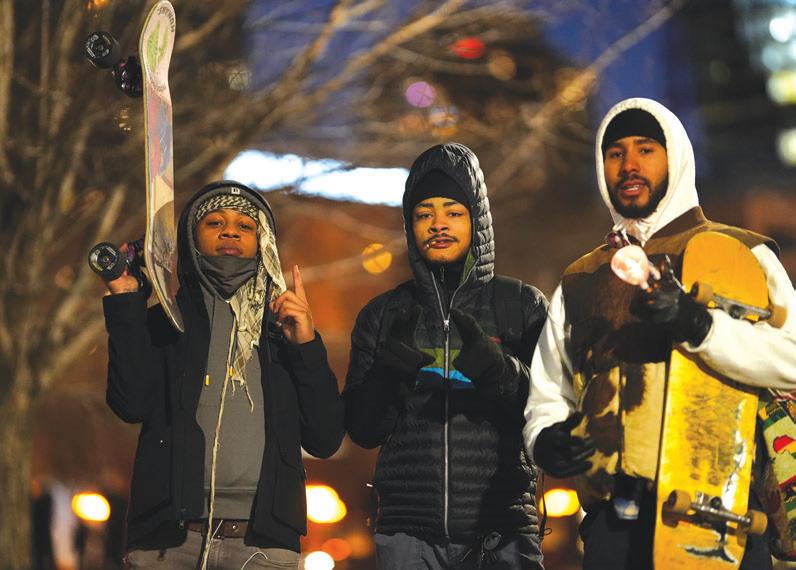
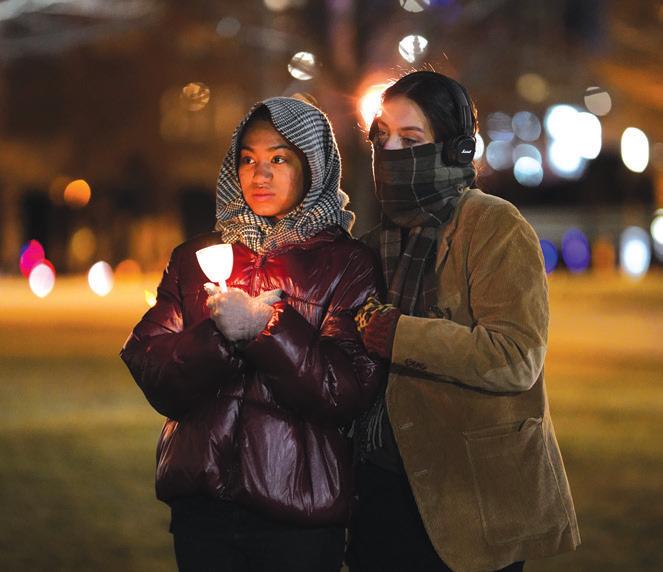
The story of Chicago’s own Black Child Book Fair, a traveling event that promotes literacy for Black kids across the country, starts with Chicagoan and author Darryl Harvey releasing his incipient children’s book in 2010, I Can Do Anything. It features a Black child on the cover and is the first in his Sunflower series, which introduces children to concepts of anti-bullying, selfesteem, working with others, integrity, and accountability.
“Our Black children are reading below the national reading average of third graders and eighth graders,” Harvey tells the Reader over the phone. “We are trying our best to have kids see characters that look like them. And maybe it will spark an interest for them to read more.”

Harvey received a bachelor’s in journalism from Northern Illinois University a few decades ago but ended up in social work for the majority of his professional career. He started his writing career simultaneously in poetry, convinced he would become the next great romantic poet, but social work impacted him more than he expected. “I just got into it,” he tells the Reader . “And if you’ve ever been in social work and you care about people, [it] grabs you and it won’t let you go.” It was his mentorship of a young boy in his casework that inspired him to begin his children’s book career.
Fast forward to 2019, and after hearing years of complaints from Black parents about how difficult it is to find books that include children who look like theirs, he went to social media and announced his intention to launch the Black Child Book Fair. While he searched for other authors to join him and communities to visit, the response was immediate and tremendous.
“I figured, well, if we got such a response in Chicago, Chicago is not the only city that has Black children. Year by year, we’ve grown it and taken it to other cities and have had similar experiences [across the country].” Harvey says that 15 to 25 Black authors follow him to these events (he made 11 trips last year), and Black cultural organizations in di erent cities partner with him to execute the event locally. He depends on his partnerships with schools and social organizations to make sure they get the word out in a particular city.
In Memphis, for example, the local chapter of the National Coalition of 100 Black Women helped publicize the event. The same can be said about Delta Sigma Theta Alumnae support in Dallas, Texas, and Alpha Phi Alpha Alumni support in Indianapolis, Indiana. “But
there’s nothing like Chicago,” Harvey muses. Earlier this month, across two days, more than three dozen Black children’s book authors from around the country flew into Chicago for the fourth annual Black Child Book Fair at Malcolm X College, the largest rendition of the event yet.

Organizations like Chicago Cubs charities, the Mosaic (a PepsiCo employee resource group that helps local African American companies with projects), and E.Y.E. Lead Foundation (a nonprofit that mentors young men of color in leadership and self-esteem) partnered with the fair by sponsoring a visiting elementary school. The organizations “adopt” a school by buying books for all the students. Students were each given a ticket they could bring to any author at the fair in exchange for a book that spoke to them. Later, sponsors pay each author based on the number of tickets redeemed.
The Reader talked to participating authors from nearby and out of state, and what’s clear is that the story about the multitude of Black children’s books we see today is also a story about Black authors printing their own books independently, also known as self-publishing.
Author Felicia Madlock was born and raised in Chicago and has worked as a mental health therapist for more than 25 years. Like Harvey, she started her writing career with poetry. She participated in the bookfair with her two books, Selfish Raine and Teasing Raine, about a little girl reminiscent of Madlock’s daughter, who deals with themes of teasing and sharing. Madlock tells me that in the 90s in Chicago, self-publishing was really starting to take o with Black authors. Chicago’s poetry scene was “on fire,” and you could find an open mike venue every night for poetry; it was Black poets and writers she saw taking the lead with self-publishing.
“That was really one of the catalysts at the time because individuals were starting to take poetry seriously. They were starting to self-publish,” Madlock says. “And that was, for me, just very inspiring.”
She remembers Black authors like E. Lynn Harris and Carl Weber coming out with great novels, all self-published, which really changed the game for her and others. “They made this process feasible for somebody like myself that was really one to stress in the crowd.” That’s when she self-published her first novel, Street’s Sons. The novel was then picked up for a two-book deal with a sleeve imprint from Urban Books, an organization
that boasts Weber as publisher and editorial director.
Madlock also credits Borders bookstore for being instrumental in the visibility of Black authors at the time. The defunct chain’s Black authors section allowed her to see many Black writers and their life synopses all in one place, facilitating the visibility and mingling of Black writers in Chicago as well as nationally.
Empowered by the literary innovation happening around her and guided by her background in social work and mental health, she came across Sherman Beck, a Hyde Park illustrator, and jumped into the children’s book world, with Black and Brown kids in mind as her audience and subjects.
It’s clear that many Black writers across the country are doing whatever they can to support one another.
Among the 35 vendors the bookfair drew was Seattle-based Jeffrey L. Cheatham II. Growing up, the children’s book author was a fan of storytelling—namely, the concepts of good and evil he saw unravel in his favorite comics and wrestling programs, which inspired his own work. “One of my comics was called The Razor. [It was] about a teenage boy going through life, and his superpower was his whole body was sharp enough to cut through anything.”
Cheatham fell into children’s books when his daughter was four and he couldn’t find a dinosaur book she’d requested at the store. As he looked for a suitable replacement, he noticed there weren’t any books with kids on their covers that looked like his own, so he wrote one himself. After he published his first book, Why Is Jane So Mad?, about a young girl upset that her father was far away in the military, he would frequently run into other Black authors who would ask his advice on how to publish their own books. These repeated instances inspired him to create an organization that aims to help potential authors.
“I was like, let’s all eat from the same plate. I have an organization called the Seattle Urban Book Expo,” says Cheatham, who also hosts annual BIPOC bookfairs in the Emerald City.

“And what we do is we help Black and Brown people navigate self-publishing by offering promotional and writing services. . . . One thing I’ve noticed [is] there’s a lot of Black people here in Chicago. Yes, a lot. A lot in Seattle, and Seattle we’re less than 5 percent.”
Harvey sent Cheatham an invitation to the Chicago fair after the pair connected on Facebook. Excited, he jumped at the chance to get back into his children’s book bag, for which he
has authored five titles.
Julia Royston is a retired librarian and full-service publisher who made her way to Chicago from southern Indiana. She’s been aligned with Harvey’s vision since he first posted about it four years ago. Royston has traveled with him to almost every Black Child Book Fair iteration nationwide except for six of them.
As a full-service publisher, she can help authors both at the beginning of the bookwriting process (aka fleshing out an idea) and at its end when they’ve already finished a draft, or even self-published, and are trying to reach a wider audience or understand the layout and cover design process.
Her signature set of books is a series called Write That Book Now, Publish That Book Now, and Promote That Book Now. “There are some people who want to self-publish,” Royston says. “And they want to do it on their own, but they want to do it right the first time.” The author has written in excess of 80 titles that range from self-help workbooks to science fiction, urban fiction, murder mysteries, and, of course, children’s books.
At the fair, older girls loved her young adult book Black Girls’ Guide to Greatness. She also has a series called The Gifted, inspirational books geared toward di erent age groups, all teaching the same lesson: the reader is gifted, and they can accomplish anything they set their minds to.
As a lifelong librarian and lover of books who now travels with the Black Child Book
Fair, Royston says that people are usually shocked to hear that the fair boasts so many children’s books with Black main characters. “Now Scholastic could say, ‘Oh, we put Black children on our books,’ but they’re normally not the main character. They’re usually the sidekick, you know, like the partner,” she says. “No, our books are main characters.”
As a child, she read books like Little House on the Prairie, Dick and Jane, and others that featured primarily white characters.
“There wasn’t nobody Black on the books we had,” she recalls. “The Snowy Day was the first book—and that didn’t come out till like the 70s or 80s—that had a Black child on the cover . . . that was a major breakthrough,” Royston says. “But until then, we just read whatever we got our hands on and didn’t think anything about it. Today, though, these babies like, ‘That’s not about me, that doesn’t relate to me.’ And they’ll throw the book back into the teacher’s face. And, therefore, it pushes them further behind on the literacy and reading scale.”
At the fair on Saturday, Royston sat behind an elaborate layout of nearly 20 books displayed on a table. The day before, three schools visited and brought 150 students combined. Students from Jens Jensen Public School, Betty Shabazz Charter School, and Kipp Academy filled the space, and all of the authors loved it.
“God, they were ripping and running,” Royston says. “It was a wonderful experience, the energy . . . in the room was just incredible. I’m like, you know, if we could bottle
continued from p. 15
this and sell this energy? Yes! But it was just over-the-top.”
A significant number of the authors at the fair had backgrounds in education or social work. Some were parents whose books were based on their relationship with their children, or adults writing from their own younger perceptive reiterating lessons taught to them by their elders. Everyone who reflected on the purpose of publishing a book for youth spoke about wanting to engage kids in literary ways, outside of electronics. And many plot lines of the books displayed were saturated with African American cultural references and were very intentional about which characters bore which identities or experiences.
Paula M. Karll, for example, is a special education teacher who based her book Ellie Meets the New Baby on her own multiracial nuclear family. Damara McKoy, from Washington, D.C., is an anger management specialist whose children’s book The Day I Met Eden introduces caregivers and kids to emotional intelligence and safe emotional expression.
Ramona Gaines sat at a table overflowing with merchandise, themed durags, shower caps, floaties, hair bows, blankets, towels, pillows, etc. You name it, Gaines was selling it. She noticed visiting students picking up books above their grade level but with themes they identified with.
“My name is Ramona Gaines,” she says to me. “I am the author of Nanny and Me. Nanny and Me is a collection of stories written about growing up with my grandmother. That’s what I call her: ‘Nanny’. And so I introduced the stories for my nieces and my nephews because I wanted them to know how we grew up.”
All of her stories highlight and celebrate African American relationships with grandparents, specifically how they’ve served as supplemental parents. But ultimately, Gaines wanted to introduce the tradition of how grandparents have been the backbone of a lot of relationships in rearing the next generation. Her books introduce math, measuring, and cooking in a natural, conversational style between grandparent and child, the same organic route through which she learned the information as a kid.
One of her books is a devotional of words and wisdom she picked up from her grandmother but never totally understood. “My grandma kept talking to me in riddles. Like, ‘Treat people with a long-handled spoon,’ or ‘You don’t believe fat meat is greasy.’ But I was like, what is she really saying? And some things I’m still
unpacking as an adult. However, what I have learned is through living and by inspiration of God, those are scriptural things that were just used in colloquial terms that teach us everyday practical lessons about having the power of choice. Knowing good from bad, knowing what your moral code is, and standing and living on that for the rest of your life.”
Derek Austin sat quietly by himself behind Gaines’s elaborate spread, a poster of a Black-suited superhero at the center of his display. Austin, a full-time graphic designer and photo retoucher, traveled to the fair from Raleigh, North Carolina.
“I’ve been doing graphic design since the 90s,” Austin says. “And I’ve always designed for other people and marketed for other people, but I’ve never done it for myself.” That all changed two years ago.
Back in the 80s and early 90s, Austin wanted to be an animator, but the field wasn’t as diverse as it is now. So teachers, principals, and other folks he thought should motivate him encouraged him not to pursue it. He decided to work in graphic design as a happy medium but not long after realized it wasn’t enough. “I wanted to do more. And I wanted to do something for me,” he says.
Oddly enough, it was a stint as a corrections o cer, a job he hated, that encouraged him to write children’s books. In that position, he saw that many of the inmates weren’t necessarily in prison for a specific crime they committed but because of how they reacted to how someone else made them feel. Some people were incarcerated for a few years, but many were imprisoned for life. Austin saw it so much that it got to him. And when he saw a 19-year-old walk in with a life sentence, he knew he wanted to try to get to the guys while they were still young and impressionable. His last day on the job was a night shift where a cell of all Black men, ages 20 to 60, walked around doing nothing for the whole night. He quit that night because it overwhelmed him.
“I said, ‘But I gotta do something because I feel these kids modeled themselves after that thug life, that thug nature, and I’m like, you set yourselves up for something major that you cannot get out.” Austin decided he wanted to try to reach guys while they were still young, using the images he himself was most receptive to and accustomed to as a kid—superheroes. “But I never saw a superhero that was talking to me, not specifically,” Austin notes. “I said, ‘Well, let me do that.’ ’Cause [kids] reacted to Black Panther in a way I never saw Black kids react.”
During the Black Child Book Fair, he noticed some kids doing a double take when they saw his book, as if they weren’t used to seeing a Black superhero casually. They paused for a minute. One kid in particular stuck out to him because he bought his book and kept walking around and reading it for the whole day. Even when kids from Betty Shabazz started to perform some songs, Austin looked over and saw the kid sitting, reading, nearing the end of the book.
“That made me feel pretty good,” Austin reminisces.
Fellow author Darrin “1831” Collins had a three-tiered tablescape boasting a series of books about him and his daughter. Collins is a lifetime educator and physics teacher at Englewood High School. His children’s books are letters that he writes to his daughter about their relationship with each other.
He points to his book No Mountain High Enough: Zola and Daddy Walk With God. “This one is about the power of prayer and learning why people pray in di erent cultures and religions,” he says. He then points to two other books. “This book is about going on daddydaughter dates and using our imaginations to make them really fancy. And then this one is about your infections and learning why children get ear infections and some of the science behind it and kind of like a Magic School Bustype thing.”
Collins says he’s inspired by the likes of James Baldwin and Ta-Nehisi Coates, who wrote letters to their nephew and son, respectively, and he longs to have literature written by him to his daughter that she can always return to.
“She loves it,” Collins tells the Reader. “She loves reading the books before bedtime, which is really nice that, like, my daughter prefers our book over Disney.”
On the complete opposite end of the room, author Theresa Hickman sat with her sole novel, I Can . . . Just Try!, about a girl named Terry who always assumed she couldn’t do an activity she’s never tried until she tries it. Hickman is a Chicago-raised owner of Mother Doves’ Academy, a private childcare and tutoring service for kids ages two through 11.
Next to her station was a basketball hoop and mini ball that encouraged onlookers to shoot their shot. “I see so many kids today just giving up on themselves. And I was like, this is the perfect time to release my character to let people know that they can do anything,” Hickman says. “All they have to do is just try. So I want to inspire young girls and boys.”
Saturday’s bookfair session at Malcolm X College culminated with a drum performance that invited visiting kids to participate and a performance from the Saint Sabina Youth Choir. They sang joyful Kirk Franklin throwbacks while more than a dozen Black authors stood at their tables, dancing, filming, smiling, and clapping for the visiting performers.
Most of the folks visiting the fair on day two were parents bringing their kids, as opposed to the army of elementary school students and teachers that graced the fair the day prior.
Susan Ozenne was one of the visiting moms who brought her daughter to the event. She heard about it in a text thread from some of her friends and neighbors in the Bronzeville area. “There’s a whole communication [thread] that went out saying, like, let’s support our own and ensure that kids are getting affirmed by seeing books that look like them.” She already has a lot of books at home with Black main characters because she and her partner have always been intentional with making sure their kid sees books with characters who look like her and a rm her experience.
Ozenne attends bookfairs like these whenever she can, and she also gets a ton of Amazon gift cards from her job that she uses to buy Black-authored books. Her favorite part of buying books for her daughter, now that she’s starting to get a little older, is giving her a chance to explore the subjects she wants to learn more about.
“At school, they were talking about kindness. And so we found some books on kindness or, like, you know, given the Black History Month, they talked about MLK and Malcolm X. So we found a little kiddie book on Black leaders. She really, really liked that.”
Ian, age nine, is the son of Fawn Pettigrew, and the two also attended the bookfair on Saturday in the early afternoon. “My mom said, ‘Yeah, I’m gonna bring Ian,’ and that’s how I got here.”
Pettigrew is the sister of one author at the event, Theresa Hickman, whose two kids love to read. Pettigrew believes there should be an array of reading that happens in a child’s life to make them look backward to history but also forward into the future.
“Stepping in and seeing so many Black authors helps them to understand and see that they can be an author and maybe write about themselves, write about their journey, write about their experience. It just helps them to see themselves in everyone that’s in this room.” v @debbiemarieb_
On May 10, 2019, a Chicago resident filed a complaint with the Federal Trade Commission (FTC) about a rental-related cryptocurrency scam. According to the complaint, they sent $1,000 in bitcoin Airbnb payments to an individual through the website abodo.com.
Only after sending the funds did they realize the transaction was fraudulent.
Via Freedom of Information Act requests, the Reader obtained more than 2,100 such complaints that Illinois residents filed with the FTC and other regulatory agencies between January 2017 and June 2022. Complainants alleged that they lost more than $45 million to cryptocurrency scams. In 2022, multiple major cryptocurrency entities toppled, including Voyager, Celsius, BlockFi, and FTX, the latter of which had an o ce in the West Loop.
As the cryptocurrency industry rose in prominence over the past few years, some Chicago and Illinois government o cials sought to bring the industry to the city and state. But as they pursued this emerging industry and its promises for financial inclusion, Illinois residents were taking huge losses.
Emails sent by Mayor Lori Lightfoot’s staers between December 2021 and September 2022 illustrate the mayor’s desire to position the city as a hub for the cryptocurrency industry.
On March 10, 2022, Samir Mayekar, the deputy mayor for economic and neighborhood development, sent an email to representatives
of Northwestern University, the cryptocurrency exchange Coinbase, Byline Bank, the Federal Reserve Bank of Chicago, the trading firm Jump Crypto, and other organizations. Mayekar sought to organize a meeting to “discuss the future of the cryptocurrency industry in Chicago.”
“A bit of background: for the past two months, our team has been strategizing around Chicago’s role as a leading ‘crypto city’ in a way that feels distinctive to Chicago and will help advance the economic prospects of all Chicagoans,” Mayekar wrote in the March email. “We now want to start testing our findings with a group of leading thinkers related to crypto, financial inclusion, and economic development in Chicago, including leaders from the crypto and financial services industry, academia, and the nonprofit sectors. We’ve included you because we’ve either directly spoken to you about the future of Chicago’s crypto industry, or your name has come up as an expert/leader in this space.”
Such discussions extended beyond the city’s partnership with FTX to launch a program for previously incarcerated Chicagoans, the future of which is now uncertain following FTX’s collapse. In an email dated February 17, 2022, Mayekar introduced Brett Harrison, the now-former president of FTX US, to Cresco Labs CEO Charlie Bachtell to explore possible cryptocurrency and cannabis collaborations.
The emails also offer some insight into how City officials aided in FTX’s public per-
PIERRE BORTHIRY/UNSPLASHception. On May 31, 2022, Harrison sent an email to Mayekar to request feedback on an op-ed he had cowritten (with Joe Bankman, a Stanford University professor and father of indicted FTX founder Sam Bankman-Fried), and inquired about whether Mayekar would like to be listed as a coauthor on the op-ed. In response, Mayekar wrote, “Hi there thanks for sharing - few comments:
1. I think in order to preserve your authentic voice (the “our”) will be tough for me to co-author, but we can bump this on social media as its important for folks to see this response
2. Maybe consider 1 sentence on anti-laundering / vice transaction risk for sending $ cross border
3. Could add a sentence on how you’re glad this pilot program was embraced and conceived in Chicago - a city with a history of embracing financial innovation which is core to our DNA (commodities, derivatives, etc) and a core reason why FTX located is US HQ here
Samir”
In response to a request for an interview the Reader sent to the mayor’s o ce, a spokesperson for World Business Chicago, an economic development arm of the City, declined. They wrote, “as this is very much a fluid, evolving story; we are not entertaining interview requests.” Instead, the organization offered a statement from its president and CEO Michael Fassnacht touting the promise of the fintech industry.
“You can see in our proprietary research document 2022 Fintech in Chicago research report that the Fintech sector has tremendous growth potential. It is supported by one of the city’s largest industries, the Finance and Insurance industry, that is accelerating by the industry’s shift to be more tech centric,” Fassnacht wrote. “This sector generates $53B in annual output and employs over 240,000 people. Fintech is a component of this overall industry, crypto a minor segment. You will notice that we didn’t even mention FTX in our research overview. We continue to believe that the broader Fintech sector has a bright future in Chicagoland.”
Illinois was one of numerous states that passed new laws to account for the cryptocurrency industry. According to a June analysis
by the National Conference of State Legislatures (NCSL), 37 states addressed legislation pertaining to digital or virtual cryptocurrencies and other digital assets during the legislative session. The new laws have generally been taking basic steps to define cryptocurrencies, update their statutes on money transmitters or other transactions, or decide whether people in their state can use these assets at all, said Heather Morton, director of the NCSL’s financial services technology and communications program. Morton added that she expects to see more legislatures introduce cryptocurrency legislation this year.
“States often do look to other states to see what they’re doing. And of course, why re-create the wheel in some respects?” Morton said. “Look to see what’s working in other states and what’s not working in other states, and then they can use that information to then decide what they want to do in their state.”
While federal lawmakers try to sort out cryptocurrency regulations, states that allow the cryptocurrency industry are serving as a regulatory incubator, said Tony Zhang, finance instructor at the University of Illinois Urbana-Champaign’s Gies College of Business. Doing so could allow states to work on the technology while also trying to create protections for U.S. citizens and investors.

Tonantzin Carmona, David M. Rubenstein Fellow at Brookings Metro, attributed Chicago’s crypto embrace to part of the city’s e orts to appear “forward-looking, pro-tech, [and] pro-jobs.” Illinois state representative Margaret Croke (D-12) also told the Reader that she thought the state could benefit from cryptocurrency-related jobs, including research and development.
Carmona, who researches racial equity, civic technology, wealth, and inequality, noted that the promises for financial inclusion for marginalized groups don’t quite make sense upon close examination. On one hand, cryptocurrencies have been promoted as a tool for low-income consumers to use as an alternative to traditional banks, but the volatility of cryptocurrency prices makes using them for everyday purchases impractical. Cryptocurrencies have also been touted as a tool for building generational wealth, but that requires consumers to buy and hold digital assets instead of using them for transactions, she said.
According to the 2021 FDIC national survey of unbanked and underbanked households, only 8.4 percent of respondents said the main reason they don’t have a bank account is to
preserve their privacy, and 13.2 percent of respondents said they don’t trust banks. Another 21.7 percent said they don’t have enough money to satisfy minimum balance requirements. Six percent said bank fees are too high, and 1.5 percent said fees were too unpredictable. Those findings suggest that a key barrier to financial inclusion for many consumers is the fees, Carmona said.
“Cryptocurrencies don’t necessarily address [fee issues], and so it’s not even addressing the main points,” Carmona said. “And then [using] it comes with a ton of risks because it’s underlying infrastructure is rife with technology scams, hacks, bugs, cyberattacks, all sorts of things, and then you see the platforms are also rife with scams, fraud, and hacks. And all the while this is happening without adequate consumer protection.”
One of the agencies trying to address cryptocurrency scams arising in the state is the O ce of the Illinois Attorney General, which released an alert in August 2021 warning residents about a ComEd-related cryptocurrency scam. In a statement to the Reader , the agency’s spokesperson noted that it has received some cryptocurrency complaints in recent months but has not found “any discernible patterns at this time.” The agency is also working with state and federal agencies to address cryptocurrency-related issues, the spokesperson said.
In a statement, the Illinois Department of Financial and Professional Regulation said it has reviewed complaints from cryptocurrency scam victims to assess whether the agency has authority over the companies named in the complaint. For instances when it does not have that authority, it refers those complaints to the appropriate regulator.
“While IDFPR does not directly regulate cryptocurrency transactions in Illinois, we are working with other state and federal regulators to identify and address gaps in laws and regulations to ensure consumers are protected,” the IDFPR spokesperson said in a statement. “The Division of Banking has recently issued a letter to state-chartered banks in Illinois with guidance to contact the Division of Banking so appropriate controls are put in place before entering the crypto-asset sector. IDFPR continues to evaluate other measures to address risks to consumers and financial stability.”
Even as cryptocurrency fraudsters were taking advantage of consumers, multiple cryptocurrency firms and projects began to
topple. Before the Bahamas-based cryptocurrency exchange FTX collapsed and subsequent bankruptcy proceedings commenced, the city of Chicago developed a friendly relationship with the crypto firm, as the 313 pages of emails obtained by the Reader via Freedom of Information Act request appear to illustrate.
In May 2022, the company opened an FTX U.S. headquarters in Chicago’s Fulton Market, and Mayor Lori Lightfoot attended the opening ceremony. Between December 2021 and early January 2022, deputy mayor Mayekar and Kyle Schulz, executive vice president of business development and global strategy at World Business Chicago, worked to arrange a lunch with Brett Harrison at the Chicago Club.
In reference to the casual style of FTX leaders, “FYI dress code is business casual (e.g. just no jeans/sneakers) . . . it’s a little old school!” the calendar invite noted, according to emails obtained by the Reader
Despite the collapses of Terra and Luna, FTX, and Celsius, Croke said she doesn’t think the industry will disappear, adding that she hopes that the industry can facilitate international remittances. Regarding the FTX bankruptcy and the overall scams that Illinois residents have reported, she said the complicated relationship between FTX and its sister entity Alameda Research was different than the typical scams consumers have reported to regulatory agencies. The latter, for instance, may involve a prince asking for 200 bitcoins.
“We’ve got to recognize that some of these [scams] still have existed for a while, and they are just being emphasized because we’re using a di erent technology or a new financial technology to commit these crimes,” Croke said. “They’ve been problems for a long time.”
Rather than using cryptocurrencies, Carmona suggests that the policymakers could explore alternatives such as postal banking, real-time payments, or free or low-cost bank accounts for unbanked and underbanked consumers. And as for closing the wealth gap, solutions such as reparations and subsidized college tuition could directly address the problem, she added.
“We’re doing things in reverse. Instead of first identifying the pain points, the problem, the group that we’re trying to help address, we are instead trying to figure out how to make crypto work and fit those needs,” Carmona said. “There are more direct ways that we can address financial inclusion concerns.” v
@Tati_WM
the Reader’s weekly chef pop-up series, now at Ludlow Liquors. Follow the chefs, @chicago_reader, and @mikesula on Instagram for weekly menu drops, ordering info, updates, and the stories behind Chicago’s most exciting foodlums.
Feb. 27: Jamaican defrost with Be Irie @beirierestaurantchi
March 6: Indigenous foods initiative with Jessica Walks First of Ketapanen Kitchen @ketapanenkitchen
March 13: The return of Pink Salt @pinksaltkitchens
March 20: Central-Texas-style barbeque savant Knox Ave BBQ @knoxavebbq
March 27: You better believe it’s Better Boy @betterboychicago
April 3: Irreverent cheese + charcuterie with Immortal Milk @_immortalmilk
Head to chicagoreader.com/food-drink/ for weekly menus and ordering info
Back in our country’s less enlightened days that have, of course, long since passed (ha, ha, ha), there was a concept in boxing called the “great white hope.”
That was a white boxer (any white boxer) who was viewed as the defender of the race’s wounded pride and honor when he fought a Black boxer (any Black boxer) who had the temerity to upset the natural order of things by winning the title.
The original Great White Hope was James Jeffries, who boxed Jack Johnson for the heavyweight title in 1915.
White America’s inflamed desperation to see Je ries put Johnson in his place was the subject of a play and a movie appropriately called The Great White Hope
Jack London, the novelist, called Jeffries “the chosen representative of the white race, and this time the greatest of them.” And the New York Times editorialized at the time, “If the black man wins, thousands and thousands
of his ignorant brothers will misinterpret his victory as justifying claims to much more than mere physical equality with their white neighbors.”
Unfortunately for that unknown Times editorial writer, Johnson beat Je ries in the 15th round.
Obviously, I was not around to witness the Johnson–Je ries bout. But I remember the eagerness of white people to watch Jerry Quarry, the last Great White Hope, knock Muhammad Ali on his ass in their 1970 fight. That didn’t happen either. Ali won by TKO after the third round.
In Chicago, the great white hope concept has carried into politics. Especially in 1983, after Black voters had the temerity to elect Harold Washington as mayor.
Over the next few years, several white politicians—Jane Byrne, Eddie Vrdolyak, and Thomas Hynes—vied for the honor of doing to Washington what Quarry couldn’t do to Ali.
Sorry. Didn’t happen either, as Washington won reelection in 1987.
It was only after Washington had died that Richard M. Daley took the title, so to speak, by first defeating Eugene Sawyer and then Timothy Evans in separate elections to fill out the late mayor’s term in 1989. White Chicago rejoiced and kept voting for Daley, election after election, until he got tired of being mayor and stopped running.
When Lori Lightfoot won, I thought those twisted days had passed. But with the recent surge of Paul Vallas in the polls, I realize I was naive. And I wonder—has Paul Vallas become the Jerry Quarry of Chicago politics? Has he become, you know, Chicago’s great white hope?
Vallas has certainly won Chicago’s MAGA vote—as well he should. He’s been courting it for the last few years, showing up at an Awake Illinois fundraiser, hanging out with John Catanzara, the controversial Trump-loving president of the Fraternal Order of Police, and appearing on the Jeanne Ives podcast.
Ives is the far-right, anti-abortion zealot who ran against former Governor Bruce Rauner in the 2018 Republican primary because he, Rauner, wasn’t conservative enough. And there was Vallas on her show, sounding like Ron DeSantis, going on and on about mask mandates, evil teachers unions, wokeness, etc.
Vallas has a MAGA-style hatred for the Chicago Teachers Union (CTU). His voucher proposal to use millions in TIF dollars to subsidize private, nonunion schools has the potential to do what even Rauner couldn’t accomplish—destroy CTU and public education in Chicago.
I always figured the MAGA vote alone could get Vallas to the mayoral runo , as it’s roughly 15 percent of Chicago’s electorate. That’s more or less what Rauner, Donald Trump, and gubernatorial candidate Darren Bailey won in this city.
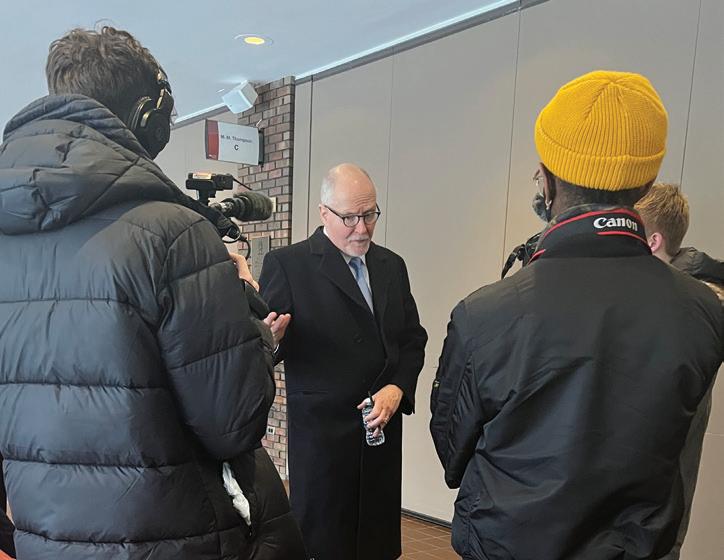
But according to the latest polls, Vallas has at least 22 percent of the vote, thanks to a strong showing on the north side. Several north-side alderpeople (Tom Tunney, Brian Hopkins, and Brendan Reilly) have endorsed him. Like they’re trying to catch up with their base.
I suspect part of the reason for Vallas’s
surge is voters have started to pay attention to the election long enough to realize he’s the only white guy running. Far different from 2019 when he was one of six white candidates, including Daley’s brother. It’s as though a collective light has gone on in the minds of white voters as they realize, “Oh, my goodness, we can take back City Hall!”
Now, I realize many white Vallas voters would vehemently deny race has anything to do with how they will vote.
In my experience, white people generally deny race has anything to do with anything they do. If I even suggest the possibility, I generally get one of the following responses: How dare you!
I’m color blind!
I voted for Obama!
And, of course, the perennial . . . Go live in Detroit!
I’m sure many of Vallas’s white supporters support him because they truly believe he’s the most qualified to run this city.
Of course, there’s always the possibility that they truly believe he’s the most qualified to run this city precisely because he’s white.
I call it the Monroe Anderson theory of why white Chicagoans often vote for white politicians and against Black ones. Anderson, a longtime Chicago journalist, refers to the “weaponization of whiteness—as they use skin color against us and for them.” If you want to hear Monroe expound on his thoughts, check out our conversation from my February 8 podcast.
All in all, this campaign is starting to remind me of the run-up to the aforementioned special elections of 1989, when so many white people were positively giddy about a Richard M. Daley victory.
Am I unfair? I know some of you will think so. But whenever I start to believe that Chicago really has moved to a new phase of tolerance, I remind myself that this is the city where Dr. Martin Luther King Jr. called for racial integration. And some white guys hit him in the head with a rock.
Sorry, Chicago. But given your history, it’s always a little tough for me to give you the benefit of the doubt. v @bennyjshow
In his new book,
By KERRY CARDOZAThere were 18 extreme weather events with losses in excess of $1 billion in the U.S. last year, according to the National Centers for Environmental Information. There was the heat dome in the southwest in September, which put more than 61 million people under extreme heat advisories and broke heat records in California. There were hurricanes Fiona and Ian in Florida, the latter of which brought an “unprecedented” 12-to-18 foot storm surge and record-high winds of 150 mph, ultimately leaving 4 million Floridians without power. There were flash floods in Kentucky and Missouri that displaced thousands, and closer to Chicago, there were three tornadoes and severe thunderstorms in the northern central U.S. in July, which caused an estimated $1.3 billion in damages.
Much of the discourse around climate change and the increasing frequency of extreme weather events is forward-looking, hypothetical, but as Jake Bittle makes clear in his excellent new book The Great Displacement: Climate Change and the Next American Migration, that future is already here. Bittle, a University of Chicago graduate who was formerly editor-in-chief of South Side Weekly, hones in on seven areas of the U.S. whose landscapes have already been dramatically reshaped by our changing climate—sometimes abruptly, sometimes gradually, over decades.
Part of his approach is driving home just how crucial it is to not only acknowledge the reality that climate change has already dealt us, but also to take much more proactive steps to build greater resiliency into our communities, ensuring that everyone has access to safe housing. As he writes, “By the end of the century, climate change will displace more people in the United States than moved during the Great Migration, uprooting millions of people in every region of the country.” Not to mention the climate migrants who will be coming to the U.S. from other countries, their homelands made uninhabitable by the outsized emissions
AUTHOR PHOTO BY JASMINE CLARKEof richer countries such as our own.
Bittle helps illuminate that reality by focusing on the individual experiences of folks living in places like Santa Rosa, California, where the 2017 Tubbs Fire incinerated more than 5,000 homes in a matter of hours, and Norfolk, Virginia, where the sea level has risen more than a foot since 1950 and “will rise at least another foot over the next twenty years, faster than almost anywhere else in the country.” The picture painted is bleak—not only because climate change and increasing bouts of extreme weather are making it clear that large swaths of the country will soon be more or less uninhabitable,but also because so much of our current policy seems to be ine ectual at best and actively harmful at worst.
For example, many of the Florida Keys, Bittle notes, could be underwater by the end of the century. But residents can’t expect any help from FEMA because “federal law does not recognize the slow rise of the oceans as an emergency like a hurricane or a wildfire.”
He discusses how, in California, the private insurance market and state laws have worked in tandem to worsen the housing shortage and allow people to rebuild their homes in unsafe places without adhering to stricter building codes. California prohibits insurance companies from “dropping customers in areas that had experienced wildfire in the past year,” so instead they might arbitrarily drop customers in the state who have not yet been a ected by fire, while simultaneously spiking the premiums of customers who were impacted.
THE GREAT DISPLACEMENT: CLIMATE CHANGE AND THE NEXT AMERICAN MIGRATION BY JAKE BITTLE

Simon & Schuster, hardcover, 368 pp., $28.99, simonandschuster.com
peared thanks to coastal erosion worsened by the oil industry, which dredged the swamp, and bought up and developed land, displacing residents. As the marshes disappeared, salt water crept into people’s land and housing, making it impossible to grow subsistence gardens or raise animals; ultimately it broke up the communities and destroyed their way of life. Isle de Jean Charles’s entire community was eventually relocated inland, the “first whole-community climate migration in the history of the United States.” (For a more recent example, I recommend reading the New Yorker’s article on the migration of the Inupiat island village of Kivalina, which is estimated to cost almost a million dollars per resident.)
In the Houston oil boom of the 1970s, massive development proceeded basically unchecked, as there were no zoning laws and few restrictions on permitting. Unfortunately the county had never conducted flood studies of the city’s bayous, so structures were often built downhill or very close to rivers, bayous, and reservoirs. That, coupled with the literal development itself, particularly the increase of paved surfaces, meant that there was lots of opportunity for flooding and little opportunity for natural drainage when Hurricane Harvey hit in 2017.
And in Arizona, the government allowed counties to draw so much water over the years that the water table has drastically depleted, creating fissures in the earth. In the mid-90s, the state created a new water authority to appease developers that e ectively functioned as a “giant loophole in the state’s groundwater restrictions,” passing the buck on finding a sustainable solution onto future generations.
Arizona, which has been in a drought since 1994, is now dealing with fewer allotments from the Colorado River, making farming and cattle raising all but impossible in Pinal County.
Bittle also draws attention to the fate of lower-income communities, which are oftentimes where Indigenous people or people of color live. They tend to be the most vulnerable to climate change and have the least ability to pack up and move somewhere safer. He writes about the Indigenous villages of Pointe-auChien and Isle de Jean Charles in Louisiana: the landmass of the latter had mostly disap-
If there is a drawback to The Great Displacement, it is in the desire for more information and, perhaps, a more critical lens. For all Bittle’s talk of FEMA, there is little mention of the historical allegations of racism or other gross negligence of the government agency that Americans rely on for disaster relief. From FEMA’s knowing distribution of trailers with unsafe levels of formaldehyde to Hurricane Katrina survivors to data that shows that the agency often helps white people and white communities more than people and communities of color, readers should perhaps be given this information as context for any future dealings they may have with the agency.
Similarly, Bittle summons a lot of hope in his final chapter, which posits what the future of climate migration might look like and discusses what changes must be made to make that migration less painful. He boldly notes that the widespread mobility will necessitate a change in the way Americans think of home, and as a result, the American dream, as well as our stubborn cultural belief in individual responsibility. In the coming years, he writes, it will only become more common to need help from the government, either for shelter or safety, and the onus is on us to come to terms with that vulnerability.
Though it’s certain that the climate is going to continue to warm and the oceans will continue to rise, much else remains unwritten. We have the power to build more a ordable, dense, climate-resilient housing, to learn to farm more sustainably, to transition to clean energy sources. And, as Bittle notes, the public largely supports such measures. It’s up to our government to make those investments and create such policies, but it’s up to everyone to make sure they do so. v
@booksnotboys
Jake Bittle makes it clear that climate change is already uprooting Americans.
HHH1/2
– Chicago Sun-Times




– Buzz Center Stage













NOW PLAYING THROUGH MARCH 19 615 W. Wellington Avenue (at Broadway), Chicago 773.281.8463 timelinetheatre.com

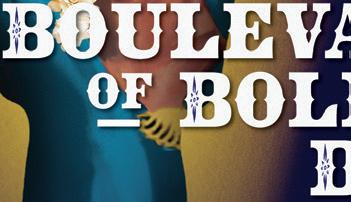
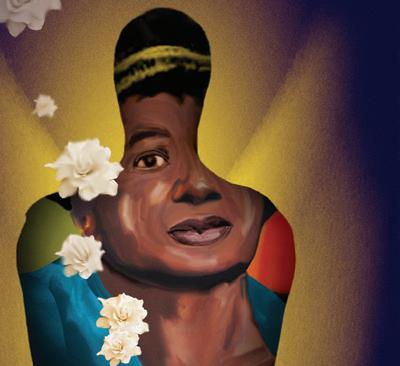
NOW PLAYING THROUGH MAR 11
By MAHOGANY L.BROWNE
Based on Her Book
Directed by ERICKA RATCLIFF
PRODUCTION SPONSORS
 BY MARTIN YOUSIF ZEBARI
BY MARTIN YOUSIF ZEBARI

A surprising new play about how families fall apart—and find each other again—amidst turbulent global and social change.


In 2003, newly-wed Layal and her family prepare to immigrate from Baghdad, Iraq, to a Chicago suburb. Seventeen years later, Layal’s life looks unimaginably different from what she had envisioned two decades prior, as she and her siblings explore queerness, face their grief, and discover what it takes to make home in a new place. Don’t miss the world premiere of this moving, powerful new play.
MARCH 3 – APRIL 2
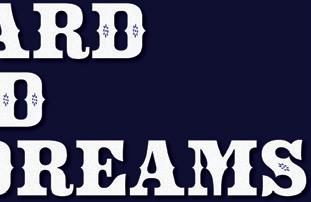

SPECIAL OFFER: Get $25 main floor seats through March 12* with code READER


*Not valid on previously purchased tickets or in combination with other offers.




312.443.3800 | GoodmanTheatre.org
312.443.3 800






Groups of 10+: Groups@GoodmanTheatre.org


“A POWERHOUSE , WORLD-PREMIERE STAGING”
“IT’S STANDING-OVATION STUFF. A MUST-SEE SHOW”A world premiere adaptation of Mahogany L. Browne’s popular young adult novel, Chlorine Sky is an intimate coming-of-age story told in verse about two girls who are best friends—until they aren’t. Sometimes, growing up means growing apart.
Rebecca Makkai’s new novel complicates our cultural obsession with true crime.
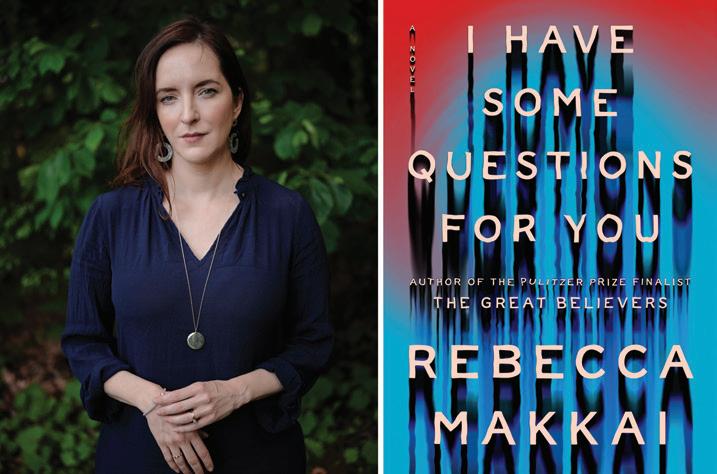 By JANET POTTER
By JANET POTTER
Rebecca Makkai lives at a boarding school where no one has ever been murdered. She wants to be clear on this point because her new novel is set at one where someone has. I Have Some Questions for You is about murder and memory and reconciling your past self with your adult one.
A native of Lake Bluff, Makkai lives at a boarding school, where her husband is on the faculty and where she attended high school. She is the author of the novels The Borrower and The Hundred-Year House , though it was her 2018 novel, The Great Believers, set among a community of gay men during the 1980s AIDS epidemic in Chicago, that put her on the map. It was an enormous critical and popular success and a finalist for the 2018 National Book Award and the 2019 Pulitzer Prize.
I spoke with Makkai in January and asked if a literary mystery was a deliberate departure from The Great Believers
“People took me very seriously with The Great Believers. My first two novels—people wouldn’t stop calling them romps. I was like,
what the fuck, there’s a lot of death in my second novel,” she says. “That freed me up a little bit with this one to lean into some elements that I might previously have worried would mean I wasn’t taken seriously, like this true-crime obsession that we all seem to be in the middle of right now, and writing from a first-person, female point of view, which I haven’t done since my first novel.”
I will not call I Have Some Questions for You a romp, but I will tell you that I finished it in two sittings, at one in the morning. It is about Bodie Kane, a successful podcaster who returns to teach a podcast workshop at Granby, the New England boarding school she attended. One of her students decides to produce a podcast about the campus murder of a former student who so happened to be Bodie’s former roommate.
Thalia Keith was murdered in March 1995, after a performance of the musical Camelot Her friends were drinking in the woods at the time, and her body was found in the athletic center pool, so suspicion quickly settled on an
athletic trainer, Omar, who had been working late in the building. Thalia’s friends and teachers were all questioned after her death but graduated and left the area before Omar’s trial and eventual conviction.
When the novel opens, in January 2018, Thalia’s case has become a pet project of Internet sleuths. She was, inevitably, popular and beautiful, and the Black man convicted of her murder was the immediate and only suspect because her friends said he was creepy and the police believed them. That, combined with DNA evidence that may or may not be reliable, and a VHS recording of Camelot taken hours before her death, provide endless fodder for true-crime enthusiasts to obsess over in Reddit threads and YouTube channels.
Bodie tells herself that her students’ project will never be heard outside their workshop. But inevitably the podcast uncovers new evidence that, wouldn’t you know, blows the case wide open.
The book is on one level a skillfully written murder mystery, replete with satisfying twists, red herrings, and eleventh-hour reveals. It is at the same time one layer removed from that genre, examining the true-crime phenomenon and whether it’s doing its subjects any good.
“What I was really interested in with this book was not just partaking in those tropes but also looking at the realities of the flip side, one of which is the way that the public fascination feels incredibly predatory to the people who are actually involved in the case,” Makkai says.
Although Bodie and Thalia had been roommates, they had not been friends. While Thalia had been a campus darling, Bodie was a goth who ran tech in the musicals and had few friends. Bodie was no one’s first choice to become Thalia’s avenging angel 23 years after her murder, least of all her family, friends, and ex-boyfriend, all of whom are drawn back into Thalia’s story, and what they remember about her and about that night.
On the other hand, Bodie remembers things. Things she thought little of at the time or trusted the adults around her to handle, which she now realizes might be the key to understanding Thalia’s last months, if not hours.
I Have Some Questions for You was written, and set, in the wake of the #MeToo movement. As Bodie says in the book, “We were, all of us, casting a sharp eye back on the men who’d hired us, mentored us, pulled us into coat closets.” She revisits her memories of Granby
R I HAVE SOME QUESTIONS FOR YOU BY
REBECCA MAKKAI Viking, hardcover,448 pp., $28,
penguinrandomhouse.comand Thalia with the maturity of the intervening years and the retroactive vocabulary the #MeToo movement gave to all of us. “I seethed at the realization that I had accepted this as normal, that I could only now calculate the full, ugly weight of it.”
Men she’d dismissed as harmless may have been hiding their predatory behavior in plain sight, and boys she’d dismissed as bullies may have been capable of extreme violence. And how much of the investigation into Thalia’s murder, and the narrative everyone quickly agreed on, was shaped by those men and those boys?
Bodie says, at one point, “I no longer had any sense of what was true.” And her former classmate wonders, “Maybe we shouldn’t have let, you know, a bunch of kids hand someone to the police.”
But relitigating the past, both literally and figuratively, is a murky business. The appeal of the true-crime genre is the supposed ability of a fresh perspective to mete out delayed justice—expose the evidence to the light of day, exonerate the wrongfully accused, and get the bad guy. When Bodie’s motivations for investigating Thalia’s murder are questioned, by others and by herself, that’s her indisputable reasoning—maybe we can know for sure what actually happened. Who actually did it?
In 1995, the case was driven by the collective narrative of Thalia’s friends, classmates, and teachers, each of whom brought their own set of biases and motivations. When the same group of people is asked to recall what happened 23 years later, they may be able to examine their memories more clearly, or they may simply filter them through a new era’s set of biases and motivations.
“That’s my job as a novelist,” Makkai says, “to complicate things, not simplify things. My job is to stir it up, mix it up, make you feel weird about it, complicate the notions you might have had.” Although an objective truth of what happened to Thalia exists, just as an objective version of every instance of violence or harassment exists, a web of competing narratives means that’s not always the story that gets told.
I Have Some Questions for You is not a straightforward murder mystery or a straightforward #MeToo story or a straightforward boarding school novel. It’s messier, more organic, and resistant to the tidy answers those genres aim for and is a triumph because of it. v
@sojanetpotter
R“FOR THOSE WITHOUT CHOICE”
Through 4/ 15 : Thu-Sat 11 AM- 5 PM, Weinberg/Newton Gallery, 688 N. Milwaukee, weinbergnewtongallery.com
Through 3/4: Thu-Sun noon- 5 PM, 2150 S. Canalport, 4A-3, womanmade.org
Stills from the breadbox video
Last summer the U.S. Supreme Court ruled that the Constitution does not confer a right to abortion, overturning previous decisions made in Roe v. Wade and Planned Parenthood v. Casey , in a case that is now ubiquitously known as the Dobbs decision. Choice and decision go hand in hand, but they are not the same thing. Choice is something that exists (or doesn’t). Decision is the action taken.
Two shows on view now, “For Those Without Choice” at Weinberg/Newton Gallery and “Roe 2.0–It Ain’t Over Yet!” at Woman Made Gallery, are processing, unraveling, and reacting to the Dobbs decision. The galleries’ stances are clear—the word “abortion” appears 38 times on Weinberg/Newton’s walls—but it is, unfortunately, defensive. They are trying to reverse a reversal.
Weinberg/Newton’s exhibitions begin by

partnering with a nonprofit organization. Those partnerships can lead to meetings, events, screenings, or full-scale shows. “For Those Without Choice” is presented in partnership with Planned Parenthood Illinois (PPIL), the result of a relationship with PPIL’s president and CEO, Jennifer Welch, that has been developing since 2018. According to Nabiha Khan-Giordano, director of Weinberg/Newton, the intention was to put on an exhibition “when the timing was right for both of us.” Needless to say, the Dobbs decision increased awareness and, therefore, perceived urgency about reproductive rights in America. In other words, the timing was right. But that’s not entirely fair. Yes, Dobbs marked a distinct moment in time when public sentiment (and donations) for protecting reproductive rights surged. But for many grassroots organizations, like the Chicago Abortion Fund and the Midwest Access Coalition, this
moment has been a long time coming. As Amy Littlefield wrote in the New York Times, “The missed opportunities have become painfully clear in retrospect, as many abortion-rights supporters have begun to take stock of just how much has been lost.”
Planned Parenthood is a massive organization, for better and for worse. In a time when the laws on one side of a border don’t match the laws on the other, national organizations like Planned Parenthood and the National Abortion Federation are locked in ambiguous legalities. It’s the smaller organizations that end up taking all of the risks. For example, as Sarah Leonard points out in Lux Magazine , “when the National Abortion Federation stopped funding in Kentucky fearing legal risks, the Chicago Abortion Fund sent $5,000 to a Kentucky abortion clinic, deciding that they were likely protected from repercussions.” She continues, “Giving to the small abortion funds that are willing to take these risks and help compensate for the loss of Southern and Midwestern funds can make a real di erence in patients’ lives.”
If we’re thinking about impact here—and we are—a piece called breadbox by artist Borealis at Woman Made Gallery is the absolute star of the show. Not only is the piece aesthetically interesting, it comes with donation-based goodie bags full of informational zines, talk lines, local funding options, and even a pregnancy test. The installation is part of a network of bread boxes, all of which distribute regionally-specific abortion care information. Breadbox is a necessary reminder that impact isn’t gauged by the biggest, shiniest object in the room. Local, direct action is available too. As Pamela Merritt, the executive director of Medical Students for Choice, said to Lux Magazine , “Too much of the history of abortion and family planning access is being written as if the court gave it to us and that’s just not true. There was movement organizing and direct action happening all over the place.”
Aesthetically, the two shows have some obvious di erences. Weinberg/Newton’s welllit walls are drenched in pink, red, black, and gold. Collectively, the works shirk subtlety for bold lines and bright colors. Woman Made Gallery’s show is, well, bloodier. But because of their common opposition, the art across both galleries shares a couple of key themes, which I’ve loosely divided into “consequences” and “control.”
What I’ll call the consequence collection deals with the physical, financial, and emotional aftermath of giving or not giving birth.
Us , a stunning black-and-white photograph by Marzena Abrahamik at Weinberg/Newton, shows happy messy motherhood, while a couple of paces away, Udita Upadhyaya’s three-page letter, From an Abortion Doula , details the immeasurable sacrifice, shame, and grief that an unknown abortion-seeker faces. At Woman Made Gallery, Frederica Diane Hu ’s crayon portrait of a woman gazing out from beneath a pile of floppy, crawling, crying babies needs little explanation, but her title, Biological Bondage, says it all anyway. These consequence-based pieces pull on the viewer’s heartstrings. But the point of the exhibitions isn’t simply to unravel, they are also meant to outrage. In Majority Opinion (Presented from the Majority Perspective) at Weinberg/Newton, artists Maria Robinson and Sayward Schoonmaker read the Dobbs v. Jackson majority opinion, written by Justice Samuel Alito, to a camera. They only voice the parts of the 209-page document that cite a woman. The result is a quiet flipping of pages, punctuated by the very occasional phrase. A redacted transcript is printed for the viewer to flip through, a heap of ink-heavy pages. At Woman Made Gallery, Heather Schulte’s CtrlAlt-Del also deals in words and redactions, using needlepoint on a newspaper article to expose the power of language—specifically media language, in this poignant case—in creating and perpetuating oppression.
Amid the outrage are glimmers of wit and irony. The Guerrilla Girls BroadBand’s The Advantages of No Choice Whatsoever declares tongue-in-cheek victories of the Dobbs decision. Among them are “Postponing your career ambitions indefinitely,” “rediscovering the thrills of back alley abortions,” and “finding more children available on the black market.” Throughout both exhibitions, there is ample needlepoint and glitter and shiny pleather handbags, an accumulation of subverted symbols of domesticity, each one flashing a defiant message of independence.
As haunting or witty or outrageous or delicate as I found many of the artworks, I kept coming back to breadbox—its clear call to action, its unambiguous benefactors, its immediacy. Because while the rhetoric of this issue emphasizes choice, we need to remember that everything is a decision. To be a parent, to not be a parent, to not be a parent yet . To view an artwork, to show an artist, to act in defense rather than offense. Everything is a decision. v
The Chicago artist’s long-awaited solo show at the Elmhurst Art Museum

Before you even step inside the museum, you are greeted outside by a Bird City Saint vinyl—the artist’s signature character. Walking into the first gallery, I see a giant wooden sculpture filled with congratulations written in red and black ink from various folks from the opening. Although signing the wall or pieces during an opening is not unheard of, this feels different. Joseph Perez, otherwise known as Sentrock, is more than his art, and this exhibition and many of the pieces, including this one, are here to show it. Loved ones, students, and supporters are not only brought in to view the new works but become part of the exhibition themselves through these means.
In the next gallery, I come across a child pressing a button, making the room light up all the objects inside. Going forward, I come to the biggest part of the exhibition. A giant Bird City Saint statue lays in a pile of grass, with a low-rider bike on the le side and a paletero cart adorned in his style and flowers on the right. As I go around, I can’t help but remember all the summers I had growing up in Pilsen and Chicago’s south side in general. Sentrock, who started out writing graffiti, takes pride in his Mexican American culture and brings in cultural motifs in the new canvases created and sculptures. We are seeing Bird City Saint, just like his creator, take off Sobre todo, siguió volando Aquí está, entre la cuidad Entre las caras de los niños Y los corazones de todos ¿Lo puedes ver? ¿Lo puedes encontrar? —CRISTOBAL ALDAY “SENTROCK: THE BOY WHO WANTED TO FLY” Through 2/12: Wed-Thu noon-5 PM, Fri-Sun 11 AM-5 PM, Elmhurst Art Museum, 150 Cottage Hill, Elmhurst, elmhurstartmuseum.org, general admission
$5-$18
The gallery celebrates the most foundational of art forms.
Drawing is a foundational art form, which may make it one of the most difficult to exhibit. The line between a schematic and a doodle and a cohesive final product can be, well, sketchy. Some of the pieces in Western Exhibition’s second “Drawing Biennial” are keenly aware of this flexibility and use it to their advantage. Journie Cirdain’s Seattle to Salem straps viewers in for a road trip of a drawing (or, according to the artist, a drawing of a road trip). It’s the wondering and wandering of place a er place, elevated backseat doodling lushly executed. Other works recall the uncomplicated allure of drawing through their materials—Jenny Crowe’s ballpoint pens and magic marker, Cathrine Whited’s colored pencils.
Though nostalgia is tempting, there is too much skill here to reduce these pieces to back-of-the-classroom binder paper. From Ryan Travis Christian’s haunting graphite Going Back to the EU to Geoffrey Todd Smith’s intoxicating zig-zags, the show can’t be pinned by adjectives.
For every tightly controlled detail (Robyn O’Neil’s microscopic animal drawings) there is a loose flash of the hand (Lilli Carré’s inky root vegetables). For every faint sketch, a bold blotch. There are drawings on canvas
and paper and panel, drawings on concrete, drawings on the floor. Maybe what this exhibition does best is demonstrate that the way to present a cohesive set of drawings is to forgo any attempt at cohesion at all. With such a talented cadre of artists, this show is all the better for it. — PARKER YAMASAKI “THE 2023 WESTERN EXHIBITIONS DRAWING BIENNIAL” Through 2/25: Tue-Sat 11 AM-6 PM, Western Exhibitions, 1709 W. Chicago, 312-480-8390, westernexhibitions.com
Carrie Cook’s paintings are a tangle of abstraction and representation.
Combining nocturnal hues with cinematic composition and a de touch, LA-based artist Carrie Cook makes paintings that will change the way you see the glass in your hand. Her latest solo show, “Second Chakra” at Goldfinch, is a seven-piece celebration of everyday things, both in their superficial appearance and their symbolic significance. These aren’t flashy, fluorescent eye candies indebted to the Instagram era. They’re quiescent, satin-sheened meditations on life. In short, they’re paintings doing what painting does best.
Have a look at the mysterious blue-green Two Plates, Two Cups. Half-hidden in twilight, it comes across as a straightforward scene of fruit-filled saucers and wine-stained tumblers. An unremarkable slice of life that anyone who’s ever had a Cutie and a cheap bottle of Carlo Rossi can relate to. But in Cook’s hands, these are objects possessed. Hanging bizarrely in midair, they cast colored shadows, spinning and pulsating with an otherworldly, expressionistic quality. Suddenly, viewers find themselves confronted by a phantom image in the heart of the uncanny valley. Throughout the show, Cook conjures abstract contours from realistic shapes, pushing visual and psychological tensions to a rolling boil. And just as quickly, she brings us back to the kitchen table, bottle in hand, glass at the ready.— ALAN POCARO
“SEC0ND CHAKRA” Through 2/25: Fri-Sat noon-4 PM, Goldfinch, 319 N. Albany, goldfinch-gallery.com
In this solo exhibition, Maggie Crowley si s through her past.
As a writer and unflinching disciple of the truth that art will make your life better, I think a lot about contrasts. Binaries and opposites, polarities and spectrums. In both art and the culture that nourishes it, the animating force is always a unique ability to sustain the maximum amount of difference while avoiding catastrophic disintegration. It’s a fine needle to thread.
It’s precisely this kind of balancing act that figures so deeply in Maggie Crowley’s exquisitely subtle new show, “Comb,” at Devening Projects. A scavenger hunt through time and space, the Chicago-based artist surveys the broad ideological landscape of masculine and feminine labor, creating personal paintings and sculptures alive with juxtapositions of pliant silk and unyielding steel. Look closely and you will piece together the disparate artifacts of a life lived.
In the large-scale Crashing into the mountain, we uncover a stamp-sized depiction of Mickey Mouse, a ghostly, oversized chainsaw blade, and a hail of orange disposable earplugs. Suspended from a rod of angle iron, the gouache-stained silk is creased across the center by a freestanding armature. This isn’t a formally seductive object in a traditional sense. It looks worn and
broken in—maybe broken down—but its somber hues and fragmented imagery are beautiful in their honesty. Crowley is si ing through her past and inviting us to do the same.— ALAN POCARO “COMB” Through 3/4: Sat noon-5 PM and by appointment, Devening Projects, 3039 W. Carroll, deveningprojects.com

Two painters’ differences bring out the best in each other.
Contemporary painting is vast terrain. Its broad, shimmering beauty and stylistic scope eludes easy classification. In spite of digital reproduction’s awesome omnipresence and the mobile Internet’s unrestrained reach, a comprehensive view will forever exceed our vision. While we can’t see or speak of linear movements, we can still witness formal affinities and visit thematic encampments. A particularly luminous settlement is currently located at Andrew Rafacz gallery.
An ideal survey of clear color and crisp form, Cody Hudson and Richard Colman’s untitled two-person

pairing demonstrates the wide visual range that similar technical approaches to paint (hard edges, flat shapes) can materialize. The show, without a heady statement to digest, is unabashedly fun, bright, and sweetly satisfying to look at. You won’t be asked to plumb the depths of your soul or square yourself with the inherent contradictions of a late-capitalist lifestyle to appreciate these paintings.
Where Hudson’s Matisse-inspired work is playfully abstract and locally made, Colman’s is figurative, more rigorously composed, and from the west coast. Their differences bring out the best in each other. Compare how the hieroglyphic characters in works such as Colman’s Hand Picked tend to draw out the representational elements in Hudson’s more floral abstraction. While both artists effectively use black as a color, Colman’s wider range and pops of sizzling fluorescent hues are more surprising than Hudson’s narrower, more controlled palette. Effortlessly enjoyable and as welcome as a sunny day in February, this show is a bright spot on the contemporary map. —ALAN POCARO CODY HUDSON + RICHARD COLMAN Through 4/1: Tue-Fri 10 AM-5 PM, Sat 11 AM-5 PM Andrew Rafacz, 1749 W. Chicago, andrewrafacz.com/exhibitions
There are not many names more Irish than Shannon O’Neill. “I’m like the John Smith of Ireland,” O’Neill quips. So it only makes sense that the sixth-generation Irish American (whose people fled the Emerald Isle in the 1840s during the potato famine) “fell in love with being Irish at a very early age.”
As a kid she got books about Ireland, filled with stories and pictures of the verdant landscape and its many ancient artifacts—the
towers and crumbling walls, the abandoned farms, the Cli s of Moher, the Blarney Stone, the sweet winding River Shannon. In college she hung images of Ireland from an outdated calendar by her dorm room bed, turning them 90 degrees vertically so that when she put her head on her pillow she could gaze at “these gorgeous landscapes” while she fell asleep.
The latest play by the Chicago-based playwright (and co-artistic director of the Factory
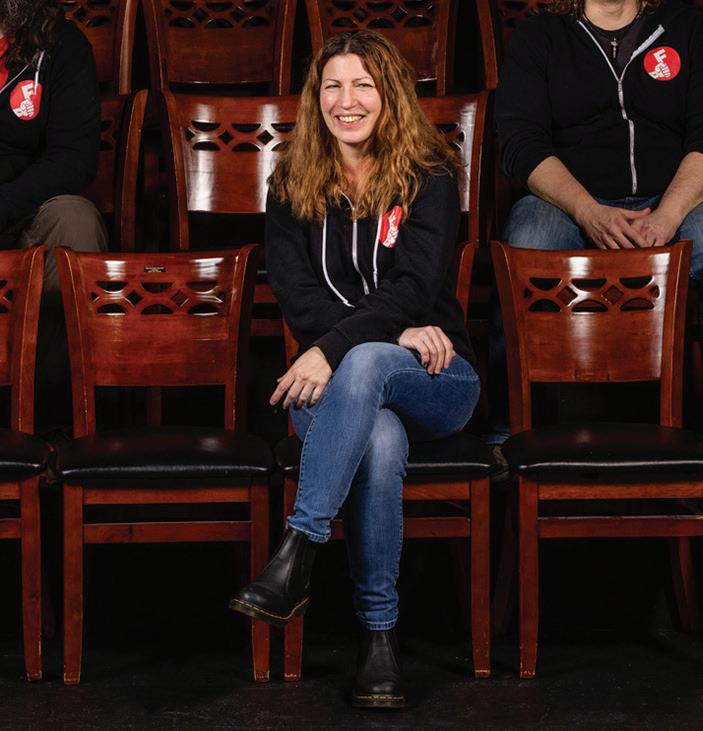 Shannon O’Neill CHRIS GUILLEN
Shannon O’Neill CHRIS GUILLEN
Theater) is about Ireland, specifically a pair of sisters who become deeply enmeshed in the dark, violent world of the Provisional Irish Republican Army. It’s inspired by the real-life story of Dolours and Marian Price, who both joined the Provisional IRA in the early 70s.
O’Neill became interested in the Price sisters in 2013 when “a friend texted me an article about Dolours Price.” Dolours notoriously was a member of an elite group within the
Through 4/1: Fri-Sat 8 PM, Sun 3 PM; also Thu 3/23 and 3/30 8 PM; Factory Theater, 1623 W. Howard, 312-275 - 5757, thefactorytheater.com, $25
IRA called “The Unknowns,” which conducted clandestine operations, including the kidnapping and killing of people accused of being traitors to the cause. (Dolours revealed her involvement in interviews that were not published until her death in January 2013.) O’Neill admits, “[Dolours’s] story was fascinating to me.” O’Neill was also interested in the relationship between the sisters and how it “could coexist amongst this backdrop of conflict.”
O’Neill was not a child of conflict. She grew up in the peaceful college town of Carbondale, Illinois. She came to Chicago to study at Columbia College in the 1990s and never went back. “I really liked the velocity of Chicago. I liked taking the el everywhere and exploring.” While she was at Columbia, she met actors associated with the Factory Theater and started hanging with them. She was eventually asked to fill in when actors could not do a show. In 2004 she was invited to become an ensemble member of The Factory.
The Kelly Girls is the third play O’Neill has written for the theater. Her first was 2010’s Jenny and Jenni , a comedy about a pair of women who may or may not have been the actual inventors of the kind of dance workouts popularized by Jane Fonda. “It was a very kind of loving story about their challenges and their brink of fame.”
Her second play was a serious drama, 2019’s May the Road Rise Up, based on the story of Sean Smith and Lee Smith. Sean, at ten, accidentally killed his eight-year-old sister, Lee, shooting her with a gun they found hidden in their parents’ dresser. Sean did not know the gun was loaded when he pulled the trigger.
O’Neill heard about the Smith family trag-
edy on an episode of StoryCorps on NPR’s Morning Edition and could not get Sean and Lee’s story out of her head. “How did this accident a ect Sean?” she wondered. “How could his family move on from such a tragedy? How does a family deal with their guilt?” O’Neill also asked, “Who do they blame? How do you blame a kid?” She set her play ten years after the shooting to answer these questions. May the Road Rise Up received a non-Equity Jeff Award nomination for best new work.
O’Neill had started working on The Kelly Girls at the same time as May the Road Rise Up . But May the Road Rise Up came more quickly. O’Neill says all of her plays “have a life of their own.” And they unfold at their own paces. O’Neill had to push pause on The Kelly Girls to finish work on May the Road Rise Up But it did not remain long on the back burner. When work was completed on May the Road Rise Up, she went back to The Kelly Girls.
As in May the Road Rise Up, O’Neill decided to diverge from the facts of the actual case—in part because some of the people involved in the Price sisters’ stories are still alive. But fictionalizing the story also freed her from the facts and gave her freedom to explore how the violence of the Troubles “seep[s] into their family dynamic.”
“We begin in 1967, and we end in 1980. It is a bit of a journey in terms of their lives. So you see a little bit of their lives before joining the IRA. You see their family dynamic.”
“And it’s a really tricky line. [ The Kelly Girls is] not a historical drama. I’ve used my creative license. But I’ve tried to keep the milestones for some of these really significant happenings and moments throughout.”
Just as it did in May the Road Rise Up , O’Neill found that the real-life story provided a springboard for dramatically compelling questions.
“How does a family who’s engrossed in IRA activities talk at dinner time? What is their conversation about? Did they talk about politics? With the whirling violence that’s happening around them in Northern Ireland, how can you ignore it? What does [the violence] do psychologically to you as an individual? And also where do your beliefs start to change and it becomes unclear what you’re fighting for?”
@JackHelbig
FEN
Through 3/5 : Wed-Fri 7:30 PM, Sat-Sun 2 and 7:30 PM; audio description and touch tour Sat 3/42 PM (touch tour at 12:30 PM), open captions Sun 3/52 PM, ASL interpretation Sun 3/57: 30 PM; Court Theatre, 5535 S. Ellis, 773 -753 - 4472 , courttheatre.org, $ 40 50 -$ 82
 By IRENE HSIAO
By IRENE HSIAO
No wings close the expanse of earth that widens the Court Theatre stage to a landscape in Caryl Churchill’s Fen , directed by Vanessa Stalling, with scenic design by Collette Pollard. The terraced land, hemmed in scalloped edges by shining metal borders, looks like the ocean, diminished and immobilized in its crash against the massive concrete edifice that looms over it. The colors are grim and muted; the pungent smell of earth—the smell of birth, the smell of death— penetrates the space.
The dust from this earth rises in plumes thick enough to sting your eyes and make you cough. Perhaps this is an inaccuracy to what by name ought to be a marshland—yet the proximity to other narratives of labor and the persistent visual of dust that just won’t settle works next to the monumental gray of the building, ugly as a factory.
The play begins with a sound, an eerie keening that combines the call of crows with voices crying, shouting, and chanting, weaving together the sound of predation, su ering, and song. The landscape below is dark; a light shines from beyond a door placed high on the facade.
On “the most expensive earth in England” labor unfortunate women: Val (Cruz Gonzalez-Cadel), Angela (Morgan Lavenstein), Shirley (Genevieve VenJohnson), and Nell (Elizabeth Laidlaw), watched over by gangmaster Mrs. Hassett (Lizzie Bourne) and joined by the occasional man (Alex Goodrich). They work on their knees, hands searching the soil for some small potato, rain or shine. The women are “better workers than men,” says farmer Mr. Tewson (Goodrich). “I’ve seen women working in my fields with icicles on their faces. I admire that.”
The icicles are among the lesser pains in Fen , in which the organizing principle of society is exploitation—of the land that has been drained for agriculture and of the laborers who work the land, of and by the farmers who own the land, by the government that taxes the land, and by the businesses who have devised means of measuring the land in money. Beneath the systemic cycles of abuse, individuals find their own expressions of cruelty, whether it’s Angela’s casual brutality to her stepdaughter Becky (Bourne), whose hair she yanks, whose body she beats, and whose poems she derides, or the village children’s mockery of Nell, whom they have decided is a witch or a “morphrodite”—probably both.
Means of escape are few and mostly futile. The children dream of becoming nurses and hairdressers, “but I never want to leave the village,” they say—and they never will. Alice (Bourne) finds solace in Jesus, but Val would rather take Valium. Val, who is married with children, is in love with fellow laborer Frank (Goodrich), a fact that seems as incomprehensible and inane to the others as it is impossible to resolve between them—Val first decides to leave her children to live with Frank, then can’t bear to be apart from them. “One of us had better die,” she says to him one night in their o -again, on-again, torrid, tormenting, and deeply banal romance.
But even death brings no respite from the misery of the fens. “We are starving, we will stand this no longer,” shouts a ghost (Gonzalez-Cadel) to Mr. Tewson, who has carried her rage for a century and a half and still hoes the field with unabated fury in the afterlife. (Tewson: “Are you angry because I’m selling the farm?” Ghost: “What di erence will it make?” Tewson: “None, none, everything will go on the same.” Ghost: “That’s why I’m angry.”)
“I have to make something happen,” says Angela to Becky, in a confession in a dream that explains the perpetuation of trauma upon trauma so logically it must be true: “I can hurt you, can’t I? You feel it, don’t you? Let me burn you. I have to hurt you worse. I think I can feel something. It’s my own pain.” “My grandmother told me her grandmother said when times were bad they’d mutilate the cattle,” adds Shirley, whose family adds another generation to endure the punishment of impoverished existence every 16 years. In this universe of privation, where birth, love, death, drugs, and Jesus can bring no redemption, why go on? Some attempt suicide. Some succeed.
And yet, despite the dust and dark, there are brief moments of connection and community. Six-year-old Shona shares jokes with her mother Val, which are more fun for her pleasure than their novelty. Angela and Becky compose a poem together—it’s a mean one,
but they prove they can. Throughout the play the women sing, sometimes alone but best of all together, creating temporary harmonies, a loveliness seemingly from nothing, breathed, voiced, created, experienced, then gone, a vibration that passes through like a ghost of a hope that can’t quite exist in this universe yet somehow does.
With more than 20 characters played by six actors in succinct episodes, Fen does not yield its stories easily—you have to scrabble after them and be content to let some of the details get lost in the sameness of the landscape. This production’s intervention to make them more legible by using uppercase supertitles naming the characters feels a tad heavy-handed, particularly when the ensemble is so strong. And if they blend, that mingling of persons reflects Churchill’s research process with the Joint Stock Theatre Company of compositing voices from the Fens in eastern England.
“ Fen is a play with more direct quotes of things people said to us than any other I’ve written,” wrote Churchill in her 1983 introduction. “It’s a play where I have a particularly lively sense of how much it owes to other people.” To hear their voices 40 years on is to wonder how much has changed for them—and us. v
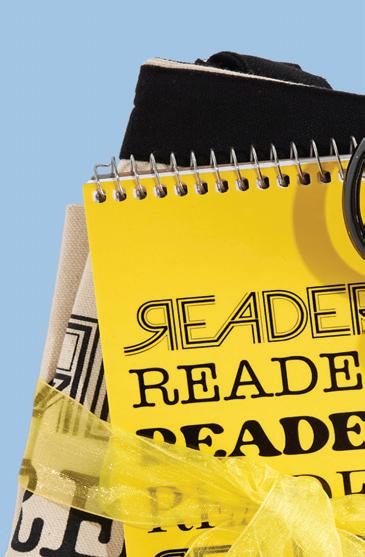





















Kim), and vibrant clear-sky lighting (Conchita Avitia, K Story), but also in the depicted heightened emotional frequencies that come with being a teen. In her Steppenwolf debut, Akili Ni Mali leans into both the outward social naivete and quiet inner maturity of Sky as she goes about trying to reclaim the attention of her former bestie, Lay Li (Destini Huston), who is splintering off on her own identity journey.
The chic concrete pool setting does create the unfortunate blocking restriction of having much of the most intimate and personal action happen upstage along the periphery, but that’s only a minor limitation to an otherwise kinetic and thoughtful adaptation. And the ultimate takeaway about women looking out for women—friends or not—goes down as sweet and satisfying as a Capri Sun. —DAN JAKES CHLORINE SKY
Through 3/11: Sat 3 and 8 PM; also Fri 2/24 8 PM; relaxed sensory-friendly performance Sat 2/25 3 PM, Spanish captions Sat 3/4 3 PM, audio description and touch tour Sat 3/4 3 PM (touch tour 1:30 PM), open captions Sat 3/4 8 PM, ASL interpretation Sat 3/11 3 PM; Steppenwolf Theatre, 1650 N. Halsted, 312-335-1650, steppenwolf.org, $20 ($5 students)
Actors Gymnasium gives a circus twist to Cervantes.
who has been serenading him and saving him from true danger all along. —KIMZYN CAMPBELL CIRCUS QUIXOTIC Through 3/26: Sat 4:30 and 7:30 PM, Sun 3 PM, Noyes Cultural Arts Center, 927 Noyes, Evanston, actorsgymnasium.org, $20-$45
Lifeline’s Extra Yarn is an enchanting family show.
Charles Dickens’s schoolmaster Mr. Gradgrind from Hard Times (he who insists, “Now, what I want is Facts. Teach these boys and girls nothing but Facts”) would feel right at home in the grim factory town run by a petulant archduke in Mac Barnett’s 2012 children’s book Extra Yarn. There, young Annabelle and her schoolmates are taught, like their parents before them who now labor on the assembly line making tchotchkes for the archduke’s company, that “people who make mistakes deserve nothing.”
Remy Bumppo’s Anna in the Tropics is a scorcher of a show.
Nilo Cruz’s 2003 Pulitzer Prize-winning Anna in the Tropics is a lit-fuse kind of drama, beginning with a slow but unmistakable simmer that ultimately detonates with scorching, devastating impact. Directed by Laura Alcalá Baker for Remy Bumppo Theatre, this lavishly produced, powerfully cast production shows just how relevant—and compelling—Cruz’s words remain.
On the one hand, Cruz has penned a fascinating, heartfelt historical drama detailing the vibrant culture of Cuban cigar-making that thrived through the 1930s in and around Ybor City and Tampa, Florida. The wire-taut drama is set over the summer of 1929 in a family-owned cigar factory in Ybor City (population roughly 70,000 at its height) with many of its residents either emigres from Cuba or their descendants. As per tradition in Cuban cigar factories for centuries, lectors were o en brought in to read to the workers as they carefully worked the tobacco leaves.
It’s a lector that sets Anna in the Tropics in motion, a man who arrives by ship, dashing as a movie star and bearing a copy of Anna Karenina
Through the lens of Tolstoy, Cruz cra s a steamy romance as well as an explicit, unblinking look at gender dynamics in the factory. As they are in Anna Karenina, those dynamics are sometimes deeply erotic and sometimes horrifyingly, tragically misogynistic.
The cast is an ensemble of powerhouses, anchored
by Charín Álvarez (who was also in Chicago’s original production of Anna in the Tropics at Victory Gardens) as the matriarch who holds things down.
Lauren Nichols’s expansively detailed set recreates a factory replete with a high, wooden-beam ceiling and towers of crates, barrels, and cigar boxes piled high.
—CATEY SULLIVAN ANNA IN THE TROPICS Through
3/19: Thu-Fri 7:30 PM, Sat 2:30 and 7:30 PM, Sun
2:30 PM; also Thu 3/16 2:30 PM; no show Sat 3/18
2:30 PM; audio description and touch tour Sat 2/25
2:30 PM (tour starts 1 PM), open captions Sat 3/4
2:30 PM; Theater Wit, 1229 W. Belmont, remybumppo.org, $36-$50 (industry $15, students $10)
Chlorine Sky traces the anguish of a friend breakup.
Ask any middle-aged person about their first romantic breakup, and there’s a good chance they’ll laugh. Ask about their first friend breakup, on the other hand: no laughter. Director Ericka Ratcliff ’s Steppenwolf for Young Adults stage adaptation of Mahogany L. Browne’s 2021 novel-in-verse Chlorine Sky uses the dissolution of a relationship between two high school students as a jumping point for a reflection on growing pains, self-discovery, and navigating life in the precarious limbo between childhood and young adulthood.
References to the sun are frequent throughout Browne’s prose, and its glow serves as an effective thematic and stylistic inspiration for Ratcliff ’s production in a few ways. First, literally, in its colorful Y2K mid-aughts, Phat Farm and Juicy Couture costuming (Jos N. Banks), bright SoCal pool and basketball court setting (Yeaji
Circus Quixotic, the winter circus production at The Actors Gymnasium, flips the story of Don Quixote into a modern retelling. Through metaphor and audience asides from the actors, director and adapter duo David and Kerry Catlin condense Miguel de Cervantes’s 1,072page tome of misadventures into a family-friendly chunk of mayhem featuring the title character and his sidekick Sancho Panza. We know the plot perhaps too well. Over and over, Quixote’s preposterous assumptions get him into pickles yet leave him undaunted as he doles out chivalric justice. Meanwhile there is shadow play, sheep battles, and waving windmills, while sappy jokes abound.
In The Actors Gymnasium’s style, the story is intertwined with circus. Solos and duos are performed by the cast while supporting roles and group circus acts are performed by the teen ensemble, a group with well-rounded circus skills ranging from ground acts (tumbling, unicycle, juggling) to aerial acts (silks, straps). Michel Rodriguez Cintra plays the charming yet fickle Don Quixote with Amanda Raquel Martinez as his patient, steady companion Sancho.
In a sweet moment, Martinez’s Sancho plays the ukulele and sings, “Oh be noble my Knight, slay for the day until all is OK,” while floating above on a lyra, accompanied by her donkey on violin. Other standout moments include the Chinese pole/tree climbing competition between Quixote and his shadow (played by audience plant Ryan Huemmer) and a duo aerial act between the duke and duchess (Danielle Gennaoui and Julian Hester).
The supporting cast provides comic relief to counterbalance Quixote’s delusions, making for an enjoyable plot tempo. Some nods to modern times in the script provide light moments while ensuring that the performers recognize the problematic aspects of the original tale—namely, patriarchy is called out—and “gender is a construct” is stated early when a sexist line arises, returning at the end when Quixote finally recognizes that his trusty friend Sancho is really Sancha, the one
But when Annabelle discovers a magical box of never-ending yarn and begins knitting sweaters and assorted other things for everyone in the town, something shi s. Her handmade goods aren’t “perfect,” but they’re so and warm and bring such joy that eventually even the archduke wants in on the magic yarn action. But as we learn in Lifeline’s wise and warmhearted world premiere musical adaptation, the real magic comes from accepting our own imperfections and those of the people around us and building mutual aid networks to help weather our shortcomings.
Jessica Wright Buha’s script, featuring a charming score by John Szymanski, unfolds in a swi and engaging hour under Anthony Kayer’s direction, with a nimble cast of four playing several roles (except for Shea Lee, who shines as Annabelle). Amanda de la Guardia as Annabelle’s newly radicalized mom who goes on strike, Calvin Adams as the whiny archduke, and Bradley Halverson as the schoolmaster who learns some things from his students, all make Extra Yarn an enchanting tale and a smart way to teach us all that mistakes are how we learn. And if that’s not enough, there’s also a cute dog puppet (designed by Noah Ginex), too. It may not be a perfect show, but it’s darn close. —KERRY REID EXTRA YARN Through 3/19: Sat-Sun 11 AM and 1 PM; open captions Sat 2/25 11 AM and 1 PM, audio description and touch tour Sat 3/4 11 AM (touch tour 9:30 AM), sensory-friendly performance Sun 3/11 11 AM; Lifeline Theatre, 6912 N. Glenwood, 773-761-4477, lifelinetheatre.com, $20
The David Bowie-inspired phenomenon finally returns.
Alex Grelle and Jesse Morgan Young’s Floor Show premiered in a brief electric run in February 2020 at the Chopin. The plan was to bring it back later that spring. But then . . . you know.
Blessedly, this compelling exploration/channeling of the chameleonic (and always self-aware) spirit of David Bowie—to call it a “tribute show” is far too reductive—has finally found its way back to the Chopin basement. The space has been transformed by set designer John Holt into a fashion-show runway somewhat reminiscent of Bowie’s video for “Boys Keep Swinging,” with a window at one end through which we can see performers at a makeup table preparing for their next incarnation.

Archival video projections designed by Sid Branca, along with live-action feeds during the show, add further layers of nuance to the themes of transformation and self-representation.
Grelle (aka “Grelley”) anchors the two-act, 16-song quicksilver extravaganza, but just as Bowie was a singular star who was smart and generous about his collaborators, so too does Grelle know how to cede the spotlight to his costars. These include Andrew Sa, who partners with Grelle in a delightful plot-twist shi into Judy Garland and Liza Minnelli performing a Bowie medley; the kinetic and magnetic “Diamond Dogs” (Sarah Ellen Miller and Robin Lee), who provide everything from dance support, midshow costume changes (designed by Kate Setzer Kamphausen), and mirror images/counterpoints to the onstage action; and Adrian Hadlock and Aileen May in a variety of brief but compelling roles. (The latter appears as Angela Bowie at one point.)
Costumes, wigs, and props get pulled from trap doors in the stage (including a skull reminiscent of John Merrick, the “Elephant Man,” played by Bowie in the play of the same title at the old Blackstone in Chicago). The band, led by Liam Kazar of Marrow with singers Bran Moorhead and Teressa LaGamba, moves with lightning skill through all the moods of the songs, while the choreography by Zachary Whittenburg and Erin Kilmurray physicalizes and exteriorizes what it feels like to be constantly in search of the next transformative (if not revelatory) moment. It’s truly exhilarating. —KERRY
REID FLOOR SHOW Through 3/5: Thu-Sat 9 PM, Sun 7 PM, Chopin Theatre, 1543 W. Division, chopintheatre.com, $35
Indoor Cats looks at Gen Z as domesticated felines.
Wax nostalgic for the pandemic shutdown as Red Theater presents the world premiere of Indoor Cats by Mora V. Harris, directed by Wyatt Kent. Meet Jules (Karylin Veres), an entitled, selfish twentysomething “artiste” whose fellowship gets canceled, leaving her to endure the early days of COVID at her parents’ second home, a cottage in the woods. Her pregnant sister, Willa (Julia Rowley), checks in on her distressed sibling, who is set on making stop-motion animation videos. When Jules meets her outdoorsy neighbor, Pete (Ian Maryfield), who makes bird videos for cats, the two hit it off. All the while, Jules’s cat, Panda (Sarah Wisterman), darts in and out with the preternatural wisdom of animal activity around the globe and the occasional deep insight. Somewhere there is a more satisfying and engaging play featuring Pete and Panda, who Maryfield and Wisterman respectively play with immediacy, energy, and spot-on comedic timing. They’re both positively delightful to watch on stage. Harris’s play, though, centers more on Jules, whose selfishness gets exhausting as she never changes or develops. Indoor Cats presents characters with potential but gets bogged down in being too plot-driven with manufactured emotions and unearned conflicts. There are great lines and insights that call for a pause or breath from the actors to help them land. It seems Harris is implying that some young people are much like indoor cats, suffering the privilege of being more comfortable at home, moody, and unprepared to survive the outside world. Which is kind of sad. —JOSH
FLANDERS INDOOR CATS Through 3/12: Thu-Sat 7:30
PM, Sun 3 PM; also Mon 2/27 and 3/6 and Wed 3/8 7:30 PM; The Edge Off-Broadway, 1133 W. Catalpa, redtheater.org, $20 ($40 “pay it forward”)
A new musical from the Impostors combines dystopia with whimsy.
Dominick Alesia’s original musical, now in a world premiere with the Impostors under Stefan Roseen’s direction, follows a young girl, Amelia, as she searches through a country shattered by war for Miranda, the older sister she never knew she had. Along the way, much like Dorothy and Alice, she encounters helpmates who are on their own quest, and odd-duck opponents who throw obstacles in her way.
If dystopian whimsy is a thing, then Alesia’s show nails it. It does spin its narrative wheels a tad in the second act, where commitment to some comic bits gets in the way of the unfolding emotional arc. But overall Miranda: A War-Torn Fable contains bittersweet insight into what “home” and “family” actually mean, especially in a world destroyed by humans bent on tearing everything down. Carter Rose Sherman’s Amelia is a forthright heroine, and Kayla Higbee’s Miranda feels a bit like Peter Pan—she’s discovered her “lost girls” in a group of women warriors who protect each other but are distrustful of reintegrating with other people.
Alesia’s score (which he plays on keyboard with percussive assists here and there from the cast) contains clever nods to everything from Gilbert and Sullivan’s “I Am the Very Model of a Modern Major-General” to “Make ‘Em Laugh” from Singin’ in the Rain. Gabe Retemeier and Victoria Olivier provide rich vocals as Amelia and Miranda’s parents and gruesome comic chops as Mr. and Mrs. Severhead, a morbid couple whose desire to resurrect their own dead daughter leads them to extreme measures. Ethan P. Gasbarro and Sam Martin as Amelia’s comrades—soldiers in search of their lost general—add warm wit as versions of the Scarecrow and Tin Man. Miranda adds to the growing body of work by the Impostors that creates imaginative worlds juxtaposed with the darkest impulses of human nature.
—KERRY REID MIRANDA:A WAR-TORN FABLE
Through 3/4: Thu-Sat 8 PM, Sun 3 PM, Den Theatre, 1331 N. Milwaukee, theimpostorstheatre.com, $25 reserved, $20 general admission
A motel maid and Dr. King meet the night before his assassination in The Mountaintop
Some believe that those who suspect death is near can o en feel it approaching, and in Invictus Theatre’s rendition of Katori Hall’s The Mountaintop, Dr. Martin Luther King Jr. senses his end is coming.
This fictional and subversive play, directed by Aaron Reese Boseman, imagines the evening a er King (Mikha’el Amin) has delivered his “I’ve Been to the Mountaintop” sermon, the night before his assassination in Memphis, Tennessee, on April 4, 1968. In his motel room, King meets Camae (Ny’ajai Ellison), who delivers his room service order; what begins as a flirtatious chat between them transforms into a momentous encounter when Camae divulges her divine purpose.
Hall tackles a lot of themes in these last motel moments, and Boseman’s production humanizes the martyrdom of King all the while discussing themes like
rhetoric, racial inequality, and the war on poverty. On opening night, Ellison’s performance as the charming, confident Camae stole the show, making the audience laugh with her witty comebacks and feel saddened by her more vulnerable confessions.
While Amin’s King seemed overdramatized at times, Amin and Ellison’s energy felt matched, and it’s no surprise considering the two have worked together before. (They played a married couple in Invictus’s 2020 production of A Raisin in the Sun.) A solemn and humbling moment comes in King’s final address when he begs the audience to take up the baton he fears he has dropped.
The ending teleports the crowd through Black American history following King’s death and concludes with Barack Obama’s presidency, which prompted me to reflect on the years to come that Hall’s King didn’t know about. What would he think then? —BOUTAYNA
CHOKRANE THE MOUNTAINTOP Through 3/19: Mon and Thu-Sat 7 PM, Sun 3 PM, Reginald Vaughn Theater, 1106 W. Thorndale, invictustheatreco.com, $35 (students/seniors $30)
Charlotte Brontë’s Villette offers a subtle retort to Austen.
Lookingglass Theatre Company’s world premiere of Villette, a modern adaptation (written by Sara Gmitter and directed by Tracy Walsh) of Charlotte Brontë’s novel, explores the travails of a woman determined to stand on her own and not live in a fairy-tale world of romance. Graced with a rock-solid work ethic, Lucy Snowe is unwilling to compromise her vision of independence, perhaps more because she does not wish to be a burden to anyone rather than due to some clearly defined feminist instinct.
The book is a response to works by Jane Austen, with subtle references present even in the play. Lucy Snowe is played by Mi Kang, an actor whose face so de ly mirrors the character’s introversion and irritations that we instantly root for the young protagonist. Comic relief is provided by Ginevra Fanshawe (played by Mo Shipley), the student who tips Lucy off to a teaching gig and inserts herself as a friend, although Lucy finds Ginevra’s social ambitions to be insufferable. Shipley’s Ginevra (delivered with the comic brilliance of a young Molly Shannon) is the perfect foil to Lucy’s earnest nature, highlighting the plight of a loner of no social standing in a world where only marrying up can remove her from a life of servitude.

Will Lucy be rescued by the rich doctor (though she repeatedly assures the audience this is no fairy tale?) Something of a literary pre-Bechdel test, Lucy’s independence is not so militant that it excludes her from falling in love. Not surprisingly (given its place in the historical timeline of fiction), all of the characters fail the Bechdel test, talking about love and suitable matches incessantly. Yet the scheming thirst for power among the women characters hints at a feminist undercurrent rather than unseemliness or romance. No doubt this story helped pave the way (more than Austen) for generations of writers to come, which would have pleased Brontë to know.
With a stellar cast, beautiful scenic design by Yu Shibagaki, and rich costume design by Mara Blumenfeld, the joy of this story unfolds with the same understated grace of Lucy Snowe herself as she boldly navigates her own existence.
—KIMZYN CAMPBELL VILLETTEThrough 4/23: Tue-Wed 7 PM, Thu 1:30 and 7 PM, Fri 7 PM, Sat 2 and 7 PM, Sun 2 PM; Lookingglass Theatre, 821 N. Michigan, 312-337-0665, lookingglasstheatre.org, $50-$75 v
With an extensive filmography and deep roots in his community, the local actor has found success at home.
By SHERI FLANDERSEvery year, countless local actors move to LA to pursue a career onscreen. But what about the ones who stay? What does it mean to be a working actor in Chicago? Harold Dennis has been working in the business for more than 25 years, garnering over 200 credits and counting on his IMDb page. He’s a Kappa (of fraternity Kappa Alpha Psi), has two parrots, has taught on-camera acting at The Second City, is an expert networker, and has long volunteered for both the Midwest Independent Film Festival and the Black Harvest Film Festival.
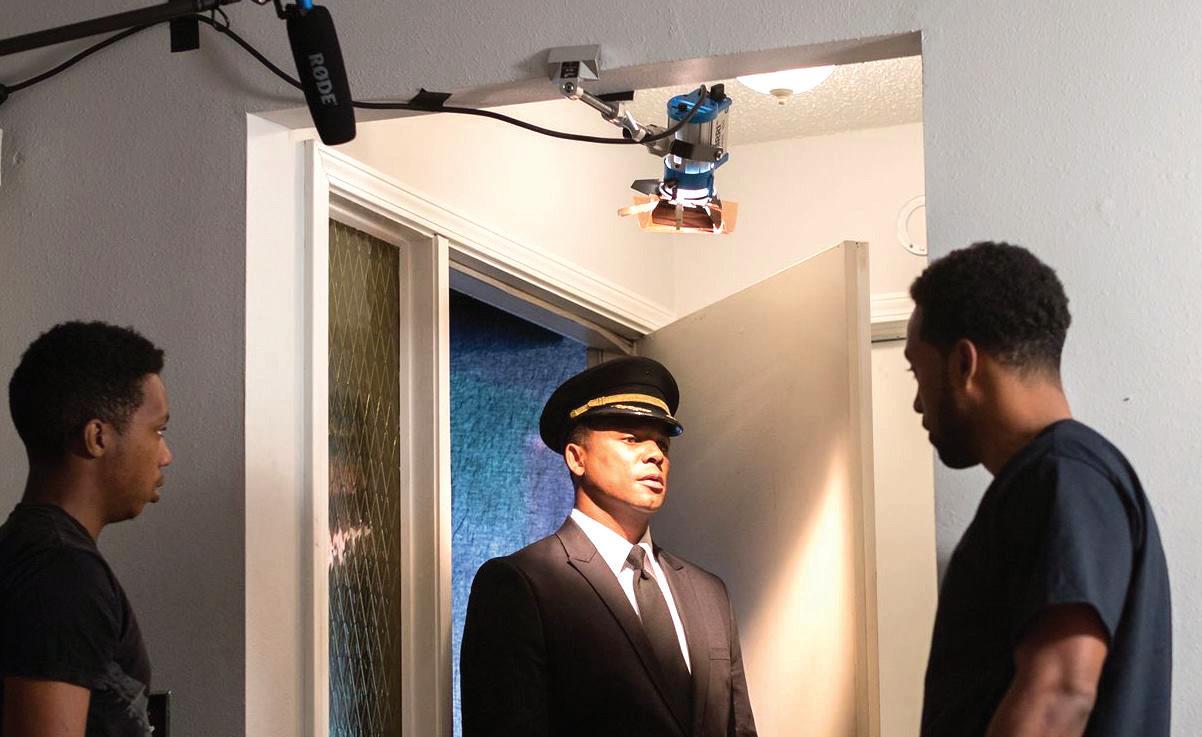
His most recent project is the TV series Kold x Windy on WE tv, and his filmography includes the Black sci-fi film Paradigm Grey (2018). I had a chance to sit down with him and chat about acting, the great Harold Johnson, sustenance jobs like MLMs, and the power of community mentorship in nurturing a career in the arts in Chicago. This interview has been edited for length and clarity.
Sheri Flanders: All of your social media handles are “99 Films on the Wall.” Is that a company? Or something else?
Harold Dennis: That’s my Facebook identification, Instagram identification, Twitter, LinkedIn, email address. So that was my motivation to shoot for 100 films on IMDb. Not only did I go to IMDb and look at my page every day, for all those years, I had my email to remind me, you know, reinforcement. And now I just got the 200th post yesterday.
Can you go back to when you first knew, “I want to be an actor”? How did this start?
When I was in second grade, I was picked to be in the Thanksgiving play—I wasn’t enthusias-
tic about it. But I got up on stage, and I had my suit on and forgot my lines! I remember how awkward I felt sitting there on stage, I was like, “This ain’t for me.” Two years pass. I got in the band—I was the lead trumpet player my sophomore year through my senior year. And so my senior year there was a class play. And I felt left out! I was like, “I didn’t know you guys were putting together a play! I would have loved to have been in that play!” And that stuck out in my head. You know, I missed it. Acting.
Living in Chicago, I thought it was impossible to be an actor, growing up on the south side and not really seeing anybody like me doing it big. So being in the movies was like a pipe dream.
So years later I looked up my high school band teacher, John Watson Sr.—he was a mentor to me, and he was in a film and had lines with Harrison Ford! He ended up in Soul Food [1997]—he was Uncle Pete, the old man. I was like, Mr. Watson lives here on the south side, he doesn’t live on the west coast or the east coast. It’s not impossible to do. I can do it; I want to do it.
Where did you begin your acting education?
I ran into my buddy Kenny Young, one of my fraternity brothers who was o into the business, and I said, “You know, I’m doing extra work now, but I want to do more.” Kenny says, “Well, why don’t you take an acting class?” And this was like September of ’97, I was like, “Oh, that’s a good idea. Where?” And he says, “eta Creative Arts.”
So I went over there. And I had $300 in my pocket because they told me that’s what it would cost. The second class of the term had just started, and I was like, “Oh, man, I’m missing the beginning of acting!” And the teacher Harold Johnson says, “We’re going to start over. We’re going to do what we did last week.”
At the end of the class, we did this improv game. I was the last person, and when it came to me, I had to do a nonverbal exercise, so I put my fingers up to my mouth like I’m smoking a cigarette. And I was all nervous, palms sweaty,
you know? And so I did it, and I blew out. And they had to guess what I was doing. And they said, “You’re smoking a cigarette.” And one kid says, “Yeah, but your mouth was closed.” And we all laughed, and at the end of that class, I said, “I’m going to do this the rest of my life.”
Yeah, that was a defining moment.
So I started eta in ’97, and a couple of weeks later, [Harold Johnson] says, “There’s no men in the advanced acting classes. If you want to come, come.” I said, “I don’t have another $300,” and he said, “Don’t worry about that.”
So for that whole school year, I took beginning and advanced acting. I was in heaven.
What is the project that you’re most proud of?
I did a film back in 2004 called Pieces of a Dream. That was the first time that someone cast me as a main character. I just started studying with Ted Serratos, maybe six months prior to that.
I went down and did an 18-day shoot in Alton, Illinois. The film came out, and it never got picked up. But I didn’t know that they screened it at the White House back in 2006. I’m going through Midway, headed down to Atlanta to meet the family for Christmas, and coming down the hallway was Barack Obama and his entourage. He was still a senator, he wasn’t president yet. And he stops and just started staring at me—I had to look over my shoulder to see if he was looking at somebody else! He stood there for another 15 seconds, and then he walked on. I was like, “I must be special!”
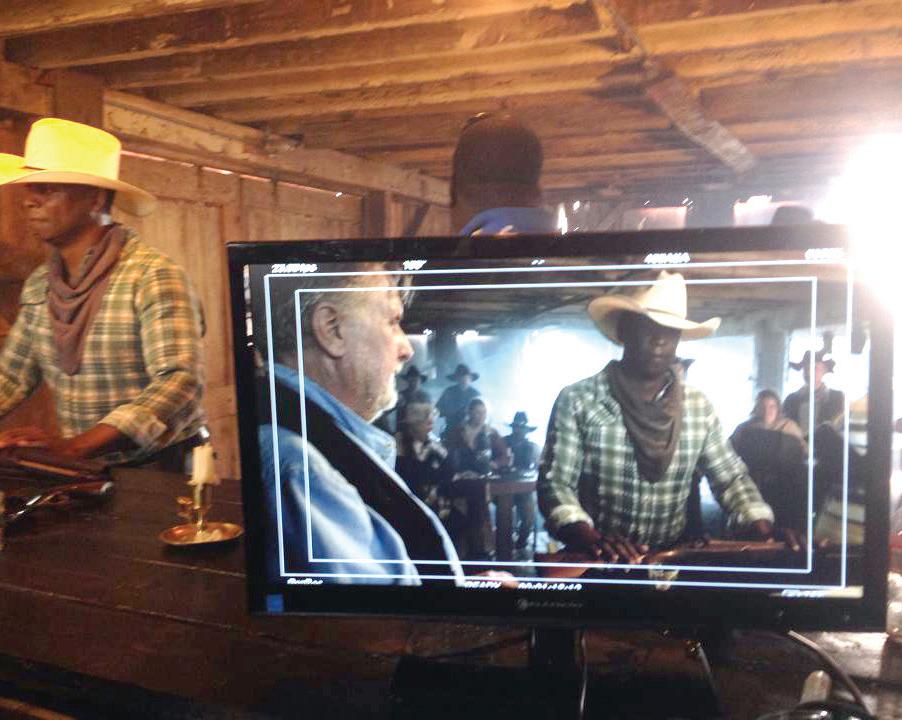
Pieces of a Dream never got distributed until one year ago, this week—it got distributed on Tubi TV.
A lot of actors end up moving out to LA or to New York, but I know that you’ve done a lot of work to bolster the community here. Tell us a little bit about that work. And what’s your advice to actors who want to make it here?
Well, that’s a great question. When I was start-
ing, my people, they all moved out to LA and they became very successful. Carl [Seaton’s] coming back here and directing Chicago P.D. and others. And I used to think, I want to move out to LA. I want to get my SAG card. And I had a young family, and I didn’t really know anybody out there, and the cost of living . . . So I weighed all of that, and it never happened. And I was like, I’m gonna make it here in Chicago. You know, your diamonds are in your own backyard. I heard that as a kid growing up, and this is my backyard.
I was doing plays, but I couldn’t find the films. The Chicago Reader had auditions [listed], but it was never enough. So what else can I do? Well, I can start going to film festivals and film screenings. So I started looking stu up. I don’t even think Google was around at that time.
I just started looking around and started going to events, shaking hands, and meeting people. I ended up going to the Midwest Film Festival back in 2004. One of my buddies had a short playing there [a few years later]. At the after party, I’m looking around—some of the stars that were in Hollywood, some of them were there in a bar. This is 2010. I said, “I need to be here every month.” And so I started volunteering. I’ve been volunteering for the last
13 years, and I became a volunteer coordinator about three years ago.
After doing Pieces of a Dream, in early 2005, they were having an Oscars party at the Gene Siskel Film Center. So I put my little sports jacket on and went down there. And it was boring. I had beer and sat around, and when it was over, I went home. But then I got free tickets in the mail for the Black Harvest Film Festival, and I went back down to the Gene Siskel Film Center, and I’m standing around and I’m like, “Oh, OK, this is nice!”
I gave one of the tickets away to a Columbia College filmmaker student. She ended up putting me in a fi lm two years later. Now she’s out in LA. So it’s all about networking, networking. Just do for others. Do more, go find more, just be entrenched. I’ve had a film or two in Black Harvest almost every year since 2006. And some years I’ve had like four films in there.
A young lady was doing an article on me back in 2012, I think it was. And we talked about the Black Harvest Film Festival. And then one of the young ladies at the Black Harvest saw it and she was like, “Oh, why don’t you be on the Black Harvest Community Council.” So I’ve been on that council since 2012.
You’re big into setting goals and achieving them. How did you develop that mindset?
Well, it was when I discovered multilevel marketing in 1991. This guy invited me to his house—he was selling insurance. He was a fraternity guy. So after the second invite, I went and I sat there, and the famous McKinley “Deacon” Davis was at his house during the presentation. I was like, “Wait a minute, there’s a way to make money not working a nine-to-five?”
I sold NSA Water Filters, New Skin Skincare, Quorum Electronics . . . Around that time they were selling Anthony Robbins tapes. I remember listening to those tapes about the power of rapport—it was New Age stuff I’d never heard about before, and I started thinking outside the box. And so the networking came. I still go through some of that stuff from time to time, now just different forms of it. It keeps me spiritually grounded, my prayer. My power of belief, “A man is as he does.” And what happens is more things keep coming along, and the projects get bigger and bigger and bigger. So what I’m doing is working. And it’s been working for 25 years, and I got the first 200 films. I’ll get to 300 and reevaluate my career and see what’s next.
So outside of fi lm, outside of acting, what do you do? What are your hobbies?
I still have hoop dreams. Not that I’m going to play for anybody’s team anymore! But during the summer, I like to get out there on the court by myself on the lake and shoot free throws, shoot free throws, shoot free throws, so I hit my record last year. I shot 300 free throws in an hour and 20 minutes. I’ve been doing that for 20 years, playing basketball my whole life in some form or fashion at the Park District or whatever. And so when it’s time for the young boys to come out there, they want to run and shoot. I don’t have to drive. I can just shoot, shoot, shoot.
@SheriFlanders

The vibes are immaculate, joked one of my friends as we walked into the new Alamo Drafthouse Cinema in Wrigleyville, which opened a few weeks ago. I’d been to only one other location, which had been retrofitted inside the over 100-year-old New Mission Theatre in San Francisco. Those vibes weren’t so immaculate; the Mission is an old theater, so no amount of restoration can make it shine like a new penny. But I liked that, so I’d had a relatively good impression of the fabled movie theater chain.
The first Alamo Drafthouse opened in 1997 in Austin, Texas. Since then the company has grown profusely, with 42 locations nationwide. The lore around the chain centered on its vaguely nontraditional programming; the extensive food and beverage menus; limited-edition movie posters; and—most famously or infamously, depending on what kind of movie watcher you are—their draconian rules around theater etiquette.
In 2011, Tim League, the theater’s cofounder, former CEO, and now executive chairman, received an irate voicemail from a customer who’d been kicked out for texting. The company then began using it as a preshow
advisory commercial and uploaded the bit to YouTube, where the customer’s Karen-esque rant promptly went viral. Some of the Alamo’s other conditions are not allowing infants or small children (except at special kid-friendly screenings), requiring that guests under 18 be accompanied by an adult, and not showing advertisements before movies.
Going into this new Alamo Drafthouse in Wrigleyville (its location either an attraction or a deterrent, again depending on what kind of moviegoer you are), I felt neutral in terms of what to expect. Some things I’d experienced or heard about in the past had been good, but some others, like the absence of celluloid projection at this particular location and early suggestions of overly nostalgic programming, had me wondering.
There’s little to discern that the theater is where it actually is, with no marquee or obvious signage to denote its presence. It’s on the third floor of the building, right above a UFC Gym. (Should you want to violently debate someone about whatever film you just saw, I imagine that’d be the place to do it.) When the elevator doors open, one immediately gets a holistic view of the theater’s o erings, from
the bar and seating area to Video Vortex, an inhouse video rental store (more on that later).
The pièce de résistance of the theater’s decor is a to-scale model of the backside of the 1961 Ferrari 250 GT California Spyder that crashes out a window in John Hughes’s 1986 comedy Ferris Bueller’s Day Off , complete with the NRVOUS license plate and fake shards of glass hanging from the ceiling that appear to be flying out amidst the wreckage. It’s impressive but also kitschy, and unapologetically so. (Below it on the floor is a decal that quotes Ferris’s famous line: “Life moves pretty fast. If you don’t stop and look around once in a while, you could miss it.”) It’s also a testament to the impersonal, “Instagrammable” branding style that’s come to dominate social media in recent years, existing to be propagated into the ether.
Video Vortex, the video rental inside the theater, is modest, though it apparently contains more than 10,000 Blu-rays, DVDs, and even VHS tapes that people can rent—for free. Listen, something being free is never a bad thing. Something being free often allows it to be accessible, which is a net positive in the grand scheme of things. Still, it’s lamentable that stores like Odd Obsession Movies have been forced to close in recent years, while the same business model is being used essentially as a gimmick by a corporate chain. (Thankfully, FACETS’s video rental store soldiers on.) To give a little more credit where it’s due, Video Vortex also rents out DVD and VHS players for a small fee, so those without this sadly outmoded technology can enjoy the thrill of physical media.
An installation made of old-school television sets, reminiscent of a Nam June Paik sculpture, adorns the eating area, where the tables are topped with vintage B movie lobby cards. Decorations in the style of VHS labels—Comedy! Drama! Adult! 3-Day Rental! Be Kind Please Rewind!—cover the walls. The bar next to it boasts a full menu, complete with movie-themed cocktails. A good theme is my Achilles’ heel, so I couldn’t help but admire the list: Y Tú Margarita También; Third-Rate Vaudevillians, a rye-based cocktail for the 1934 W.C. Fields film The Old Fashioned Way; and the classic mint julep and Mississippi punch for Baz Luhrman’s The Great Gatsby and Blake Edwards’s Breakfast at Tiffany’s, respectively. I opted for the Tokyo Drifter, named after Seijun Suzuki’s 1966 film. Mixed with whiskey and
bourbon, it was pretty damn good. There are other libations, of course, craft beer initially being a thing for which the Alamo Drafthouse was known. But like much else with the theater chain, they seemed to have moved past the homier stalwarts into fancier fare.
Like with the food. The concept of eating an actual meal at a movie theater is no longer the novelty it once was, with several AMC Dine-In theaters dominating the concept in and around the Chicagoland area. The Alamo Drafthouse follows the same idea, with moviegoers (or is it diners?) being able to order complete meals from their seats by writing one’s order down on a slip of paper and remotely signaling a waiter (apparently “ninja-trained,” as they don all black and crouch down low so as not to impede anyone’s view of the movie), who then takes the paper and returns summarily with food and drink.
I wanted to try an array of options, so my friends and I started with the loaded fries and a limited-time menu item, the brussels sprouts pizza. (In addition to such items, the theater also o ers special menus themed with certain movies.) Some of the appetizers fall under the nebulous category of being southwestern, and the fries were one of those. Topped with Hatch green chile queso, Tillamook cheddar, cotija, bacon, and sriracha sour cream, among other garnishes, the fries were easily my favorite thing I ate. The pizza was fine, though nothing to write home about and certainly not as substantial as pizza from a regular restaurant.
I’d done some research beforehand to determine what was popular on their menu, so seeing that moviegoers liked their fried pickles, we selected what seemed like their current corollary, the pickle fries. I like regular fried pickles, so I expected to like them in this unusual variation. Alas, it remains true that you can’t improve upon perfection; the pickle fries exceed the pickle-to-fry ratio that makes the originals so delicious. And the ranch dipping sauce just made them worse, at least to me, as I’m particularly bothered by putting a wet thing (the ranch) on another wet thing (the pickle). Does that make sense? Probably not. Still, did it impede my enjoyment of the pickle fries? Yes, yes it did.
The hand-breaded chicken tenders were similarly disappointing, with the breading falling off almost immediately. It’d been a while since I’d had chicken tenders served with gravy on the side, so I was looking forward to the Hatch green chile version that accompanied them. It was bland, not adding much to the dish at all. It may be worth noting
ALAMO DRAFTHOUSE WRIGLEYVILLE 3519 N. Clark, Suite C 301, 872-298 -3961 $11.99-$14.99, discounts available for kids, students, seniors, military, police, fire, EMS, and guests with disabilities drafthouse.com/chicago/theater/wrigleyville
the ketchup that came on the side of the fries that came with the tenders was the reddest I’d ever seen.
And what’s a movie without popcorn?
Initially we intended to forgo their regular popcorn and try the churro popcorn, which has pieces of churro in it, as well as a blend of cinnamon, sugar, maple, and vanilla, but they were out. So we got the regular bottomless popcorn—the bottomless here being wishful thinking, as we were full from the heavier fare and didn’t even finish it, even with tru e Parmesan seasoning.
I’ve come this far and not even revealed what I was seeing. I chose a repertory screening (which the theater offers in addition to newer movies, along with special screenings ranging from sneak peeks to brunches and movie parties, like the upcoming Ant-Man and the Wasp: Quantumania cosplay screening) of John Hughes’s aforementioned teen classic, Ferris Bueller’s Day Off , in part because the theater has been christened the John Hughes Cinema in tribute to the filmmaker who spent several of his formative years growing up in Northbrook and several of whose films are set

in and around Chicago. A special plaque at the theater’s entrance, next to the Ferrari 250 GT California Spyder, declares that, in Ferris Bueller’s Day Off, Hughes “perfectly captured the mischievous and carefree spirit of youth . . . cementing Chicago as a cinematic playground in the process.”
The movie, like much else about the overall experience, was fine. I’d seen it before, but it never resonated with me, even though it’s indisputably a love letter to one of the greatest cities in the world. The experience of seeing it was about as good as seeing any other movie at a multiplex, with big screens, comfortable chairs, and crisp digital projection. I don’t doubt that the folks over at Alamo Drafthouse love cinema and aspire for their Chicago location to become an integral part of the city’s moviegoing fabric. But like Hughes’s movie, it’s a love letter to a di erent kind of Chicago, one where the vibes are immaculate and the real city—with grit, grime, uncomfortable chairs, and crunchy film stock—is nowhere to be found.


“Delhi is a gaping wound,” says Mohammad Saud in director Shaunak Sen’s Oscar-nominated documentary All That Breathes. The documentary opens at night, fixed on a horde of rats racing across an otherwise arid wasteland. For longer than expected, Sen leaves the audience with the vermin before introducing the skies, narrowing in on the black kite—a beautiful raptor essential to the city’s increasingly unstable ecosystem. Across the city, the black kites carry a reputation as scavengers, subsisting on the city’s mountainous landfills, but despite this, Saud and his brother Nadeem Shehzad revere these birds. The brothers devote their lives to protecting them, working tirelessly to shield them from Delhi’s pollutants and healing thousands of injured birds in their infirmary. Despite the job’s thanklessness, the brothers have saved nearly 25,000 black kites.
All That Breathes documents Saud and Shehzad’s devotion to the black kites, exploring the bird’s invaluable role in Delhi, but Sen composes a far more intimate narrative of the two brothers. The documentary, condensed into 90ish minutes from about 400 hours of rough rootage, captures a gentle, touching story of two brothers bound together by a similar devotion. However, Saud feels content working in Delhi and Shehzad hopes to leave for the United States to learn more and return with more knowledge. Saud views this as abandonment. The tension simmers as Salik—a volunteer enamored by the black kites—attends to the injured birds with a touching graciousness. All That Breathes teeters on the brink of sentimentality but never extends further than brief glances, because the unrelenting task of protecting Delhi’s fragile ecosystem remains.
Sen captures a compassionate microcosm in the infirmary, persisting despite the intensifying sectarian violence and the collapsing Delhi ecosystem happening outside. All That Breathes presents a poetic, intensely beautiful story so precise that, at times, it feels staged but instead emerges from hours of painstaking care. And this film emphasizes the importance of that seemingly mundane yet infinitely important sensitivity, in spite of social, fraternal, environmental, or quotidian strains.
—MAXWELL RABB 97 min. HBO Max
Ant-Man and the Wasp: Quantumania will be a blockbuster due to its amazing cast, outstanding special effects, and family-friendly fare replete with enough funny lines and cameos to keep people entertained. Scott Lang (Paul Rudd) is back, riding his fame a er saving the world with the Avengers in Avengers: Endgame (2019). But when his daughter Cassie (Kathryn Newton) designs a radio to the quantum realm, the family all get zapped into a fantastical world populated with Oz-meets-Star-Wars-category creatures and delightfully mind-bending visuals. But what makes the Ant-Man franchise great is seeing him and Wasp traverse our world with their shrinking/growing tech. Instead, the whole film takes place in the green-screen world of the quantum realm; it’s heavy on the visuals with a fairly light, predictable Marvel story. We meet tons of creatures we want to know but barely learn anything about. Hope Van Dyne AKA Wasp (Evangeline Lilly) barely has a role and instead the film puts Cassie front and center along with Janet Van Dyne, the original Wasp (Michelle Pfeiffer), who somehow lived a full, crazy life as a “freedom fighter” in the realm for 30 years but has yet to tell anyone in the family anything about it, like the universe-threatening Kang The Conqueror (a terrifyingly excellent Jonathan Majors) or the entire reality of living creatures in the quantum realm. Corey Stoll makes an underwhelming anticipated appearance as M.O.D.O.K (if you know, you know), and post-credit scenes hint at a more interesting storyline to come. —JOSH FLANDERS PG-13, 125 min. Wide release in theaters

In his directorial debut, Michael B. Jordan brings a surprisingly heartfelt though formulaic addition to the Rocky franchise. Creed III is the seventh installment in the beloved boxing film series but the third to follow Adonis “Donny” Creed (Michael B. Jordan).
Those who know the original Rockys or have seen Ryan Coogler’s excellent 2015 spin-off that first spawned the Creed movies will remember that Donny is the son of Apollo Creed, Rocky Balboa’s rival-turned-friend. Sylvester Stallone doesn’t show up as Rocky here, though
he’s mentioned, as we now find Donny as a successful business and family man, his boxing days behind him until an old friend re-enters his life.
A typical MBJ performance can make you question his range, and Creed III is no different; Jordan still seems most comfortable playing the hero, the leading man, and the true test of his acting chops will come the day he takes a role that pushes him outside of this handsome typecast. Watching him in Creed III, you get the sense that he has yet to reach his full potential and is perhaps coasting, especially when Jordan and Jonathan Majors go head-to-head. Majors’s resume shows unbelievable versatility, from the eclectic and misunderstood artist in The Last Black Man in San Francisco (2019) to his more recent, bulked-up heroes in Devotion (2022) and HBO’s Lovecra Country. Here, he plays a formerly incarcerated childhood friend who forces Donny to confront their painful past. Every eye twitch from Majors tells a story, and his talent forces Jordan to bring it too, while also highlighting his shortcomings.
As a whole, there’s probably too much slow-mo, too much product placement, too many celebrity cameos; at times it feels like a slick music video, a far cry from its gritty and full-of-heart origins. And yet—Creed III is still incredibly fun. Michael B. Jordan shows real promise as a director (and it can’t be denied how difficult it is to both direct and star), and the film even manages to catch you off guard with a juicy reveal midway through that made my theater gasp out loud. Most of all, audiences will walk away with a powerful underlying message about toxic masculinity and how we process our feelings, our shame, how we live with ourselves, and how we try to learn from our mistakes.
—NOËLLE D. LILLEY PG-13,116
min. Wide release in theatersWhether a hijinks film successfully works out its kinks or not, it will always contain a fun mystery game with unscrupulous characters—and that is where Sharper occasionally finds its magic.
Four stories unfold in a monotone, cloudy New York, beginning with Tom (Justice Smith), a cozy sweater-wearing, nervous bookshop owner. He meets Sandra (Briana Middleton), a student at New York University studying the field of “Redefining Radicalism the Rise of Black Feminism in American Literature.”
It’s a mouthful, and the characters know it, but with a golden light (the only one you’ll see in this film) shining on the covers of glossy books and jazz in the background, it’s the introduction to a love story—and a crime.
As the story unfurls, you learn more about Sandra, the life she’s created with stone-faced Max (Sebastian Stan), and, by association, an alluring Madeline (Julianne Moore).
There are moments in Sharper when the fool isn’t supposed to be the viewer, but a docile character, so determined to accept the “someone I know is in a lot of
trouble” trope. Sharper is a film that makes you want to yell at the characters to see through the cracks, but if you blink too fast, you might miss a few yourself.
There are also moments of predictability—of course, the lying, cheating character will indeed lie and cheat— but the film still has its fun portraying a ping-pong game of malevolence and vengeance.
The performances aren’t what make Sharper fall short at times. Moore, clad in monochromatic cashmere outfits, has a scene where she showcases Acting 101: How to perform grief. Smith wears his anxiety in a way that makes his scenes uncomfortable to sit with until the film’s end. Stan is somehow deceiving and gullible. Middleton (in the worst braided wig I’ve ever seen) is a hollow shell that still somehow reflects light. You want to see more of these characters and the creation of who they came to be.
Sharper is worth the watch if you’ve subscribed to Apple TV+. The grit wears off quickly, but it doesn’t exhaust the viewer. Winning isn’t a black-or-white process—it’s as gray as the film. —ATAVIA REED R, 116 min. Limited release in theaters and streaming on Apple TV+
Catalan filmmaker Albert Serra has spent his career untangling and reframing historical and literary figures as avenues to think about history, power, and the human condition. He created a minimalist, slow-cinema take on Don Quixote with 2006’s Honour of the Knights, invoked Casanova and Dracula in 2013’s Story of My Death, and looked to 18th century France in 2016’s The Death of Louis XIV and 2019’s Liberté It’s a welcome surprise, then, that he moves to a contemporary setting for his latest feature film Pacifiction
Filmed simultaneously on three different digital cameras, the film immediately casts us into the lush waters and skies of the Polynesian island Tahiti. We encounter numerous Indigenous residents as well as an entitled French high commissioner named De Roller (Benoît Magimel), who Serra uses as a source of dry humor. While his pompous speeches are funny, they never turn into outrageous farce; as is expected for a Serra production, Pacifiction is slow-moving but riveting, eschewing any sort of climax or high drama to allow striking colors and hypnotic atmospheres to steer our attention for a nearly three-hour run time. As we watch De Roller go about his daily tasks, the soundtrack occasionally errs toward the foreboding, and there is a sense of paranoia and confusion that surmounts as the plot slowly develops. Ultimately, the film’s greatest feat is in providing moments for delightful reverie through its sumptuous visuals while constantly making clear the colonialist reality of the island: there’s beauty, yes, but it’s shrouded in a status quo defined by uncertainty and helplessness.
—JOSHUA MINSOO KIM 165 min. Gene Siskel Film Center v


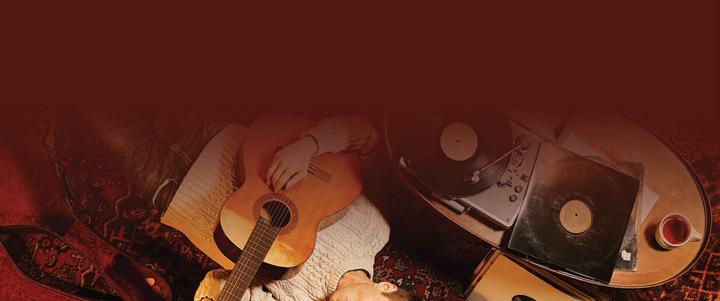






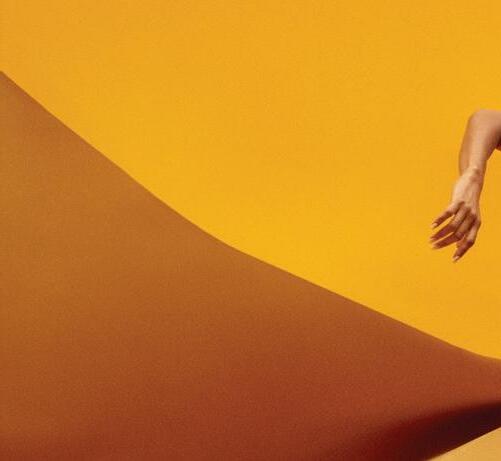




The veteran house-music DJ knows how to make people dance. Can he inspire them to vote?
By LEOR GALILJulian “Jumpin” Perez has a cough. He hasn’t let his recent illness stop him from granting me an interview, but it sneaks up on him as he talks about his storied career in music and his future ambitions in politics. His stories get longer and longer because they so rarely move in a straight line.
Perez segues from the 1985 DJ battle that won him his position on WBMX’s legendary house DJ crew, the Hot Mix 5, into the challenges of making a mix on cassette. (“We couldn’t lay in our bed in our underwear and just time-stretch everything and put everything in BPM format—basically click and drag. Back then you had to go and do your work.”)
His list of the best Chicago record stores in the mid-80s (Importes Etc., obviously, since it was the hub for house DJs, as well Loop Records and Gramaphone) spills into the nuances of great mixing. (“Chicago’s always had the best DJs in the world; technically, no one can touch us.”)
“We’ll get to that later” is a frequent refrain.
Perez always does get back to his point, and even his tangents enrich his stories. He’s been involved in Chicago music for more than 40 years, so he has more to share than any one person could possibly absorb.
I’m a music journalist, and that’s why I’ve come to Humboldt Park to talk to Perez in the middle of December. We’re sitting in the spartan o ces on Augusta Boulevard that serve as his satellite campaign headquarters. In July, Perez formally announced a run for alderperson of Chicago’s 26th Ward, whose sawtoothed borders enclose parts of Humboldt Park and Ukrainian Village, along with slivers of Logan Square and Hermosa. I wanted to know: Why does he want this o ce?
“I’m not a politician, man—I think you know that,” Perez says. “I’ve been learning a lot about the structures as a political leader, I guess you would say. But the reason I’m doing this is because, I think from hearing from so many people, we’ve seen enough, we’ve heard enough, and we’ve had enough, really. We’ve had enough of this failed leadership that’s been going on.”
Perez, 58, moved to the 26th Ward from the suburbs in 2022 to challenge the incumbent alderperson, Roberto Maldonado. Maldonado has held the office since mayor Richard M. Daley appointed him in 2009.
“You can’t preach affordable housing and live in a $2.5 million, 6,700-square-foot home with a private driveway, two-car garage, on three city lots,” Perez says, calling out Maldonado for his house near the 606. “And some of the a ordable housing, how does it play out for him? He’s kept businesses out of this ward, because he doesn’t want the gentrification. That’s his go-to. The west side of the ward is overlooked.” (According to a March 2022 Block Club story about Maldonado and his house, which was then listed at $2.4 million, it’s 6,400 square feet and has a two-and-ahalf-car garage.)
On December 5, Perez filed a petition to remove Maldonado from the ballot, claiming that more than 78 percent of the signatures the alderperson had gathered for his nomination papers were “not genuine.” Maldonado voluntarily withdrew from the race on January 6. (Perez himself has survived a ballot petition that claimed he didn’t meet the residency requirements.)
Two other hopefuls, Kirk J. Ortiz and Anthony N. Rivera, have since fallen to nomination challenges, narrowing the field to three. The remaining candidates, aside from Perez, are 26th Ward Democratic Committeeperson
Angee Gonzalez Rodriguez (who beat Maldonado to become committeeperson in 2020) and Jessica “Jessie” Fuentes, director of policy and youth advocacy for the Puerto Rican Cultural Center and a cochair of nonprofit advocacy group Puerto Rican Agenda.
As a community organizer, Fuentes has often worked with Maldonado, who endorsed her earlier this month. She’s also collected endorsements from the likes of the Chicago NOW Political Action Committee, United Working Families, and the Chicago Federation of Labor.
Fuentes and Gonzalez Rodriguez both have political experience, and Perez does not—so reporters have had a hard time putting his candidacy in context. Until recently, the coverage I’ve read about the race for 26th Ward alderperson has mostly made the same two points about Perez: he’s a popular DJ, and in 2019 he weathered backlash after he made a joke hurtful to Mexican immigrants while appearing at Festival Cubano in Riis Park. (He’s repeatedly apologized for the joke, but I’ll get to that story later.) Perez is trying to use his status as a political outsider to his advantage. He’s cast himself as a candidate uninvolved with the status quo—one whose primary motivation is to serve the residents of the 26th Ward. “My mindset is just commonsense governing,” Perez says.
I’d visited Perez’s website several times before we met, but I still wanted a better picture of his political perspective. I found the platform he’d published online disappointingly vague: he said he supported police and teachers, but he gave little sense of how he’d translate that into actionable policies. In the months since, Perez has beefed up his published policies, and his additions include several points we discussed at our December interview.
Perez wants to spur more business development in the ward; he wants to provide more a ordable housing, both by working with developers and by converting city-owned vacant lots; he wants city services to better address the needs of residents; and he wants to be a bridge between 26th Ward residents and law enforcement.
The mix of positions Perez holds makes it difficult to label him ideologically. His procop stance is clearly conservative, while his faith that investment in new businesses will benefit the whole neighborhood is more neoliberal. He’s also progressive in his attitude toward unions, as a card-carrying member of SAG-AFTRA.
Perez spelled out many of his positions in
his replies to a questionnaire that the Tribune published on February 7; three days later, the daily endorsed Perez for 26th Ward alderperson. He’s received one other big endorsement: the Chicago Fraternal Order of Police.
Arguably the biggest thing Perez has going for him is name recognition: he emerged as part of a generation of DJs who transformed house into a citywide phenomenon in the mid1980s, and he joined the Hot Mix 5 as Julian “Jumpin” Perez in 1985. His time with the crew was relatively short, but he’s had an unusually long on-air career in radio—he worked at various stations more or less continuously from 1985 till July 2022, when he retired to run for office. Confoundingly, though, he chose not to include his famous nickname, “Jumpin”— which he used consistently throughout his decades on the air—in the version of his name appearing on the ballot.
Perez was two years old when his family emigrated from Cuba in 1967. “[I] came here, literally, with what I had on,” he says. “‘Hey, welcome to America, good luck.’ Catholic Charities gave us $20 and we were on our way.” Six months after arriving in Florida, the Perez family moved to Humboldt Park, but only temporarily. His parents soon found work in Northlake, and they rented an apartment in the western suburbs. “My dad saved every penny—and my mom [did too]—and purchased a home in Northlake,” Perez says. “That was our first home. And from then on, that was basically where I was raised.”
Perez got the itch to try DJing at age 14, in the late 1970s. “One of my friends was doing mobile DJ gigs,” he says. “I had a dream one night—in my dream, they got rid of one of the partners, and he asked me to become one of the partners. He left all the equipment at my house to practice.” In 1980, he launched a DJ company with a friend. They started by booking parties at a Chinese restaurant in Bellwood. “We were bringing in 150 people, at $3 to $5 a head,” Perez says. “It escalated from there.” Perez built sets out of funk and disco. “My passion was the funk stu ,” he says. “So Parliament, ‘The Big Bang Theory,’ Cameo. Those type of funky, down-tempo grooves.”
Perez often attended a teen night at a disco in Addison called the Galaxy, where he befriended the DJ who ran the party. “When he went to college, I took over as the resident DJ there,” he says. “So Sunday nights we would pack in 700, 800 kids.” At age 17, Perez began his radio career at WRRG, the station for Triton College in River Grove. He hosted a
Sunday program called The Latin Explosion , drawing inspiration from a trip he’d taken to Florida in summer 1981; that’s when he’d first heard Miami radio station Super Q, which programmed English-language and Spanishlanguage music.
The Galaxy gig helped Perez get work at a Rush Street nightclub called P.S. Chicago. “I may or may not have lied about my age and started working down there when I was maybe 18, 19, 20—I can’t recall,” he says. “But that was a lot of fun. That was back in the days when DJs, we would do six-, eight-hour sets.”
Perez would start shifts around 8 PM and spin till 4 AM. “That’s really where the programming aspect of DJing came to be, for me,” he says. Hot Mix 5 member Scott “Smokin” Silz was spinning at another Rush Street club and would drop by P.S. Chicago when Perez was DJing. They struck up a rapport, and other Hot Mix 5 members began making their way to P.S. Chicago. “Farley [‘Funkin’ Keith] came by, and Kenny [‘Jammin’ Jason], so I met those guys,” Perez says. “And I started doing guest mixes for WBMX.”
According to Micah E. Salkind’s 2019 book, Do You Remember House? , WBMX had a 14 percent share of the city’s prime-time radio market in 1985. That year, Silz left the Hot Mix 5, and WBMX hosted a contest to replace him. Perez submitted a cassette mix that earned him a spot in one of four semifinal competitions, specifically the battle for northside DJs. He prevailed there, which put him in the finals against three other DJs, including Steve “Silk” Hurley, who’d won the south-side competition.
“I was lucky enough to win the battle, and that got me on the radio,” Perez says. “I think I’ve been the only one in Chicago radio that had to win a spot to be a mixer. Most of the guys were handpicked.”
When program director and Hot Mix 5 creator Lee Michaels left WBMX in October 1985, he moved to WGCI; over the next two years, most of the Hot Mix 5 followed him there. Perez stayed at WBMX, though, and took on the role of mix-show director. Over the next couple years, he ushered a rotating cast of DJs onto the airwaves, including Frankie “Hollywood” Rodriguez, Bad Boy Bill, and the godfather himself, Frankie Knuckles. WBMX went o the air in 1988. The following year, Perez debuted a mix show on Top 40 station B96. “April first, that’s when we started the mix show—Fridays and Saturdays,” he says. “And we started doing mixes during the day.” Perez founded the B96 Mixmasters
continued from p. 37
team—which included Frankie “Hollywood” Rodriguez, Bad Boy Bill, and Tim “Spinnin” Schommer—and developed his on-air personality as cohost of a Sunday-night series called The Street Flavor that played Spanishlanguage and English-language music.
Perez became a crossover sensation thanks to his work on B96. His influence extended beyond radio. In 1995, WCIU-TV debuted U Dance With B96 , a dance program modeled after Soul Train and American Bandstand that featured B96’s slate of DJs—including Perez. By that point, Perez had put out a few 12-inches through foundational house label DJ International. He’d also done remix work for Queen Latifah (1990’s “Come Into My House”) and hip-house standard-bearer Fast Eddie (1988’s The Julian “Jumpin” Perez Megamix 12-inch).
Perez also parlayed his DJ career into several businesses, including a chain of record shops called Jumpin Musik. “I’m an entrepreneur,” he says. “I’ve had 17 di erent businesses since I was a kid. I had a restaurant. I had two magazines—a bar magazine and a kids’ sports magazine. I had a salon and spa. I had 16 di erent locations of Jumpin Musik retail outlets. I started my own mortgage company; I started a real estate company. I’ve had two nightclubs.”
At least one of Perez’s businesses didn’t get off the drawing board: an indoor shootingsports facility in Bloomingdale that also would’ve offered the gun-safety training required for an Illinois concealed carry license. The project encountered community pushback, mainly due to its proximity to housing. According to the Daily Herald, Perez withdrew his proposal in May 2014.
Music has remained the core of Perez’s professional identity, though, and he’s enjoyed his status as one of the city’s best-known DJs. “My mindset back in the day—I’d always have somebody with me, and the last thing we’d say when we get out of the car is, ‘Let’s go hurt some feelings,’” he says. “‘Let’s go have some people reconsider what they want to do for their livelihood and not [be] DJs.’”
Perez probably inspired at least as many DJs as he discouraged, though, and he knows of at least one person who took up DJing because of his example: his current campaign manager.
Carlos Claudio is a lawyer who works as deputy general counsel for the Clerk of the Circuit Court of Cook County. He was 16 when he saw Perez spin for the first time, on the tennis courts at Humboldt Park. “I like to say I was a DJ before I was a JD,” Claudio says. “Part of that was because I saw him mix when
I was young, and it got the bug in me. I saved my money, got some turntables, and was mixing in my basement—and that kept me out of trouble, in a way.”
Today Claudio only spins records at home as a hobby, but he’s no less a fan of Perez’s DJing. “He still, to this day, uses manual pitch,” Claudio says. “You see him chasing the beat—he’s never off beat, right? That’s a hard thing to do, to be able to stay on beat while you’re also planning a mix, while you’re also entertaining the crowd.”
Perez worked a few stints at B96 (“I’ve been fired from B96 twice over the phone,” he says), held a job at Kiss FM, and ended his career last year at 104.3 Jams—whose call letters, Perez likes to point out, are WBMX. He developed an interest in running for o ce a few years ago, partly in response to what he calls “the nonsense that went on” with the Trump administration.
In September 2019, Perez launched the Julian “Jumpin” Perez Foundation, a charity that provides for families in need via clothing and food drives. His adult children—Bianca, Bella, and Dominic—serve on the foundation’s board, along with Bad Boy Bill and Perez’s fiancee, Jessica Rodriguez. (Rodriguez is also chair and treasurer of the Friends of Julian Perez candidate committee.) They’re all among the people Perez consulted when weighing a run for alderperson, and most of them thought he should do it. “I had one person that said, ‘You’re nuts,’” Perez says, “and that was Bad Boy Bill.”
On August 9, 2019, Perez and Jessica Rodriguez were onstage at Festival Cubano in Riis Park, and they encouraged di erent contingents of the Latin American diaspora to cheer. Rodriguez asked Puerto Ricans to cheer, and then Perez asked the Mexican people in the crowd to do the same. As Perez recalls, the eruption of cheering took so long to taper o that, to try to move the festival along, he made a joke about quieting the crowd. He shouted his punch line: “Oh shit, it’s ICE!”
“The entire crowd laughed, then they stopped—and then I got some boos,” Perez says. “[Jessica is] like, ‘I think they’re mad at you.’ My exact response is like, ‘Mad at me? How can they be mad? These are my people. I’m gonna be in Pilsen tomorrow.’ Then they clapped, and then the concert continued.”
When word of Perez’s joke hit social media, the initial flurry of posts didn’t include audio or video from the festival. The 5 Magazine report on the fallout noted that Perez’s precise
language wasn’t clear, but word-of-mouth accounts from among the Riis Park audience let people reach their own conclusions. Perez was pulled from the lineup of the My House Music Festival later that weekend, and he issued an apology. But even now, he struggles to understand why anyone would think he meant to harm other immigrants from the Latin American diaspora, especially people from a community to which he’s intimately connected.
“My nieces, my nephews are Mexican,” he says. “To be totally honest with you, that almost ruined me, to think that people would think that I don’t have my peoples’ best interest [in mind].”
The incident resurfaced as Perez prepared to run for office. In April, when Block Club reported that Perez had filed a D-1 Statement of Organization to run for alderperson, the longest paragraph in the story was about his Festival Cubano appearance. It also comes up in the brief profile of Perez included in the Girl, I Guess progressive voter guide. “This is, obviously, not great, not progressive, and not something we want on City Council,” writes Girl, I Guess author Stephanie Skora. “Perez also has the FOP endorsement, and therefore deserves zero votes.”
Perez has made community safety a pillar of his platform, and his plan emphasizes supporting police officers. He’s upset about low recruitment and low morale, he’s frustrated because he sees o cers as overworked, and he doesn’t like police being targeted by what he describes as disrespect. He’s also critical of the Chicago Police Department’s recent change to its foot-pursuit policy, which states that officers can’t chase people on foot if they’re fleeing or have committed a minor o ense.

“You and I could be standing outside, and four guys can come and start beating us down, and the police officer shows up—they can’t chase the guys that just beat us down,” Perez says. “How does that make sense to anybody? It really doesn’t.”
Perez aspires to build trust between 26th Ward residents and the CPD any way he can—though his pro-cop positions may prove a stumbling block for residents invested in alternatives to policing. He stresses how important it is for the community to see him as engaged with their safety concerns.
“I don’t care what your background is: the number one concern that you have for your family is to be able to walk out the door and not be attacked or anything else,” he says. “As a leader, they have to see that you’re gonna be there. If there’s an incident, if there’s a shoot-
ing, I’m gonna be there, because the community needs to see me there. If they know that I’m engaged and I want to make a di erence, they’re gonna get engaged.”
Ward resident Carlos A. Rivas Jr. says he’s seen Perez at CAPS beat meetings over the past six months or so. “I don’t think he lives in my beat, but I think it’s part of him getting to know the ward—going to beat meetings in the ward,” Rivas says. “I’ve also seen that he’s done a few events with his foundation, which I think is pretty awesome. But I don’t know much more—I don’t know where he stands on certain things.”
Rivas has lived in the 26th Ward his entire life. “For me, the biggest concern that I have is property taxes went up astronomically,” he says. In 2019, he bought a two-flat that he’d moved into two years prior, and he’s friends with the tenants in his second-floor unit. For Rivas, the newest property-tax increase was tantamount to an additional mortgage payment.
“I like the area. I want to be there long-term, but $8,000 in property taxes is a really huge amount,” he says. “I also don’t want to put this
all on my tenants and don’t want to push them all out of the neighborhood. We’re all Latinos from Humboldt Park and want to stay there.”

In his Tribune questionnaire, Perez wrote that he wants to reverse the Lightfoot administration’s policy of tying property-tax hikes to inflation. (Though the mayor waived the 2023 hike, the policy remains in place.) He tells me he hopes to provide more a ordable housing for the ward, which he sees as inextricably linked with new development.
“There’s a lot of empty retail spaces in the neighborhood, and that causes issues for everyone in the neighborhood,” says developer Gary Levitas. “It seems to me Julian is looking to bring in more businesses and more development.”
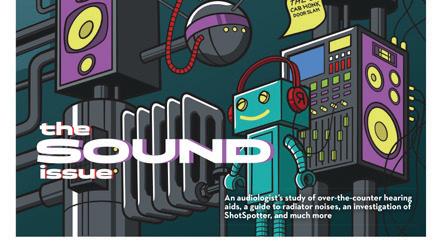

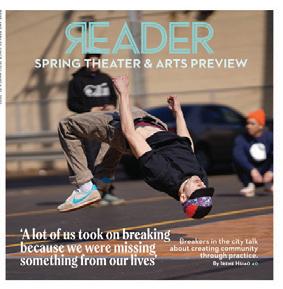





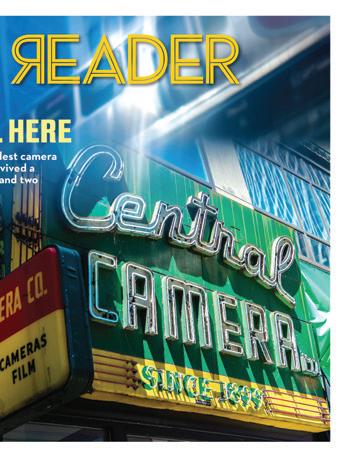


Levitas first heard of Perez during his 1990s stint on B96, but they didn’t meet till recently. They were introduced by Raymond Valadez, who’d served as chief of staff for former 1st Ward alderperson Proco “Joe” Moreno. Levitas runs Northfield Group, a real estate company responsible for several sleek, impersonal condo complexes, rental buildings, and mixed-use developments on the west side. In Perez, he’s found an aldermanic candidate who speaks to his concerns as a developer and landlord. Levitas also puts a lot of weight on Valadez’s support of Perez.


Perez tells me he wants to serve every 26th Ward resident, not just the small percentage who vote in elections or a tiny number of well-heeled donors. “One of the things, unfortunately, in being an elected official, a lot of these people—when they start getting backing from certain di erent areas, they almost feel like they have to reciprocate,” Perez says. “I want to do this on my own. I don’t want to owe anybody anything. The only people I want to owe are the people that live here.”
Perez is his own largest donor—he’s injected $31,423.17 into his campaign via loans, roughly 74 percent of the $42,304.81 he’d raised as of February 17. The dozens of other donations to the Friends of Julian Perez candidate committee give you some idea who’s sympathetic to his cause. Levitas donated $1,000 under his own name (he’s given the same amount to Proco “Joe” Moreno this cycle), plus $7,500 in in-kind donations through one of his other companies, BAS 1 Development. An Illinois charter school PAC called INCS Action donated $2,500. JLD Management Group, which specializes in affordable housing, donated $2,000. Bacci Pizzeria owner Robert Didiana gave $1,000, and his company donated another $1,000. McDonald’s franchisee John DeCarrier
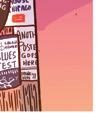
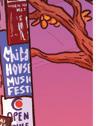











gave $5,000. Bad Boy Bill gave $10,000, half under his government name and half through Bad Boy Bill LLC.



In January, Block Club reported that as of December 2022 Perez had more funds in his campaign account than Fuentes or Gonzalez Rodriguez. But since January 1, the Fuentes campaign has pulled ahead—on February 17 it had $113,663.65 on hand, more than double Perez’s total.
Perez claims he’s knocked on thousands of doors and met thousands of residents, to demonstrate how available he wants to be to the 26th Ward. “One thing that I’m gonna be the most proud of is the accessibility people have from me,” he says. “Because at the end of the day, you’re not a true leader if you can’t be accessible. Because how do you lead somebody if you don’t know what they need?”
Perez has scheduled several meet-andgreets as he’s ramped up his campaign, including one at Dos Urban Cantina on February 9 and another at Weegee’s Lounge on February 11. That same week, though, he skipped two forums intended to give a platform to candidates for 26th Ward alderperson. Claudio says that Perez missed those events because he had pre-existing commitments to a fundraiser and to a public safety meeting organized by the CPD’s 25th District.

The League of Women Voters of Chicago hosted a virtual forum February 8, which Fuentes and Gonzalez Rodriguez attended. At a February 10 forum hosted at New Hope Church by Palenque LSNA, only Fuentes showed up. According to Mina Bloom of Block Club, Fuentes opened the forum by apologizing for being the only one present: “You all deserve to hear from all of your candidates to make an informed vote.”
Perez likes to meet voters on his own terms. And though he hasn’t done everything he could have to communicate his vision to them, he does have a vision. He wants a united front of 26th Ward residents to shape what happens in their neighborhood.
“Everybody needs to have a say,” Perez says.






“As I say with music: white, Black, Brown, green, yellow, blue, whoever you love, whoever you chose to marry, I don’t care, that’s your prerogative, right? I believe that everybody has a choice, and it’s up to them. But I think the only way we change the course of this madness and sadness, to be honest with you, is for all of us to be together. That’s why I preach a community of one. One community for all.” v




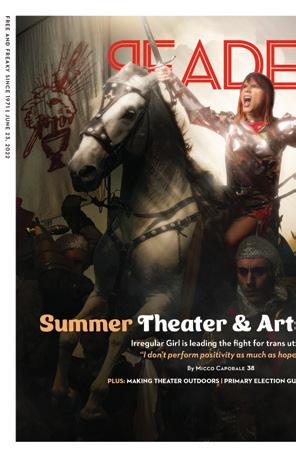






Dem Hopkins didn’t just run Oz, the former gay bar that helped birth the local scene. He’d lived on the streets himself, and he devoted the same passion he had for punk to the cause of housing justice.
By LEOR GALILIn 1980, Chris Bjorklund frequented a River North bar called Oz, which two years earlier had become one of the first places in Chicago to embrace punk. He visited often enough that he got to know the owner, Dem Hopkins. Bjorklund played in a band called Strike Under, and Hopkins o ered to introduce him to another Oz regular who’d started making music.
“Sure enough, I was in there another night, and Dem pointed out this guy who was probably about six foot three, with a huge black overcoat, very thick pancake makeup, and a corkscrew blue hair qui —which, at the time, you didn’t do in Chicago,” Bjorklund says. “Dem pointed him out and said, ‘That’s Je .’” Bjorklund walked over to Jeff Pezzati, who’d been posting flyers for his band, Naked Raygun. “We started talking, and that was the forming of an alliance—we played with them a lot, they became friends of ours, we shared a practice space,” Bjorklund says. Both bands also went on to perform at Oz. The bar was a focal point for Chicago punk, partly because of Hopkins’s talent as a musical matchmaker.
“I think Dem did that kind of thing all the time, and that was something I think was really important to him,” Bjorklund says. “He expected nothing from it—that wasn’t his intent at all. He just liked the idea of connecting people and building communities because people were interested in the same thing.”
Hopkins, who died January 24 at age 67, ran Oz in three different locations between 1978 and 1981. To create its first incarnation,
he transformed the Greenleaf, a Rogers Park gay bar he owned; he later moved Oz to River North and finally Lakeview. In March 1981, a few months before the Lakeview location closed, engineer Timothy Powell of Metro Mobile Recording ran three nights of sessions on the bar’s stage, documenting six local bands— most of whom frequently played at the bar—in front of a captive audience.
The resulting compilation, Busted at Oz, includes the very first recordings by the E gies, Naked Raygun, and Silver Abuse. According to Joe Losurdo and Christina Tillman’s 2007 Chicago punk documentary, You Weren’t There , it helped establish the Chicago punk scene nationally. “Busted at Oz, in many ways, is almost like Ramones’ Ramones,” says Riot Fest cofounder Mike Petryshyn. “It’s a testament of the time.”
Petryshyn met Hopkins in 2010 through Michael Nameche, director of development for the Chicago Coalition for the Homeless. Hopkins had interned for CCH as a law student two decades earlier, and he renewed his connection to the organization after seeing Patti Smith at Park West as part of CCH’s Hopefest in February 2010.
For years Hopkins had resisted fellow punks’ entreaties about Oz reunions, but he had such a great time at Hopefest—and he was already so sympathetic to CCH’s mission—that he reversed himself completely. He pitched Nameche on a benefit show for CCH that fall that would bring together the Busted at Oz bands. Nameche connected Hopkins with Petryshyn
because Riot Fest had played a role in Naked Raygun’s long-running reunion, which began with a Congress Theater gig in 2006.
In late spring 2010, Nameche and Hopkins met with Petryshyn at Cobra Lounge. What Nameche thought would be a half-hour conversation lasted close to five. “Dem told stories about what the early days were like, and Mike had all these stories of what those band members were up to now,” Nameche says. “I could not get a word in edgewise.”
Petryshyn and Hopkins went out for a smoke break together near the end of that hangout, and when they came back inside, Petryshyn laid out a game plan for an Oz reunion. That year’s Riot Fest kicked off Wednesday, October 6, with a Double Door benefit show that featured latter-day versions of four bands from Busted at Oz. Petryshyn has since facilitated some of the biggest reunions in punk history—among them the Replacements, Jawbreaker, and the original Misfits—but the Busted at Oz reunion still stands out to him. “It had a far di erent feel of any show I’ve ever done,” he says.
Hopkins continued to build on the relationships he’d developed with Petryshyn and Nameche. Within a year or so of the Busted at Oz show, he joined CCH’s board of directors, and he spent months helping Riot Fest establish its nonprofit foundation in 2015. He grew close with his new friends, and they’d bond over music. “I made a list of shows, and he would take me to shows,” Nameche says. “I crossed a lot of bands o my list because Dem was like,

‘We’re going to see Swans.’ Or ‘We’re going to see Pere Ubu.’ Or ‘Diamanda Galás.’”
Hopkins was diagnosed with lung cancer a few years ago, but he still made it out to shows when he could manage it. He sought out new music with the fervor of a teenager, even as the generations marched on—as devoted as he was to the punk of his youth, he didn’t let that legacy ossify around him.

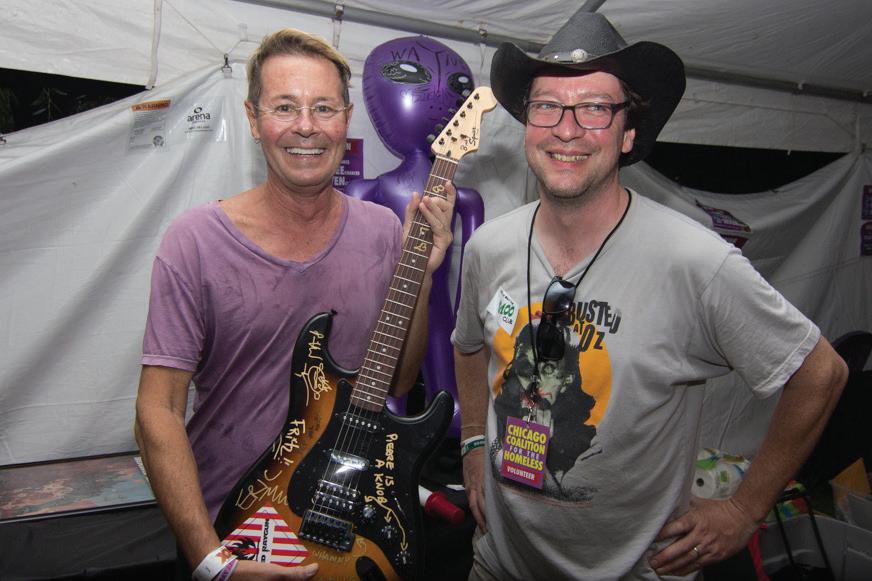
When his health improved enough in fall 2021, he and Nameche went to Sleeping Village to see one of Hopkins’s favorite current bands, young UK postpunks Black Midi. Hopkins immediately bought tickets for their show in Milwaukee the following month, and in March 2022 he saw them a third time at Metro. That zeal sprang from the same power source he tapped to create one of the very first homes for Chicago punk bands.
“He was a righteous dude,” Pezzati says. “Without him, I don’t think we’d be where we’re at today with punk rock in Chicago. He really blazed a trail.”
Born in Michigan on November 16, 1955, Demetrius Hopkins came to Chicago with his mother at an early age. By his senior year at Lane Tech, he’d developed a righteous streak. Hopkins and fellow student David Rabin spearheaded a fight with the school’s administration, which wanted to punish them for publishing an alternative newspaper called The Oppressed . Hopkins
and Rabin took their battle to the Commission of Inquiry Into High School Journalism convened by the Robert F. Kennedy Memorial Foundation, which included an overview of the situation in the 1974 book Captive Voices: High School Journalism in America Administrators harassed Hopkins and Rabin and threatened them with suspension. The two of them filed suit against the principal, the assistant principal, and the Chicago Board of Education. They settled the case out of court, and Hopkins and Rabin had all disciplinary actions expunged from their records.
When Hopkins came out to his parents in his teens, they kicked him out of the house. His close friend Laura Hadley says he lived on the streets of New York City for a spell. She’s 17 years younger than Hopkins, and she met him through her father, Charles, while she was still an infant. Hopkins got to know Charles Hadley by working with him on political campaigns in Chicago, and depending on the day’s childcare arrangements, Laura was sometimes around too. “He was telling me stories about me learning to walk in the campaign o ce,” she says, remembering the conversations she had with Hopkins in the weeks before his death.
Charles and his wife, Georgian, eventually decided to take Hopkins in—he was around 20 years old at the time, and he hadn’t found a settled place to live since his eviction from the family home. Laura, then three, got along splendidly with Hopkins. “He was like a big
brother to me,” she says. “He taught me to say ‘Blow it out your ass.’”
Charles Hadley also invested in Hopkins’s work outside of politics. Laura says her father was a silent partner in queer hiring agency Lend-a-Man, which Hopkins ran with business partner Dick Nielsen. Hopkins also bartended at the Greenleaf, and when he decided to buy the place in the mid-1970s, Charles put money into it too. Laura sometimes visited the Greenleaf during the day, and she’d commandeer the jukebox. “Here I am, four or five years old,” she says. “They’d make me a Shirley Temple, I’d play pinball, and I’d play the ‘Happy Birthday’ song over and over and over.”
Hopkins imprinted his taste on the jukebox too. He loved glam, and after punk broke, he added singles by the Sex Pistols and the Ramones. In mid-1977, Hopkins began spending time at a Lincoln Park gay bar that in May had become the city’s first punk disco. At that time, La Mere Vipere provided the only home away from home for punk and punk-curious Chicagoans, but in April 1978, a mysterious fire closed it for good. La Mere co-owner Noah “Noe” Boudreau eulogized the bar in the debut issue of Chicago new-wave zine Praxis. “Our friendships, our varied musical tastes, and our senses of humor were not torched,” he wrote. “If anything we all have a sharper edge about us.”
When Patti Smith and her band headlined the Park West later that April, someone
shouted in the middle of the show, “Patti, they burned down La Mere!”
“All right, so they burned it down, so build another one,” Smith responded. “Don’t whine to me that they burned it down, build another one. You’re the only ones that are gonna do it.”
Hopkins was in the crowd. He left the show with designs to turn the Greenleaf into a punk bar. Oz was about to be born.
Oz wasn’t the only gay bar to turn punk after the fire at La Mere. DJ Nancy Rapchak convinced the owner of a divey River North gay bar called O’Banion’s to give punk a shot in June 1978. Chicago punk often grew out of gay bars, and many of the queer folks who took to punk did so in reaction to mainstream gay culture.
Hopkins provoked plenty of criticism by turning his bar punk, though, and not just because some of his regulars didn’t like the music. Many resented a rebranding that would attract straight people to a neighborhood gay bar—Rogers Park was far from the city’s centers of gay nightlife at the time, so the Greenleaf had outsize value as a sanctuary.
Still, Oz retained a lot of its existing crowd even as punks discovered it. “I always thought there was an uneasy alliance between punks and the gay community in Chicago,” Bjorklund says. “We were both looked at sideways by the city at large. Then again, there’s a divergence, because one is an immutable characteristic,
continued from p. 41
and one is a choice. But then also, in the early punk scene, there were a lot of gay people involved.”
Harry Smail, who became close friends with Hopkins, first went to Oz at the behest of his new girlfriend Patti Sullivan. “The dance floor was dangerous,” Smail says. “They had the speakers mounted way out o the wall, so you could run into them very easily. After you ran into it once or twice, you got to be a little more careful. I think the DJ booth was in a closet o the dance floor. It seemed like it had been an apartment before they made it into a club.”
Oz was supposed to hold at most 120 people, so it soon had a hard time accommodating Chicago’s small but growing punk community. In 1979, Hopkins booked Canadian hardcore band D.O.A. for their first Chicago show, and it was so mobbed that people ended up stuck on the sidewalk outside Oz, listening from there. “To this day, [it’s] one of the best shows I’ve ever seen,” Bjorklund says. “It was absolutely explosive.”
“We recorded D.O.A. there,” says Terry Nelson, co-owner of short-lived Chicago label Autumn Records. His place was a couple blocks away from Oz. “Someday maybe it will be released.”
Oz didn’t last much longer at its Rogers Park location; in 1980 Hopkins moved the bar to 112-14 W. Hubbard in River North. On Oz’s last day in the old Greenleaf space, Pezzati’s older brother, Marko (Naked Raygun’s founding bassist), hatched a plan to get a souvenir. “My brother was pretty smashed,” Pezzati says. “He said, ‘Cause a diversion’—so I started making a ruckus and throwing barstools all over the place. My brother ran out the back with a barstool and said, ‘We had to keep a memento of Oz.’”
The River North location of Oz, amid a phalanx of gay bars on Hubbard, had three times as much space. A neighboring gay bar had an interior doorway that led into Oz, allowing people to pass back and forth without going outside.
“In reality, there was no separation among the clienteles,” says Je Lescher, who would form indie-rock band Green in 1984. Word of mouth about Oz had made its way to suburban River Forest, where Lescher lived when he first set foot in the club. “The entire scene was what I imagined Berlin must have been like in the 20s,” he says. “The punk music scene in Chicago was nonexistent at the time. I was really glad to have found people who were listening to and interested in the same music and wildness for which I’d been searching.”
Hopkins let his patrons have the run of the place, probably to a fault. “He just let people, more or less, do what they want,” Smail says. “That’s why there were always problems with the sink being broken and stuff like that.” Smail, like a lot of regulars, learned more about Hopkins as a person once Oz moved to River North. “We would go down there and sit at the bar, late at night on weeknights,” Smail says. “There wouldn’t be a lot of people there. That’s when we got to know each other better. We’d sit around and talk.”
Pezzati says that on some nights the only other person he’d see at Oz was Camilo Gonzalez of the band Silver Abuse, who would join Naked Raygun on bass in 1981. Pezzati remembers spending at least one night hanging outside the bar with Hopkins and his boyfriend at the time, Gary Burrell. Hopkins, Burrell, and Pezzati later took three Oz regulars who went to high school in Skokie to their senior prom. Hopkins wore a military uniform he’d found at a thrift store, which drew the attention of one of the girls’ fathers. “The guy gave him the once-over about exactly what rank he was,” Pezzati says. “Dem bullshitted him pretty well.”
Naked Raygun played the second incarnation of Oz a few times. Founding Effigies guitarist Earl “Oil” Letiecq says his band made their Oz debut at the Hubbard location. Hopkins “was such a nice, very gracious guy,” he recalls. “He was so thrilled to have us playing there and just happy to get the whole thing rolling.”
Hopkins briefly managed the Effigies, though Letiecq can’t remember what that work actually entailed. He’d just moved from upstate New York, and he was still getting the lay of the land. “I didn’t know that much about him or the scene yet—I was still pretty green,” Letiecq says. “As I look back on it now, I wish I had realized how significant he really was at the time.”
Before the end of 1980, Hopkins moved Oz to its final home at 3714-1/2 N. Broadway. Naked Raygun, the E gies, and Strike Under played the Lakeview spot on New Year’s Eve. Oz had been drawing heat from Chicago cops since Rogers Park, and it escalated constantly. Smail says Hopkins got busted so often at the Hubbard location—frequently for that broken sink—that the bar set out a donation jar for his bail money. By his own reckoning, Hopkins was arrested more than 20 times while running the three locations of Oz.
The Broadway location got the worst of it by far. Oz had previously benefited from taking
over existing bars, but in Lakeview, Hopkins had to secure a liquor license—meaning he operated without one for about three months. As soon as the license went through, the cops knew exactly where his new bar was, and they were relentless. “For Dem to do what he did, and get thrown in the Addison Street lockup time and time again, basically just a struggle to keep the place open, that’s pretty amazing,” Bjorklund says. “I don’t use that word lightly, because it’s bandied about way too much, but in his case, it really is.”
Hopkins knew Oz couldn’t survive with police targeting the place. And he knew that the bands that called Oz home were doing something special. He wanted to document them. “I heard these rumors from people that he wanted to have an album recorded there,” Nelson says. “So we approached him about the fact that we could record the thing and put it out.”
Timothy Powell recorded the Busted at Oz sessions across three weeknights, with two bands performing full sets each night. The compilation showcases five Oz regulars— Naked Raygun, the E gies, Strike Under, Silver Abuse, and the Subverts—plus postpunk band Da, included at Nelson’s behest. And since this was Oz, the cops did invite themselves in one night, though they were called away to a shooting before they could shut anything down.
Nelson remembers being blown away by Strike Under’s performance. “Chris and Steve [Bjorklund] didn’t get along sometimes, but man, that was an electrifying set,” he says. “There were sparks flying in the air between the two of them.”
Smail found out about Busted at Oz when Autumn Records released it later in 1981. “I was surprised when it came out,” he says. “I said [to Dem], ‘When did you do this?’ ‘Oh, we did it here and there.’ I was like, ‘OK, that would’ve been nice to know—I would’ve come over.’ But he didn’t clear things with me, so I just didn’t know.”
After Hopkins closed Oz in mid-1981, he launched a new bar in the same location called F-Beat. Its most notable attraction was its weekly drag show. “It was a bar that a lot of people who used to go to Oz showed up at and said, ‘Am I at the right bar?’ Because it was very di erent,” says Liz Bjorklund, Steve’s former wife. “A lot of drag queens, a lot of people who probably didn’t fit into other bars at the time. The music was the same.”
F-Beat became a target too, but for robbers instead of cops. “One time they came in and stole all [Dem’s] vinyl, which was a huge loss,” Smail says. “They came in later and stole all his equipment. By that point, [Dem was] done.” Hopkins closed F-Beat, but he wasn’t through with nightlife. By the mid-1980s, he and Burrell were barbacking for a gay bar at 4923 N. Clark called Di erent Strokes.
“It was a weird, fun place that everybody went,” says Bob Irey, who began frequenting Di erent Strokes in 1985 and started a music project called A/Noyz in ’87. “It wasn’t a specific type of bar—it was a weird bar. Unusual people of all ages. Some of my best friends were three times my age.”
One of Irey’s closest friends at Different Strokes was a sixtysomething woman who went by Melody. “You’d walk in and she’d say, ‘Hey, come put your dick on the bar, I’ll buy you a shot,’” Irey says. “I don’t know if too many people took her up on it.” The bar’s owner outfitted the place with religious fixtures—prayer benches, stained glass windows, crucifixes—and Hopkins kept them when he became owner in the late 80s. “Suddenly the Cramps were on the jukebox,” Irey says, “instead of stu from the 60s.”
Even before Hopkins took over Different Strokes, he’d imposed some of his sensibilities on the bar. Soon after Lescher started playing around town with Green in 1984, he got a call from Hopkins. He offered Lescher $300— about six times what Green made for a typical show—to play Di erent Strokes.
Lescher says Hopkins’s early support did as much for Green as Steve Albini’s review of their debut EP in local zine Matter . “Dem, I don’t know how many people knew he liked Green,” Lescher says. “But I know that when he told me he thought we were really good— ‘You got the ability to get out of Chicago and actually do some stuff’—it really motivated me and gave me some validation.”
Hopkins attracted a lot of his old regulars to Different Strokes, but most of its patrons were necessarily from outside his circle. Smail recalls Richard M. Daley making a campaign stop there on his first run for mayor in 1988. And Hopkins got to be friendly with people he first met at Di erent Strokes—he and Irey initially bonded over music. “He loved pinball,” Irey says. “I don’t think the bar originally had pinball, but they got two pinball machines, and nobody could beat him.”
In 1989, Hopkins enrolled in law school at the University of Illinois Chicago. He graduated in 1992, and Smail made a frame for Hop-
kins’s diploma out of an old leather jacket. “He was the punk-rock attorney,” Smail says. “So he needed a punk-rock frame for his diploma.”
As a law student, Hopkins interned for the Chicago Coalition for the Homeless. “He said he worked on the very first Illinois homeless voting rights legislation,” Nameche says. In December 1992, Illinois passed the first statewide law allowing the unhoused to register to vote without a permanent address.
In the early 90s, Smail and Hopkins began working together during the day, not just hanging out together in Hopkins’s bars at night. “He was doing a lot of pro bono work with HIV victims who needed help, which was something he was really proud of,” Smail says. “I was managing a program that did job coaching and job placement for people with disabilities. I started to work in the HIV community to try to find job opportunities for folks who were HIV positive and had trouble working in so many places, because everybody was so fearful. I went to Dem and got him hooked up with the agency I was working with—he was able to help them understand the community.”

Hopkins was still running Di erent Strokes too. “The AIDS crisis took its toll around that time,” Irey says. “Suddenly people’s barstools were empty. They were gone.”
Nameche couldn’t miss Hopkins during Patti Smith’s Hopefest performance at Park West in 2010. “During the opening band, there was one guy that was dancing in a way that even in a packed room, he was having the most fun,” Nameche says. “I could recall, before meeting him, watching people go, ‘Let’s have as much fun as that guy over there.’”
By 2010, Hopkins no longer owned, ran, or worked in a bar—he was experiencing nightlife largely as a spectator. In the mid-2000s, he’d moved to La Salle, a couple hours southwest of Chicago. He bought a house there in 2005, painted it purple, and turned the garage into a private re-creation of a club. “He had it painted all black, put in ten times the insulation, and had a mini hot tub,” Nameche says. “He had industrial club lighting that could power a nightclub.”
From 2000 till 2014, Hopkins worked as a tax-law analyst for Dutch information-services company Wolters Kluwer. In 2016 he started with Stra ord Publications, an Atlanta-based company that provides continuing education for attorneys and accountants. No matter what job he held, he spent a lot of his free time
combing the Internet for music—he’d often download live and rare recordings and burn them onto CD-Rs.
“He showed up one day with all these bootlegs—I don’t know where he got them,” Petryshyn says. “It was stu I’d never heard before. There was a Raygun show from San Francisco ’89, I think, and it was fucking brilliant. I don’t know how he got it—I didn’t even ask how he got it. But it was something he probably had for a long time and was like, ‘I think Mike would like this.’ And he was absolutely right.”
Petryshyn grew close with Hopkins while organizing the Busted at Oz reunion for Riot Fest in 2010—Hopkins helped with some of the behind-the-scenes work. “We were working in
tandem,” Petryshyn says. “It was like riding a bike again. It was so easy for him—it was natural.” It helped that the musicians were loyal to Hopkins. “They all loved Dem,” Petryshyn says. “They spoke so highly of him. There was probably decades between seeing him.”
Petryshyn was nervous about making the benefit a success. “Just organizing it, in some ways, was like herding cats,” he says. But the show sold out, and it raised almost $5,000 for the Chicago Coalition for the Homeless. It also catalyzed a long-standing relationship between CCH and Riot Fest. When the festival moved outdoors in 2012, Petryshyn asked Nameche if CCH would be Riot Fest’s charity partner.
“That became a very lucrative partnership,” Nameche says. “We’ve been able to raise a lot of money over the years, and Dem was involved in that as well.” Every year at Riot Fest, CCH ra es o a small museum’s worth of signed merch and gear from musicians. In 2016, Hopkins won a ra ed-o guitar signed by members of Naked Raygun.
On September 19, 2022, Nameche and Hopkins went to the United Center to see Hopkins’s favorite band, Roxy Music. It was a long trip from La Salle for Hopkins. “He wanted to be in their presence,” Nameche says. “We were already talking about moving him up here, because health-wise, the cancer was spreading in his bones.”
Just before his cancer diagnosis, Hopkins had granted Nameche medical power of attorney and made him executor of his estate. Nameche also helped Hopkins as he transitioned to an assisted living facility in Lincolnwood in November. Hopkins placed a yeti statue outside his door to identify his room, and he continued to work remotely till mid-December.
As his health declined, Hopkins eyed a move to Buckingham Pavilion, a Chicago nursing home where Laura Hadley works. He checked in on January 14. “My mom went to see him every other day,” Laura says. “He had people around him.”
Nameche persuaded Hopkins to come up with a list of music he wanted to hear one last time. “I was surprised by where we got with it,” Nameche says. “Because it wasn’t just punk rock.” The list included Roxy Music, Dusty Springfield, Marianne Faithfull, Sam Cooke, Television, and something Nameche didn’t know. “He was still teaching me about artists, even at that point.”
On January 24, Nameche walked into Hopkins’s room at Buckingham Pavilion and found a music therapist already with him. She had a guitar, and she asked Nameche what music Hopkins liked. They went down Hopkins’s list until they found something the therapist knew well enough to play. “She started playing a Sam Cooke song, and we saw his body ease up from a little bit of tension,” Nameche says. “Within minutes he was gone.”
In a few months, Nameche plans to host a big party to honor Hopkins. In the meantime, Hopkins’s estate is being transferred to CCH. “His house, his car, all of his assets are going to the coalition,” Nameche says. “That’s who he was.”
Caroline Patton is the faceless giant behind the Chicago Weekly Show Calendar, an Instagram account and weekly email newsletter that tries to detail all the concerts happening in the city at a range of venues. Launched in August 2021, the account has nearly 6,000 followers, and weekly posts average around 350 likes.

Patton graduated with a degree in music business from Middle Tennessee State University in 2017. While living in nearby Nashville, she interned at the Basement and the Basement East, two well-known small venues, where she did a little bit of everything. Before graduating, she also spent a few months in Chicago interning on the marketing side for a New York-based company called Superfly, which at the time produced larger festivals such as Bonnaroo and Outside Lands.
Throughout Patton’s professional career, she’s worked primarily in music, concerts, and live events. Right out of college she got a job as a marketing coordinator for Live Nation in Connecticut, where she stayed for a year before Chicago lured her back—in 2018 she transferred internally to a Ticketmaster position here. After COVID hit, Patton was laid off, and since then she hasn’t held a formal job in the live-music industry.
Today, Patton works full-time as director of marketing for City Cast, a network of local news podcasts and newsletters that serves 11 cities. She feeds her passion for live music and her connection to the local scene by pursuing the Chicago Weekly Show Calendar as a hobby, making it easier for Chicagoans to get to the gig post-COVID lockdowns.
By the time COVID hit, I was not only not working in the industry I wanted to work in, but then I couldn’t go to shows. I’m sure it was hard on everybody. It was really hard on me. When things started opening, I wanted to still remain connected in some way to the music industry. Quarantine was starting to loosen up and shows weren’t happening yet in the summer of 2021, but they were getting announced. They were the first wave of shows that you could go to in person. You had to be vaccinated and with a mask—but you could go.
I had been collecting local shows for myself for years prior. When I moved to Chicago, I didn’t really know the music scene here at all. I just knew it at the surface level. But I always wanted to stay connected and educated on venues and who was working in them—just networking, like most music-industry people do. There’s actually a version of @ChicagoShowCal in Nashville called Nashville Show To-Go. And I loved that page—I used it all the time and thought it was useful, as someone who cares about music. I was, for lack of a better word, shocked that no one’s done it in Chicago, or a similar version. And so I was like, I’m gonna just do it. And then that’s kind of the birth of @ChicagoShowCal.
I have a list of all the venues that I check every week in a bookmark on my Chrome.
There are 50 or so venues. It sounds so bad when I say it out loud, but I go through every venue every Tuesday night and I check the shows for the week ahead. I have an organized way I type them out, letter by letter, and I make sure everything’s right.
I’m not the best at triple-checking myself, because there’s a lot of information. For the most part, everything’s right. I take that list I made, detailing shows from Thursday of one week to Wednesday of the next, and I put that on a cute little poster that I design in Photoshop if I have time. If not, I just do it on Canva quickly. Then I post it to Instagram.
I also have a newsletter that I add to, in case people want to get it to their emails. I’ve got it to a system now, where it just usually takes me two to three hours max. But it does sound really archaic. A lot of people have been nice and offered to try to make me some sort of macro or automation system. But I have trust issues with those. And I just wanted to make sure myself that it’s right.
Iknew that I was not the only person that would find something like this useful. I just wasn’t really thinking that it would become something that a lot of people found useful. People have been really supportive of it on socials. The goal of mine is to make finding
“It’s not just fans of shows going and looking at this concert calendar, it’s artists who are late and maybe looking for a place to get their show out there.”
As told to DEBBIE-MARIE BROWN
shows in Chicago more approachable. A lot of people don’t even know half the venues that exist in this city, let alone the artists that are playing there. But I also find that artists have a lot of trouble getting the word out about their shows too, which is not something that I thought about when I started it. That’s been helpful for growth. It’s not just fans of shows going and looking at this concert calendar, it’s artists who are late and maybe looking for a place to get their show out there.
I’ve been told that people who work in marketing for venues will look at the calendar and see and compare—what shows happened on the night that their show happened, to see if sales were good or bad or whatever. It’s just been interesting to hear stories of how people have used it.
I can’t lie and say that I haven’t gotten like a “You missed my show” or “The time’s wrong” or whatever. People will let me know if there’s something misspelled. And I’m open to that kind of feedback. I’m one person. It’s not a computerized system that can quality check everything, but I definitely try to make sure that everything is right. Or if I miss a show, I put every week “Comment below if I missed your show!” I know people check the comments. But I—knock on wood—haven’t gotten any super negative feedback yet. Overall, when I get feedback, people say, “This is so cool. I love it. I use it all the time.” Or “I use it every week.”
I’m always adding venues when I feel like I don’t have one or if someone tells me. If an artist DMs me and asks me to add their show to the calendar, I do it. I’m always trying to make sure that I include everything I possibly can. This is not an events calendar. If this was an event calendar, it would be my full-time job. There’s stu going on everywhere, so I do have to narrow it down. Shows are what I’ve always been passionate about. So that’s what the list is. For example, I don’t include comedy. It’s not because I don’t love comedy—I love going to comedy—but like, again, I’m one person. I have a full-time job outside of this.
I also keep it within the city limits of Chicago. I would love to include SPACE and FitzGerald’s and venues like that, but if I started including venues that are just outside of the city limits, the calendar would be like a million
miles long.
But I’ll share your poster to the stories if you DM it to me. I don’t tell people flat-out “no,” but there are certain parameters that I have to follow. And sometimes, a comedy show or a variety show or something will just slip in because it’s named vaguely on a venue calendar and I don’t have time to sit there and investigate every single show. But there has to be some sort of system to it. Or I would spend nine hours a day making this calendar.

What keeps me doing this is I was already doing it before I started the account. I find it helpful for me because I just love to go to shows. It’s my pastime. It’s my social life. I do it all the time. I find it helpful for me as someone who doesn’t work in the industry anymore. It’s my way of still being involved without having the title.
I also find it to be a nice, decompressing part of my week. It allows me to separate from work and whatever’s going on in my personal life. And I spend my two to three hours a week doing the calendar and seeing what artists are coming, checking out their music, finding new venues, stu like that. So yeah. It doesn’t necessarily feel like it’s a hassle. If this ever did, I probably would pause it or give it to somebody else.
Ultimately, I’m a fan of shows. I want more people to go and buy the merch and support the artists. Everybody that loves and cares about live music got worried when COVID happened and everything closed down. I just don’t ever want that to happen again. I don’t ever want artists in the industry to su er in that way again.

@debbiemarieb_
Masters
SOMETHING:
Margo Cilker / Tobacco City
Time
The Travelin'
SATURDAY,
Shawn Mullins / Larry Campbell & Teresa Williams
Graham Nash 4/25-4/26 and 4/28-4/29, 8 PM; 4/30, 7 PM, Maurer Hall, Old Town School of Folk Music b
National Parks, Zach Seabaugh 10/20, 7:30 PM, Metro b
Neal Francis, Valebol 3/24, 8 PM, Thalia Hall, 17+ Neal Francis, Zella Day 3/25, 8 PM, Thalia Hall, 17+
Nekrogoblikon, Inferi, Aether Realm, Hunt the Dinosaur 6/2, 6:15 PM, Bottom Lounge, 17+
New Nostalgia, Anthony Bruno Band 4/4, 9 PM, Sleeping Village
100 Gecs, Machine Girl 4/20, 7 PM, Aragon Ballroom b
Sofiane Pamart 5/3, 8:30 PM, Constellation, 18+ Paraleven 4/11, 8 PM, Subterranean, 18+
Pauli the PSM 4/5, 7:30 PM, Schubas b
Accidentals, Mary Bragg, Gary Burr, Georgia Middleman
3/10, 8 PM, Szold Hall, Old Town School of Folk Music b
Bryan Adams, Joan Jett & the Blackhearts 7/2, 7:30 PM, Allstate Arena, Rosemont b
Bailen, Rett Madison 4/1, 8 PM, Maurer Hall, Old Town School of Folk Music b
Marco Benevento, Mike Dillon & Punkadelick featuring Brian Haas & Nikki Glaspie
3/15, 8 PM, Lincoln Hall, 18+
Lewis Capaldi 4/19, 8 PM, Aragon Ballroom, 17+
Tim Cappello, DJ Greg Corner
4/29, 7 PM, Gman Tavern
Cat Dealers 3/11, 10 PM, Prysm Nightclub
Cave Ma’am, Invisible Cartoons, Furious Frank, Tiberius Strange 3/10, 8 PM, Beat Kitchen, 17+
Chelsea Grin, Carnifex, Le to Suffer, Ov Sulfur 4/22, 7 PM, Bottom Lounge, 17+ Chicago Psychfest 13 night
one featuring Jeff Parker (solo), Tim Kinsella & Jenny
Pulse, Elijah McLaughlin
Ensemble, DJ Psyche Prissy
Pie 3/17, 8 PM, Hideout
Chicago Psychfest 13 night
two featuring Jeff Parker & Joshua Abrams, Plastic
Crimewave Syndicate & Bil
Vermette, Brain Waiver, DJ
Sister Golden Haze 3/18, 8 PM, Hideout
Circles Around the Sun 3/17, 8 PM, SPACE, Evanston b
Circus Maximus II featuring Dan Vapid & the Cheats, Josh Caterer, Kepi Ghouli and friends, Kurt Baker
Band, and more 5/6, 7 PM, Cobra Lounge b
Closebye 3/26, 9 PM, Empty Bottle
8 PM, Thalia Hall, 17+
They Are Gutting a Body of Water, Knifeplay, Old Coke, Illusion of Choice 3/23, 8 PM, Beat Kitchen, 17+
38 Spesh 4/28, 10 PM, the Promontory
Totally Cashed, Social Cig, Fundamental Kink, Broken Demeanor 3/15, 8:30 PM, the Promontory, 17+
Travelin’ McCourys 3/17, 8 PM, Maurer Hall, Old Town School of Folk Music b
Luke Combs, Riley Green, Lainey Wilson, Flatland Cavalry, Brent Cobb 5/6, 5:45 PM, Soldier Field b
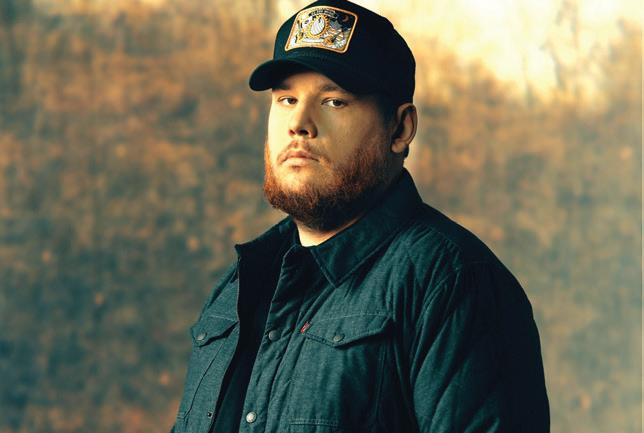
Cuco 3/13, 7:30 PM, Metro b
Cupcakke 3/12, 10 PM, Empty Bottle
Cursive, Neva Dinova 5/19, 8 PM, Bottom Lounge b
Depeche Mode 11/13, 7:30 PM, United Center b
Lara Driscoll Trio, Firm Roots
Duo 3/10, 8:30 PM, Constellation, 18+
Duran Duran, Bastille, Nile Rodgers & Chic 9/1, 7 PM, Huntington Bank Pavilion b
Electric Callboy 9/6, 6 PM, House of Blues b
Elkhorn, Elijah McLaughlin & Jason Toth, Scott Verrastro
5/5, 9 PM, Hungry Brain
Expo ’76 3/24, 9 PM, Hideout
Facs, Cabeza de Chivo, Trouble in Mind DJs 4/7, 10 PM, Empty Bottle
Facs, Dim, Beau Wanzer (DJ set) 4/8, 9 PM, Empty Bottle
Alejandro Fernández, Alex Fernández 10/8, 8 PM, Allstate Arena, Rosemont b
Harley Figueroa 3/15, 8 PM, Maurer Hall, Old Town School of Folk Music Fb
Freedom From and Freedom To featuring Emily Beisel, Ben Billington, Paige Brown, Dalia Chin, Hunter Diamond, and more 4/1, 7 PM, Elastic b
George Freeman’s 96th B-Day Bash featuring George Freeman, Pete Benson, Mike Allemana, and Bernard
“Pretty” Purdie 4/7-4/8, 8 PM, Green Mill
Noel Gallagher’s High Flying Birds, Garbage, Metric 6/27, 7 PM, Huntington Bank Pavilion b
Ghost, Amon Amarth 8/15, 7:30 PM, Huntington Bank Pavilion b
Giolì & Assia 4/22, 10 PM, Prysm Nightclub
Harvey Sutherland 4/26, 9 PM, Sleeping Village
Dave Hollister 5/4, 8 PM; 5/5, 6:30 and 10 PM, City Winery b
Greg Howe with Ernest Tibbs & Joel Taylor 8/26, 8 PM, Reggies Rock Club, 17+
Illville Vanguard presents a tribute to D’Angelo & the Vanguard’s Black Messiah featuring Sam Thousand, Erthe St. James, Amyna Love, Adam Ness, and more 4/12, 8 PM, the Promontory, 18+
Jawny, Wallice 3/17, 8 PM, Thalia Hall, 17+
Joan 5/25, 8 PM, Subterranean b
Max Johnson Trio 3/10, 9 PM, Hungry Brain Kang Daniel 3/9, 7:30 PM, House of Blues b
Kankan, Trapmade Jason, Goonie 4/8, 8 PM, Avondale Music Hall b
Ben Klock 5/20, 10 PM, Concord Music Hall, 18+
Lagoons, Jelly Ellington 3/18, 8 PM, Beat Kitchen, 17+
León Larregui 5/30, 8 PM, House of Blues, 17+ Kim Loaiza & JD Pantoja 3/31, 8 PM, Park West, 18+
Messthetics, James Brandon Lewis Trio 3/15, 8:30 PM, Constellation, 18+
Mike, 454, Niontay, Semiratruth, Hitech 3/18, 9 PM, Lincoln Hall, 18+
Marcus Miller 8/1, 7 and 9:30 PM, SPACE, Evanston b
Model Citizen, Flesh Panthers
6/17, 9 PM, Reggies Music
Joint
Mutilatred, Hanging Fortress, Gored Embrace, Primal Code, Chaosphere 4/1, 8 PM, Livewire Lounge
Pouya, Fat Nick, Kxllswxtch, Terror Reid, Mtm, Lu, South Strip, 7OH2 5/4, 7:30 PM, Patio Theater b
Joe Powers 3/25, 9 PM, Schubas, 18+
Prof, Juice Lord, Bayo, Willie Wonka 6/16, 8 PM, Bottom Lounge, 17+
Redveil, Femdot, D’Mari Harris 4/20, 7:30 PM, Lincoln Hall b
Rinse+Repeat featuring Billa, Aguila, and more 3/17, 9 PM, Sleeping Village
Rob Zombie, Alice Cooper, Ministry, Filter 9/1, 6 PM, Hollywood Casino Amphitheatre, Tinley Park b Saint Motel 4/24, 7:30 PM, Metro b
The Samples 6/9, 8 PM, City Winery b
Eric Schneider 3/15, 8 PM, SPACE, Evanston b
Cal Scruby 5/3, 8 PM, Subterranean, 17+ George Shingleton 6/16, 9 PM, Reggies Music Joint Chris Shuttleworth Quartet 3/17, 9 PM, Hungry Brain Skech185, Jyroscope, Defcee, Rich Jones, Fess Grandiose 3/9, 9 PM, Empty Bottle
So Kill, Prize Horse, Downward 10/21, 9 PM, Metro, 18+ Space Laces 4/21, 10 PM, Concord Music Hall, 18+
Spotlights, Birdhands, Underhand 4/28, 7 PM, Subterranean, 17+
Bruce Springsteen & the E Street Band 8/9 and 8/11, 7:30 PM, Wrigley Field b
Alaina Stacey, Madeleine Kelson 4/7, 7:30 PM, Martyrs’ Suga 5/3 and 5/5-5/6, 7 PM, Allstate Arena, Rosemont b Taylor Swi , Girl in Red, Owenn 6/2-6/3, 6:30 PM, Soldier Field b
Taylor Swi , Muna, Gracie Abrams 6/4, 6:30 PM, Soldier Field b
Tamino, People Museum 4/26,
Shania Twain 7/1, 7:30 PM, Hollywood Casino Amphitheatre, Tinley Park b
Tyrant, Dark Entity, A ermath, Baphomet 5/20, 8 PM, Livewire Lounge
Luke Vibert, DJ Heather, Posthuman, DJ Warp 4/1, 10 PM, Smart Bar
Waco Brothers 3/29, 9:30 PM; 3/30, 8:30 PM, Hideout
Jake Wark & Bill Harris; Peter Maunu, Kent Kessler, and Julian Kirshner 3/30, 8:30 PM, Elastic b
Warmduscher 3/24, 9 PM, Sleeping Village
Keith Washington 4/7, 8 PM, City Winery b
Nik West 7/5, 8 PM, City Winery b
Yellowcard, Mayday Parade, Story of the Year 7/16, 7 PM, Huntington Bank Pavilion b Jeremy Young, Lula Asplund & Máo Chén Huì, Big Pal with Emily Craver 3/18, 8 PM, Elastic b
Your Stepdad, Ace Santana02, Doxia 3/10, 9 PM, Schubas, 18+
Beyoncé 7/22-7/23, 7 PM, Soldier Field, show added b
Cowboy Junkies 4/6-4/7, 8 PM; 5/14, 7 PM, Maurer Hall, Old Town School of Folk Music, 4/6-4/7 sold out b
Kevin Kaarl 5/5, 7:30 PM; 5/7, 7 PM, the Vic, show added b
Kali Uchis, Raye 5/15-5/16, 7 PM, Aragon Ballroom, 5/15 sold out, 5/16 added b
Radwimps 4/24, 7:30 PM, Riviera Theatre, venue changed b
RBD 9/7-9/8, 7:30 PM, Guaranteed Rate Field, show added b
Tank & the Bangas with the Chicago Philharmonic 9/30, 7:30 PM, Auditorium Theatre, rescheduled b v

THIS WEEKEND is a big one for Ensemble dal Niente vocalist Amanda DeBoer Bartlett . On Sunday, February 26, she’ll sing with the ensemble as they close the 2023 Frequency Festival at Constellation. And on Friday, February 24, she’ll release a solo album of folk- inspired tunes, The Bones Still Glow , that she’s been writing for 16 years. Bartlett describes the songs as having “traveled along with me as a young, touring classical musician” and “chronicled my transformation into motherhood.” As befits an artist capable of improvising as well as performing demanding compositions, Bartlett covers a wide range with her songwriting: it includes glowing country ballads (such as “Measure My Life”) as well as more unsettled tunes (“Cobra,” which bursts with dark electronic effects). Bartlett’s accompanists include album coproducer Dana Murray (drums, synthesizers) and fellow Ensemble dal Niente members Jesse Langen (guitar) and Emma Hospelhorn (flute), who highlight Bartlett’s lovely, ringing tones with engaging textures.
Chicago drone masterminds Bitchin Bajas have a so spot for Sun Ra, whose work they reinterpreted for the 2021 album Switched On Ra . According to Reader contributor Steve Krakow, Bitchin Bajas have performed the material from that album in Chicago just twice, but on Thursday, February 23, the band will revisit the Switched On Ra material at the Music Box. Their set precedes a screening of the 1974 avant-garde sci-fi film Space Is the Place , cowritten by and starring Ra. Bitchin Bajas play at 7:30 PM, and the screening is at 8:45 PM.
Last month, Chicago singer, songwriter, and poet Kara Jackson dropped the mesmerizing, folky single “Dickhead Blues” b/w “Brain,” which cements her status as one of the best young musicians in town. On Friday, February 24, Jackson and local psych-soul artist Jada-Amina open for Chicago native KeiyaA at Sleeping Village —J.R. NELSON AND LEOR GALIL
Got a tip? Tweet @Gossip_Wolf or email gossipwolf@chicagoreader.com.





Recommended and notable shows and releases with critics’ insights for the week of February 23
Roscoe Mitchell Trio 7 PM, the Promontory, 5311 S. Lake Park Avenue West, $22-$42 b
Roscoe Mitchell is one of the last surviving titans of a pioneering generation of fearlessly experimental jazz musicians. At age 82, this Renaissance man continues to push the envelope in several directions. Mitchell’s resumé as a saxophonist, flutist, and percussionist is legendary among international connoisseurs of the avant-garde: he was a founding member of the Art Ensemble of Chicago and the Sound Ensemble, and he’s played on so many other recordings that I can’t even scratch the surface here. Less well-known is Mitchell’s talent as a painter: his latest gallery exhibit, “Keeper of the Code: Paintings 1963-2022” (at Corbett vs. Dempsey through March 11), is his fi rst solo show devoted exclusively to visual art, and its intensely detailed, vividly evocative pieces span his entire musical career. (Go see it at all costs.) At the exhibit’s opening event in January, Mitchell performed on saxophones, percussion, and various toys and devices with his long-running Space Trio (which now features reedist Scott Robinson and vocalist Thomas Buckner) and guest flutist Robert Dick. That group is one of many to which Mitchell has lent his visionary talents and creativity over the years.
CHICAGO JAZZHEADS WOULD KNOW the sound of Greg Ward’s Rogue Parade anywhere, and not just because the band’s instrumentation is distinctive: drums, electric guitar, bass, and alto saxophone. There’s also the baroque compositional style that the bandleader and alto saxophonist applies to this galvanic combination, which his collaborators—drummer Quin Kirchner, bassist Matt Ulery, and guitarists Matt Gold and Dave Miller—execute with heart-thumping vigor and needlepoint precision. Rogue Parade marched from Chicago into broader critical acclaim with 2019’s Stomping Off From Greenwood, and this year they’ve put out a highly anticipated and worthy successor: Dion’s Quest, also the inaugural release of Ward’s new label, Sugah Hoof. The compositions on Dion’s Quest are every bit as intricate and prismatic as those on Stomping Off From Greenwood, as demonstrated by the likes of “Noir Nouveau,” with its reverie of complex meters, and the rough-hewn “Blues of the Earth.” It all builds to the ecstatic, rousing “Ocean of Faith,” an eight-minute benediction that evaporates unexpectedly into synth shimmers. Gold and Miller are nonpareil soloists; for proof, look no further than the rock-driven “Beware of the Oh EEE’s.” But their virtuosity shines just as brightly in supporting roles—sometimes augmenting the rhythm section’s driving grooves, sometimes subtly doubling Ward so that his sax lines pop with extra prominence and color. This Empty Bottle show celebrates the release of Dion’s Quest, and Rogue Parade will be preceded by two openers: guitarist and local creative-music stalwart Bill MacKay and Chicago bassist Junius Paul with his trio. —HANNAH
Mitchell even proved himself a polymath during a recent interview: he was painting at his home in Madison while we spoke. “There’s something going on in my life right now—it’s hard for me to keep up,” he said. “It’s like I need two lifetimes to do all I want to do, but I’m just going to go with it. I know it’s insane, but I can’t stop.” Mitchell also discussed his powerful friendship with pianist Muhal Richard Abrams, which helped shape his philosophies around improvisation and the evolution of musical relationships. Abrams, who passed away in 2017, led a group called the Experimental Band that Mitchell joined in 1961; that ensemble formed the nucleus of the Association for the Advancement of Creative Musicians at its launch in 1965. Mitchell marveled at how, even a er long stretches apart, he and Abrams could always pick up where they’d le off musically. Mitchell has also been collaborating for decades with the members of the trio he’s leading here: percussionist Vincent Davis for 30 years or so and bassist Junius Paul for at least 20. (Mitchell doesn’t have a head for those numbers— and I feel that—so I’m relying on what his partner said in the background of the call.)
That trio’s Promontory set will combine Mitchell’s composed pieces with improvisation—not least because the music he writes leaves room for spontaneity. “I’m not going to try and do the same thing over and over again,” Mitchell said. “I fare better when I reach around to what’s floating around the night I am playing, and that is always changing— every minute is different.” Whether you’re a longtime fan or seeing the trio in action for the first time, you’re in for a cosmic voyage into the outer regions, grounded by the sort of solid foundation that sustains all the best relationships, musical and otherwise. —STEVE
KRAKOW
Dear Silas Slot-A and Neak open. 10 PM, the Promontory, 5311 S. Lake Park Avenue West, $20$40. 21+
When Jim Beaugez wrote about the hip-hop scene in Jackson, Mississippi, for Rolling Stone in September, he called rapper, singer, and trumpeter Silas Stapleton III the biggest act in the city. Stapleton performs and records as Dear Silas, and his fluid flow, breezy melodic sensibility, and irrepressible optimism help him stand out on a national stage, not just in his hometown. On last year’s It’s Giving Self Love! (SND Village), he raps like he’s in a crowd of friends and trying to get them to dance or laugh. Sometimes he can do both, like on “Groceries,” where he sails through the self- checkout and ribs the person shopping with him about buying too much to carry themselves; the carefree air he adds to his lilting, half-sung delivery is a perfect fit for the instrumental’s frisky, wispily tuneful flute loop and gently seesawing groove. Silas digs into a grab bag of styles throughout It’s Giving Self Love! , including quiet storm R&B (“I Ain’t Stressin Today”), gospel (“Thank You”), and minimal, dreamy pop-rap (“I Love Me”), so that the album as a whole could double as a portfolio demonstrating his range of skills. On the best songs—including “Insecure,” a syrupy-smooth rumination punctuated with funky keyboard runs—he glides between rapid rapping and suave singing so smoothly that he sounds ready for the biggest stages he can find. —LEOR
GALILFree Range Minor Moon and Henry True open. 8 PM, Schubas, 3159 N. Southport, $15, $13 in advance. 18+
Eighteen-year-old Chicago singer, songwriter, and guitarist Sofia Jensen started working on the material for Free Range’s new debut album, Practice (Mick Music), about four years ago. Their lyrics confront and reflect on youthful confusion and alienation, and the feelings that inspired them were (and clearly still are) intense—but Jensen communicates with unwavering control and confidence through their tender indie rock. They express intimacy and vulnerability with ambling arrangements, gentle playing, and sure-handed precision. Jensen’s two bandmates, drummer Jack Henry and bassist Bailey Minzenberger (the latter also plays in Friko, and both are members of Morinda), support Free Range’s melodies with understated care or ratchet up the intensity when a song requires a stronger hand. “Growing Away,” which deals with Jensen’s decision to get sober, falls into the latter category—it’s one of the most hopeful, energized songs on the album. Jensen’s rootsy guitar strumming and soothing singing give Practice an irresistible gravitational pull and a disarming, personable charm—you’ll be won over before you’ve even listened all the way to the end. —LEOR GALIL

Greg Ward’s Rogue PArade See Pick of the Week at le . The Junius Paul Trio and Bill MacKay open. 10 PM, Empty Bottle, 1035 N. Western, $16. 21+
Juan De Marcos & the Afro-Cuban All-Stars 7:30 PM, Dominican University, Lund Auditorium, 7900 W. Division, River Forest, $35$55. b
There are unlimited reasons to love Cuban music, but what draws me the most is the relentless, resilient joy at its heart. The island’s grooves have a century-long history of sparking international music crazes, and it’s hard to imagine the panorama of contemporary music without the infl uences of artists such as Pérez Prado or the Buena Vista Social Club. Havana-born guitarist, composer, and producer Juan de Marcos González has dedicated his life to sharing the classic gems of Cuban music with the world. He served as the first musical director of the Buena Vista Social Club project, and he’s led the Afro-Cuban All Stars since 1996. As he told me over the phone, he wants to give Cuban music “the place it deserves” in music history.
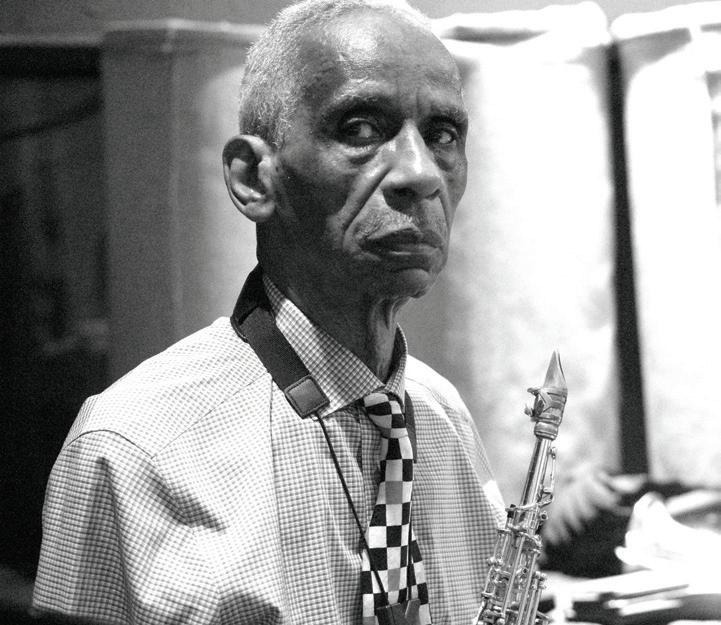
In performance, González leads the Afro-Cuban All Stars in a lovingly chosen selection of seminal Cuban tunes, deployed in elegant orchestral arrangements and played with impeccable mastery and flair. The group’s debonair vocals glide in interplay with horns and percussion played bright and tight. González also mentioned that Cuba has about 75 distinct genres of popular music, and many of them—son montuno, timba, guajira, danzon, cha-cha-cha, mambo, bolero—will likely make an appearance at this concert, along with touches of Abakuá beats and Congolese rhythms.
González introduces each of the tunes with stories and context, so audiences are sure to have learned something new about Cuban music by the time the concert is over. And as the legendary musician reminded me in our interview, it’s important “to wear your best, best, very best dance shoes”—because dancing is always part of the fun.
—CATALINA MARIA JOHNSONHagop tchaparian Junior Boys headline. 8 PM, Metro, 3730 N. Clark, $25, $21 in advance. 18+
As a teenager in the late 90s, Hagop Tchaparian played in a hyped-up London pop-punk band, Symposium, whose dizzying rise and fall le its five members saddled with debt in excess of a quarter million dollars. In the early 2000s, as Tchaparian rebuilt his life, he took gigs flyering outside London nightclubs, and dance music provided a salve. People in the scene embraced him, and some of them employed him—he became a tour manager for Hot Chip and Four Tet, aka Kieran Hebden. In October 2022, Hebden’s label, Text, released Tchaparian’s long-in-the-works solo debut, Bolts. Tchaparian long ago developed a habit of using his phone to make field recordings, and Bolts incorporates audio from his globetrotting over the past 15 years—a noisy taxi in Jordan, a rainforest in New Zealand, a fireworks display at a soccer match in Lebanon. The most moving and pulse-quickening samples are rooted in his Armenian heritage. Some were made in Anjar, a small Lebanese town near the Syrian border where
continued from p. 49
Tchaparian’s father lived as a child before coming to London as a teenager—it’s largely populated by Armenian refugees and their descendants.
On the single “Right to Riot,” Tchaparian builds tension by stacking layers of synths and programmed percussion onto a frenetic drum loop played on the dhol, then dramatically shifts the song’s energy by introducing the nasal wailing of an Armenian double reed called a zurna. Most of the percussion drops out when the zurna comes in, so that the horn opens up the song like a weightli er in a mosh pit—and Tchaparian maintains the track’s relentless techno drive even when he strips away everything but a wavering ribbon of synthesizer. Tchaparian’s dance music knows few boundaries, and he segues into whatever microgenre suits him, jumping from the borderline ambience of “Jordan” straight to the restless minimal house of “Round.” Listening to Bolts persuades me that Tchaparian couldn’t have finished it any faster—he must’ve needed more than a decade to make sense of his life and all the travels, adventures, reversals, and triumphs that brought him here. And as busy and frenzied as Bolts can get, Tchaparian’s grip on the flow of its rhythms never falters during the journey. —LEOR
GALILCicero Blake’s 87th birthday Willie White, Mzz Reese, Theo Huff, and Jeannie Holiday will perform in honor of Blake, and Blake himself will likely sing a few songs. 8 PM, Blue Note, 1715 Roosevelt, Broadview, $20 at the door. 21+
Cicero Blake’s career spans the trajectory of modern soul music from doo-wop to contemporary southern soul-blues. Blake was born in Jackson, Mississippi, in 1936, though many biographies incorrectly state 1938. A er his family relocated to Chicago in the 1950s, he attended Marshall High School, where he cofounded the Goldentones, a doo-wop group that evolved into the legendary Kool Gents and also provided a springboard for well-known soul singer Dee Clark. Blake, meanwhile, went on to become the featured vocalist in the show band led by pianist Sonny Thompson before launching his own recording career in 1963. Over the next decade or so, Blake appeared on various local and regional labels, and then in 1978 he released the song that earned him something like soul-blues immortality: “Dip My Dipper.” This lascivious ode to illicit eros revitalized Blake’s career and played a major role in codifying the hybrid style known as southern soul or soul-blues: a blend of bluesy emotionality, playful adult carnality, and deep-soul vocal stylings with an R&B sheen. Though health problems have curtailed Blake’s public appearances in recent years, he remains one of our most beloved musical elder statesmen; he was one of several local soul pioneers honored with a special tribute at the 2022 Chicago Blues Festival.
For Blake’s 87th birthday, a multigenerational lineup of blues and soul-blues stylists has been assembled to fete him. Veteran Willie White has a thick, muscular voice, augmented with a tightly controlled vibrato and an armamentarium of shadings; he can convey deep feeling with choked gasps and gruff, blues-inflected murmurs, and when he’s built enough tension he’ll ascend into soaring testimonials of desire and release. Mzz Reese has become one of the most in-demand singers on the local circuit with her sultry, emotionally rich vocals and
onstage charisma; her signature song, “Cookies,” a sexual throwdown in the vein of her idol Denise LaSalle, is the title tune of her self-released 2015 debut CD (a follow-up release is in the works). Theo Huff ’s voice recalls Johnnie Taylor’s in his prime, and he sounds like a world-toughened veteran despite his relative youth. His resonant timbre, flamboyant onstage demeanor, and sassy call-and-response churchiness invariably get even Chicago’s most soul-seasoned clubbers to their feet—and when she’s in the house, that includes Ann Davis (widow of Tyrone Davis), in a sure sign that a torch is being passed. Jeannie Holliday commands a remarkable range—at her best, she sounds almost like a soulblues Minnie Riperton—and her repertoire includes the usual southern soul standards as well as challenging neosoul and pop tunes such as Mark Ronson and Bruno Mars’s “Uptown Funk” and T.L. Williams’s “Gettin’ Mo’ Money Than You,” a range that highlights her technical virtuosity and broad emotional appeal.
—DAVID WHITEISBill Callahan Pascal Kerong’A opens. 8 PM, Thalia Hall, 1807 S. Allport, $35-$45. 17+
Right before COVID-19 hit, Bill Callahan was on a roll. A er enduring five years of writer’s block, he’d made two strong albums infused with a newfound positivity that reflected the pleasure he took in family life. His lockdown years weren’t even so bad. In a recent interview with online publication Loud and Quiet, he described how domesticity insulated him from the worst of the pandemic—and how a series of remotely recorded cover tunes he made with

Bonnie “Prince” Billy and a host of Drag City labelmates kept him engaged with music throughout the long months when the concert industry was shut down. Nevertheless, he picked up on the country’s dystopian mood, and on his latest LP, YTI⅃AƎЯ, he confronts it. You can feel ripples of that darkness in “Bowevil,” which invokes memories of an earlier plague that scourged Callahan’s home state of Texas. And the gallows humor he used to flex when he performed as Smog reappears on “Everyway,” in which shipwrecked sailors who try to keep warm by putting their hands into a dead animal’s guts comfort themselves by observing, “At least we’re all in this horse together.” But while Smog songs simply described alienation, Callahan’s new work consciously tries to turn the bleakness of reality around. In “Natural Information,” for example, he finds an antidote to data bombardment in strolls with his baby daughter, and the tune drives the point home with a jubilant brass arrangement. Reports from Callahan’s west-coast shows last fall suggest that the improvisational chops of his band—which includes longtime guitarist Matt Kinsey, Dirty Three drummer Jim White, and Chicago-based tenor saxophonist Dustin Laurenzi—will induce some positive vibrations of their ownt.
—BILL MEYERSelf-Titled arriver.bandcamp.com/album/azimuth
Genre-bending Chicago metal quartet Arriver formed in 2006 with a lineup that had plenty of experience with a varied tonal palette: Dan Sulli-

van and Rob Sullivan contributed to Songs: Ohia and Magnolia Electric Co., while Dan McAdam and Joe Kaplan had played in Viza-Noir. The group are known for concept albums with historical subjects; 2012’s Tsushima documented a key sea battle in the Russo-Japanese War, and 2016’s Emeritus gave a ritualistic spin to the Chernobyl disaster. Before the pandemic, Arriver had their brand-new fulllength, Azimuth, mostly written, but when they realized that finishing it was going to take much longer than they’d planned, they released a single from their album sessions in July 2020: “Holy Glow,” a cover of underrated 1980s California psych band the Ophelias. The recording showed a welcome glimpse of the band’s playful, whimsical side—as well as a blazing spark of life just waiting to burst from the lava pit.
Arriver fan that spark into a five-alarm fire on Azimuth. Unlike its predecessors, the album focuses not on a historical event but on a personal journey. In a certain context, “azimuth” refers to a measurement of the position of a celestial object (though it also sounds plausibly like a demon’s name from an old grimoire), and the ten-minute title track is the climactic culmination of an ascent to cosmic godhood whose instrumental and vocal firepower support such a heady claim. “Only On,” released with a video in January, embarks on a taut, tense journey through despair with rough, growling vocals and a repeating clean guitar line that climbs stairs like Sisyphus in an M.C. Escher drawing. The compact “Constellate” is a mosh-pit monster that takes a wild ride through time and space; a dazzling fingerpicked solo erupts just past the halfway mark, and drum-and-guitar interplay whips up shivery excitement as the track heads to a close. And “Carrion Sun” is a heavy, shambling trek through scifi horror that opens with a huge, galloping riff and relentless drums. The digital version of Azimuth is out March 4, but the limited-edition vinyl (featuring MacAdam’s striking cover art) could arrive as late as August, thanks to endemic vinyl-processing backlogs. Arriver played their first show since 2019 last fall, but fans won’t have to wait long to hear the new songs live; the band celebrate Azimuth with a release party at the Burlington on Saturday, March 11.
—MONICA KENDRICKNumero Group
laraajinumero.bandcamp.com/album/segue-toinfinity
Anyone who’s written off new age music hasn’t heard Laraaji. The multi-instrumentalist and composer (born Edward Larry Gordon) is recognized as an ambient pioneer because his 1980 album, Ambient 3: Day of Radiance , was produced by Brian Eno—in fact it’s the third release in Eno’s famous ambient series. But Laraaji, a proud spiritualist, had already made his recording debut in 1978 with the hypnotic, zither-drenched Celestial Vibration
That record was the result of Laraaji’s audio experiments in healing and happiness, which he performed in New York yoga and meditation classes as well as in public spaces, including parks and sidewalks. Recordings from this era provide the source material for Laraaji’s latest release: a four-LP collection of freshly unearthed recordings (a college student stumbled on them while browsing eBay last
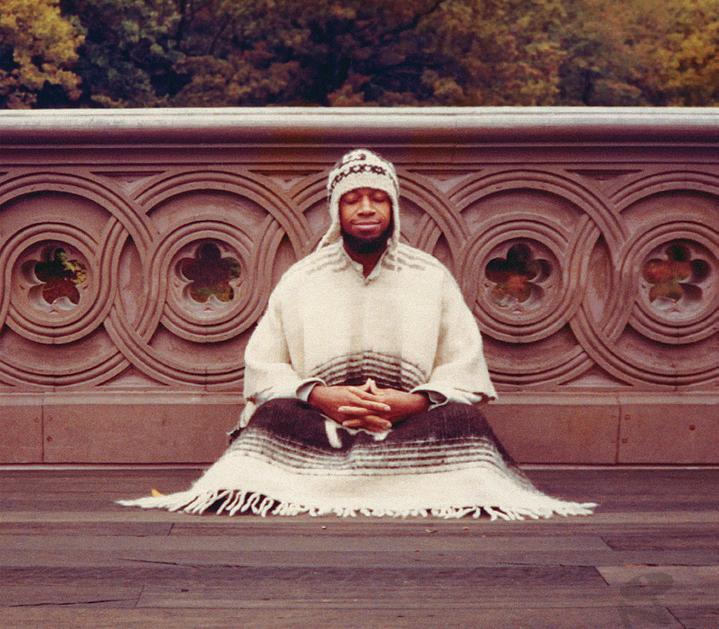
year) issued by the Numero Group under the title Segue to Infinity. Extensive liner notes and archival photos contextualize the composer’s beginnings.
Laraaji’s lifelong belief in the healing power of music grew from a childhood spent singing and performing in the Baptist church. After pursuing classical piano and composition at Howard University in the 60s, he spent the 70s exploring Eastern mysticism and allowing those ideas—along with their associated rhythms and song structures—to infuse his work. In the four decades since he traded his guitar for a zither in 1978, he’s developed a robust and devoted following of experimental music enthusiasts and new age practitioners.
Longtime Laraaji fans will find in Segue to Infinity a delightful return to some of the musician’s signature sounds: shimmering zithers, sprightly mbiras, and curious flutes in gentle but animated conversation. New listeners will find themselves drenched in a three-hour honey bath distilled from everything that makes the oft-maligned genre of new age music exciting. Using his expertise in classical composition, improvised jazz, and funk guitar, Laraaji creates a captivating world that feels breezy and ethereal—a testament to the vast imagination of an artist who’s gone on to release concept albums centering subjects such as reiki and the color orange. Through his varied and magical compositions, Laraaji has consistently emphasized the potential of listening to transform us. —MICCO CAPORALE
Kendrick Scott Trio, Corridors Blue Note store.bluenote.com/products/kendrick-scottcorridorsKendrick Scott’s long-running five-piece ensemble, Oracle, is unrelentingly contemporary in its sound, in part thanks to the inclusion of an electric guitar. But arranging music for a smaller contingent of players requires a different tack. On Corridors, Scott—a drummer whose credits include work with vocalist Kurt Elling and trumpeter Terence Blanchard—scales down to a trio with tenor saxophonist Walter Smith III and bassist Reuben Rogers to offer a selection of new, multi dimensional music. “A Voice Through the Door” features a sedate main statement by Smith, a longtime Scott collaborator who’s set to issue his Blue Note debut in April. The song is airy enough for the drummer’s decaying cymbal sound to serve as a main character, and it’s all the more intriguing for the group’s restraint. Slotted into the middle of the album is a swinging, full-throated take on “Isn’t This My Sound Around Me?,” a composition originally included on a 1994 duo release by vibraphonist Bobby Hutcherson and pianist McCoy Tyner. The second half of Corridors —or the song’s titles, at least—point to some kind of promised future. Given the sparse setting, Smith is the trio’s main voice, and his unfaltering tone and ability to unfurl endless lines defines the music, even as “Your Destiny Awaits” showcases Scott’s funkiest drumming on the album. On the final track and capstone, “Threshold,” the bandlander takes his time with a well-textured solo that makes use of the kit’s full dynamic range. The song shi s in pace and feeling more than in melody, a fi tting closer for an album led by a drummer capable of building monumental swing from basic parts.
—DAVE CANTOR v Kendrick
JOBS
Software Developer
Preferred Risk Insurance Services Inc.
Bedford Park, IL
Performing product scoping and discovery, delivering hands-on technical input, and helping translate user features into system design; Working with software development team to pair programming and support deliverables in production; Developing the required functions/ features on the InsuranceNow platform; Driving the data migration from legacy systems to the new platform through data cleansing, data preparation and test bed creation. Must have a Master’s degree in Computer Science or a related field. Must have Guidewire Developer Certification. Must have two (2) years of experience as a Software Developer, Software Engineer or Application Development Consultant. Must have two (2) years of experience with InsuranceNow, SaaS Production Environment, REST API and JS coding. Qualified candidates show email their resumes to NSmith@PRISCORP. net and reference code SD0123.
to Financial Analysis). AND must possess: 2 yrs exp conducting due diligence in investment transactions;
2 yrs exp conducting customer & competitor research;
2 yrs exp developing financial models & forecasts; 2 yrs exp analyzing financial valuations using discounted cash flow analysis, accretion/ dilution analysis, & comparable transactions analysis; 2 yrs exp working w/ credit terms & agreements; 2 yrs exp analyzing complex debt & equity securities structures; & 2 yrs exp in analyzing investment transaction terms. 2 yrs experience working w/ MS Excel & MS Power BI; 2 yrs exp working w/ financial DBs such as Bloomberg, CapIQ or LexisNexis; 2 yrs exp working w/ accounting software such as QuickBooks or Peachtree; & 2 yrs exp working w/ ERP software such as Oracle, Microsoft Dynamics GP, or SAP. Resume to Wind Point Advisors, LLC at WPPrecruiting@ wppartners.com.
medline.taleo.net/careersection/md_confidential/ jobapply.ftl?lang=en&job=QUA0101KZ
District Sales Leader
ENGINEERING

Yum Connect LLC. has an opening in Chicago, IL for Software Engineer to design and implementation of client applications that will utilize API and 3rd party vendors. 50% Telecommuting is permitted. Ref job code C#6010276 & mail resume to: YRSG, Attn: HR, 3301 Stober Road, Louisville, KY 40213.
Atoll Pre-Sales Engineer Atoll Pre-Sales Engineer MS deg in Electronics Eng, Telecomm\’n Eng, Telecom & Comp Networks, or closely reltd deg & 2 yrs exp as Eng in wireless comm\’n industry. Direct resumes to: Nicolas Dubois at job_us@forsk.com, Forsk US Inc 200 South Wacker Dr., 31st Flr, Chicago, IL 60606
JOBS GENERAL PROFESSIONALS & SERVICES CLEANING RESEARCH MATCHES ADULT SERVICES WANT
Vice President, Private Equity InvestmentsAnalyze corporate M&A & fundraising efforts. Engage in eval, pricing & structuring of investment securities. Compile statistical data & conduct analysis; Dvlp financial forecasts & models. Oversee completion of quality of earnings analysis & eval pro-forma tax consequences. Manage performance of 3rd party & due diligence providers. Work closely with attorneys for transaction documentation. Work is at Employer’s Office (676 N. Michigan Ave., Suite 3700, Chicago, IL 60611) with ten to twelve business trips a year throughout the U.S. that last 1 to 2 days per trip. Min reqs: Bachelor’s in Business Admin, Econ, Finance or closely rltd field + 5 yrs exp in occupations rltd to Financial Analysis (as equivalent, the employer will accept a Master’s Degree in Business Admin, Econ, Finance or closely rltd field + 2 yrs exp in occupations rltd
Position available in Chicago, IL for a District Sales Leader. Increase business revenue and gross profit by generating new customer buying accounts through managing a sales channel including vendor, distributor, and value-add reseller (VAR). Drive net-new software and hardware business. Create and execute a prospecting strategy to acquire new clients and develop new business relationships every quarter within assigned territory. Perform strategic account planning, including industry research, competitive insight and client forecasts. Leverage the Customer Relationship Management (CRM) and company sales methodology to effectively manage accounts, opportunities, and pipelines. Leverage industry and company knowledge to identify customer business problems, and address those opportunities through the solution sale of software, hardware, and services. Engage internal resources to create and implement customized solutions for the client to provide best in class service. Up to 20% domestic travel required. May telecommute. Apply: Mail resumes to Alisha Panavas at Softchoice Corporation at 680 Engineering Drive, Suite 100 Norcross, GA 30092. Please reference job ID: SC2022CM
Multiple Openings Medline Industries, LP has multi open’gs in Northfield, IL for: A) Manager IS Applications (eCommerce Operations) to lead a team that supports & maintains e-comm systms. No trvl; WFH bnft avail. Apply at: https:// medline.taleo.net/careersection/md_confidential/ jobapply.ftl?lang=en&job=INF0100RK B) Sr. IS Business Systems Analysts (Managed Care) to translate biz issues into IT reqmnts for solt’n dsgn & test’g. No trvl; WFH bnft avail. Apply at: https://medline. taleo.net/careersection/ md_confidential/jobapply.ftl?lang=en&job=INF0100RD C) Sr. Full Stack Developers to dvlp, integrate, & deliver apps using front-end, backend DB, & host’g tools. No trvl; WFH bnft avail. Apply at: https://medline. taleo.net/careersection/ md_confidential/jobapply.ftl?lang=en&job=INF0100RJ D) Project Managers R&D to guide dvlpmnt of med dvcs, dietary supplmnts, cosmetics, &/or OTC/ANDA/ NDA drugs to manage & ovrsee prod dvlpmnt projs. Dom & int\’l trvl req’d up to 10%. WFH bnft. Apply at: https://
yrs exp in occupations rltd Market Research Analyst; & 2 yrs exp in each of the following: Designing methods to collect mktng data; Gathering & organizing mktng data including pricing, sales, & distribution methods through online dbs & surveys; Analyzing industry trends, customer behaviors & competitive intelligence using mktng analytics software such as Innography, PatSnap, Google Analytics, or Crunchbase; Design mktng strategies to position a product or service; Preparing forecasts for mktng campaigns; Preparing mkt research reports that track the results of mktng campaigns & competitor analysis; Working with followings: digital mkt research dbs such as Bloomberg, Edgar, or Capital IQ; mkt analytics software such as Google Analytics, Innography, or PatSnap; CRM software such as Salesforce, Monday.com, or Pipedrive; Spreadsheet software such as MS Excel or Google Sheets; & Presentation software such as MS PowerPoint or Google Slides. Send resume to J.S. Held LLC at applications@jsheld.com.
working w/ credit terms & agreements; 2 yrs exp analyzing complex debt & equity securities structures; & 2 yrs exp in analyzing investment transaction terms. 2 yrs experience working w/ MS Excel & MS Power BI; 2 yrs exp working w/ financial DBs such as Bloomberg, CapIQ or LexisNexis; 2 yrs exp working w/ accounting software such as QuickBooks or Peachtree; & 2 yrs exp working w/ ERP software such as Oracle, Microsoft Dynamics GP, or SAP. Resume to Wind Point Advisors, LLC at WPPrecruiting @wppartners.com.
Nail tech and stylist wanted Beautiful salon located in the Gold Coast of Chicago, on Lake Shore Dr. looking for a nail tech and hair stylist. We are open Tuesday and Saturday 8:00-4:00 and Wednesday thru Fridays 7:30-6:00. Looking for someone who is looking to build and if you have a following they are most welcomed. To set up a interview call Kelli or Chris at 312-664-8710, Salon Duo
Office, BTEQ, PL/SQL, SQL Assistant, SQL Plus, SQL Loader, Business Objects, SSIS, Informatica Power, Tableau, Erwin, Oracle Designer, ER/Studio, Microsoft SQL Server, Teradata, Oracle, Netezza, Postgress SQL, & HIVE req. Travel or relocation to various unanticipated worksites throughout US req. Telecommuting allowed. Send resumes: james@cylontechnology. com
Have you had an unwanted sexual experience since age 18? Did you tell someone in your life about it who is also willing to participate?
Women ages 18+ who have someone else in their life they told about their experience also willing to participate will be paid to complete a confidential online research survey for the Women’s Dyadic Support Study. Contact Dr. Sarah Ullman of the University of Illinois at Chicago, Criminology, Law, & Justice Department at ForWomen@uic.edu, 312-996-5508. Protocol #2021-0019.
help, we can help to organize your move. We can organize and clean for the deceased in lieu of having the bereaved needing to do the preparation to sell or rent the deceased’s home. We are absolutely not judgmental; we’ve seen and done “worse” than your job assignment. With your help, can we please help you? Chestnut Cleaning Service: 312-332-5575. www. ChestnutCleaning.com
MWM DOM 52 SEEKS SUB FEMALE 50+ MWM DOM 52 seeks submissive female 50+ who needs on going bare bottom spanking bondage pleasure & punishment oral pleasure & will train & seeking discreet LTR I can host & discreet call/text-224-292-9899 dragonmastercs69@ gmail.com.
Table Tennis Anyone?
Huntley, IL) Hiwin Corporation seeks Electrical Engineer w/ bach or for deg equiv in EE & 2 yrs exp in job offer or EE. Must have crswrk or exp in elec mach, mot ctrl, autom, robtics & mechatr, AC servo motrs, stepper mtrs, prgrm w mot ctrl, ntwrk comm, mechatr sys & webst des (FE/ BE). Apply to HR: 12455 Jim Dhamer Drive, Huntley, IL 60142 or https:// www.hiwin.us/company/ careers/
Senior Market Research Analyst – Analyze companies’ rankings, IP transaction, marketing data globally & marketability of IP transactions. Design marketing IP strategies. Telecommuting permitted 90% of time & work from company HQ office – 200 W Madison St, Chicago IL 10% of time. Must reside within commuting distance from HQ. ** Travel internationally 1-2x/yr for 2-3 wks per trip. Reqs: Masters in Marketing, Business Admin, Mngmt, TV Mngmt, IP Mngmt, or a closely rltd field plus2
Vice President, Private Equity Investments –Analyze corporate M&A & fundraising efforts. Engage in eval, pricing & structuring of investment securities. Compile statistical data & conduct analysis; Dvlp financial forecasts & models. Oversee completion of quality of earnings analysis & eval pro-forma tax consequences. Manage performance of 3rd party & due diligence providers. Work closely with attorneys for transaction documentation. Work is at Employer\’s Office (676 N. Michigan Ave., Suite 3700, Chicago, IL 60611) with ten to twelve business trips a year throughout the U.S. that last 1 to 2 days per trip. Min reqs: Bachelor’s in Business Admin, Econ, Finance or closely rltd field + 5 yrs exp in occupations rltd to Financial Analysis (as equivalent, the employer will accept a Master’s Degree in Business Admin, Econ, Finance or closely rltd field + 2 yrs exp in occupations rltd to Financial Analysis). AND must possess: 2 yrs exp conducting due diligence in investment transactions; 2 yrs exp conducting customer & competitor research; 2 yrs exp developing financial models & forecasts; 2 yrs exp analyzing financial valuations using discounted cash flow analysis, accretion/dilution analysis, & comparable transactions analysis; 2 yrs exp
Chief of Staff. Chicago. BBA or Economics + 2yrs of in-job exp or 2yrs of exp in Management Operations. Apply: HR, Spot Meetings, 2147 W. Thomas St., Chicago, IL 60622
Neocol Inc. seeks Project Manager w/ bach or for deg equiv in Proj Mgmt or Eng Mgmt & 2 yrs exp in job offer or Proj Mgmt delivering Salesforce. Must utilize wtrfall & agile methodol. May reside anywhre in US. Telecom perm. Apply to HR: 20 W. Kinzie St., Chicago, IL 60654
Neocol Inc. seeks Associate Director, Integrations w/ bach or for deg equiv in CS, SE, CIS, math or rel fld & 3 yrs exp in job offer or MuleSoft Archit, MuleSoft Devp or w/MuleSoft. Also accepts 3 yr deg or studies/crswrk in CS, SE, CIS, math or rel fld & 4 yrs exp in job offer or as MuleSoft Archit, MuleSoft Devp or w/ MuleSoft. Must have exp in data integ & migration principles, & data archt des. Telecom perm. May reside & wrk anywre in US. Apply to: HR, 20 W. Kinzie St., Chicago, IL 60654
Data Modeler Cylon Technologies, Inc. (Chicago, IL) seeks Data Modeler. Design strategies for enterprise database systems & set standards for operations, programming, & security.
Req: MS in Comp Sci, Info Sys or rel/equiv. 2 yrs exp as Data Modeler or rel. 2 yrs exp w/ TOAD, MS

CLEANING SERVICES
CHESTNUT ORGANIZING AND CLEANING SERVICES: especially for people who need an organizing service because of depression, elderly, physical or mental challenges or other causes for your home’s clutter, disorganization, dysfunction, etc. We can organize for the downsizing of your current possessions to more easily move into a smaller home. With your
First off table tennis is not code for anything. I\’m looking for a regular table tennis partner Mon, Wed and/or Fri, after 3 p.m. to play at KillerSpin on Clark Street downtown. This is for serious practice. I was a 1200 rated player 20 years ago when I last played mrod3950@gmail. com.
Danielle’s Lip Service, Erotic Phone Chat. 24/7. Must be 21+. Credit/ Debit Cards Accepted. All Fetishes and Fantasies Are Welcomed. Personal, Private and Discrete. 773-935-4995


















My boyfriend wants to try pegging, and says he wants the “whole experience.”


 By DAN SAVAGE
By DAN SAVAGE


Q : My boyfriend of six months wants to try pegging and I’m down. But he wants “the whole experience,” which means sucking the dildo too. That raises a red flag for me. I know how this sounds before I even ask, so please forgive me if this question is insensitive. But does his desire to suck on the dildo indicate gay or bi tendencies? He says he’s not attracted to men, but he will sometimes



make remarks about a “good looking guy” he saw. He also told me he had a threesome in his early 20s with a married couple and that the husband sucked him off. He says he hasn’t done anything like that since— and he’s had tons of sex and done a lot of freaky stuff. Is this a kink? Would this leave him wanting the real thing? He wants to get married and all that. Should I be concerned? —WONDERING
a: I’m going to crawl out on a limb here and assume your boyfriend has demonstrated—to your satisfaction—that he enjoys straight sex. Or opposite-sex sex, I should say, since not everyone who has “straight” sex is straight. Bisexuals have “straight” sex all the time; sometimes even gays and lesbians have “straight” sex, and not always under the duress of the closet. Just as some straights are
heteroflexible, some gays and lesbians are homoflexible. Anyway, I’m going to assume your boyfriend has demonstrated—again, to your satisfaction—that he enjoys having opposite-sex with you, WASP. He likes to kiss you, he likes your tits, he eats your pussy, and he fucks you senseless. And I feel confident in making this assumption because if he was only going through the motions when he was having sex with you, if the “straight” sex you were having together was bad or infrequent or both, you surely would have mentioned that fact.

So, since the sex you’re having with your newish boyfriend is good and frequent (and trending freaky), WASP, we can safely strike “gay” from your very short list of concerns. And while some would regard the distinction you’re attempting to make between your boyfriend wanting you to fuck his ass and your boyfriend wanting you to fuck his face as meaningless—most will regard him wanting to have his ass fucked as just as gay or even gayer than him wanting to have his face fucked—there is a difference. A guy can want to have his ass fucked for the pure physical pleasure of being penetrated, e.g., the stimulation of all those nerve endings, the amazing feeling of being opened up, the pounding of his prostate gland, and the dildo is simply
Bisexual or not, please sow your wild oats safely.

a means to those ends. But sucking on a strap-on dildo . . . that’s more of a psychological thrill. You won’t feel anything, and your boyfriend doesn’t have a prostate gland on his soft palate.

But even if he’s getting off on the idea of sucking dick, that’s not proof he’s gay or bi. Some women have dicks, as we’ve learned over the last two decades and change, and your boyfriend could be fantasizing about sucking a woman’s dick, and there’s nothing gay or bi about a cis man sucking a trans woman’s dick. (Right? Right.) Or your boyfriend could be into the idea of forced bi. Or your boyfriend could be turned on by the transgression against what straight sex is supposed or assumed to be, e.g., males penetrate, females are penetrated.

Zooming out for a second . . .





At the start of a new relationship people will sometimes hint at their non-normative sexual interests or desires. A guy might share a little about his past, like having had a threesome with a married couple and getting sucked off by the dude, because he wants to assess his new partner’s reaction before sharing the rest. A guy into bondage might tell a new partner he once “let someone” tie him up when he actually begged that person to tie him up. A woman into spanking might tell a new





partner about some spanking porn clip that somehow popped up in her Twitter feed when she actually went looking for it. Your boyfriend could be bisexual, WASP, and told you some married guy sucked his dick when, actually, he went looking for a guy—married or not—to suck his dick.




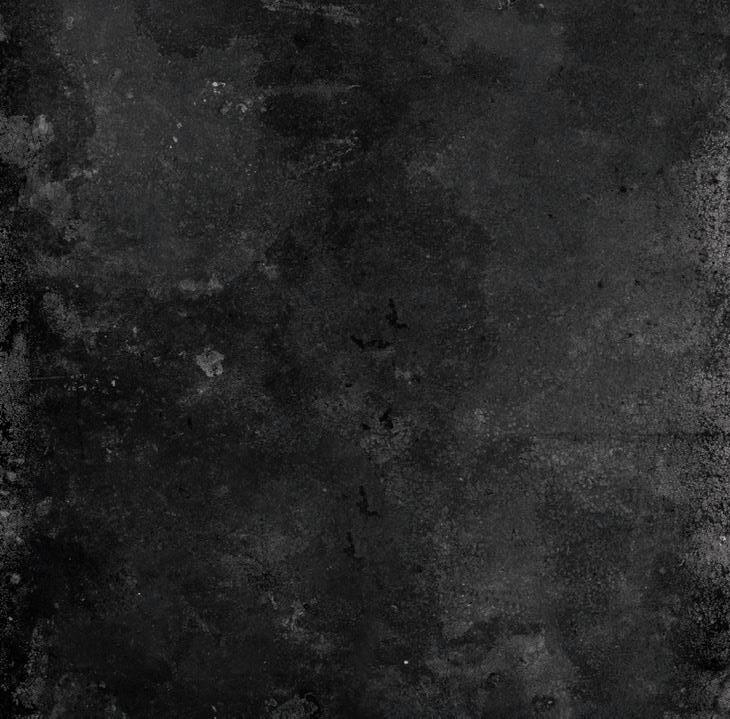
So, let’s game out your worst-case scenario: your boyfriend is bisexual. Would that really be so bad, WASP? If you’re going to obsess about the downside of marrying a bisexual guy—he’s going to want to fuck a guy once in a while—you should at least pause to consider the upside. For instance, you won’t have to be on the receiving end of penetration every time you say yes to sex, WASP, because you’ll get to do the penetrating every once in a while. And the occasional MMF threesome . . . well, that seems like the best-case scenario to me, WASP, but I’m a little like your boyfriend: here for the freaky stuff.
Q: I’m a 38-year-old mother of two youngish kids in a tenyear hetero relationship that I am destroying. I cheated with a girl at my job at the end of last year and now I have feelings for her. I’ve ended the affair several times, but each time we start back up again. I’ve always known that I’m bisexual but never really explored that side of myself. I don’t know if I never explored this side of myself out of fear, internalized homophobia, or that the right girl never presented herself. Now I need to choose. Do I stay





with my long-term partner, a man I love dearly, and tamp down this side of myself?


Or do I break up with him and explore my sexuality? If we didn’t have kids, I would choose the latter. We have talked about opening up the relationship but he is way too hurt for that to be an option anymore. I know I majorly fucked up. I betrayed his trust and snuck around with this girl. Am I just a horrible person who needs to get her shit together and somehow patch things up with my partner? Or is exploring my sexuality something that I should prioritize over stability and long-term love?
—CONFUSED AS FUCK

a: If you were childless—or childfree—you would leave. But you aren’t childfree, CAF, and you owe it to your kids to at least try to make things work with your long-term partner.

That said, CAF, you aren’t obligated to stay in a relationship you can’t make work. If your actions have irrevocably destroyed your partner’s ability to trust you, and if you can’t come to some sort of accommodation moving forward that allows you to be the person you are (an accommodation that could take many different forms), ending it may ultimately be in the best interests of your kids. Because a bitter, loveless, high-conflict relationship will not only make you and your partner miserable, but it will also make your kids miserable.

If your relationship never recovers from the blows you’ve inflicted on it—if you can’t get past this—then you’ll have to end it. But at this point you simply don’t know whether or how this relationship can be salvaged. So, give it a chance, do the work, and see where you are in a year. If leaving was ultimately the right thing to do, it’ll still be the right thing to do a year from now. If leaving was the


wrong thing to do, you won’t be able to undo it a year from now.
Please get out there and suck some dick and/or eat some pussy before you make a monogamous commitment to an opposite-sex partner—or a same-sex partner, for that matter, although I get fewer letters from bisexuals in same-sex relationships who’ve recently “explored” their bisexuality (with disastrous consequences) or begged their samesex partners for permission to “explore” their bisexuality (and been threatened with disastrous consequences). Yeah, yeah: bisexual people can honor monogamous commitments. But as you may have noticed—as anyone who’s been paying attention should have noticed by now—monogamy isn’t easy for anyone
And while it’s considered biphobic to suggest that monogamy might be a little harder for bisexual people, most of the people making that argument to me are bisexuals who made monogamous commitments before fully exploring their sexualities. LGBTQ+ people never tire of pointing out how a particular thing might be harder for gay men and a different particular thing might be harder for lesbians and another particular thing might be a whole lot harder for trans people and a long list of other things might be a bazillion times harder for asexuals, demisexuals, sapiosexuals, omnisexuals, etc., etc., etc. And yet it’s somehow taboo to suggest that monogamy, which, again, is pretty damn hard for everyone, might be just a tiny bit harder for bisexuals. v
Send your burning questions to mailbox@savage.love. Find full columns, podcasts, merch, and more at savage.love @fakedansavage









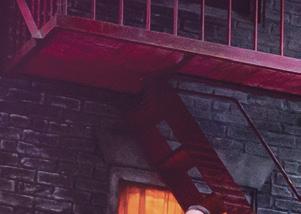

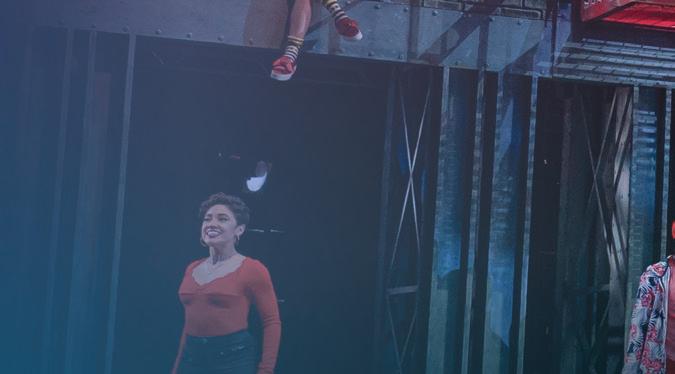












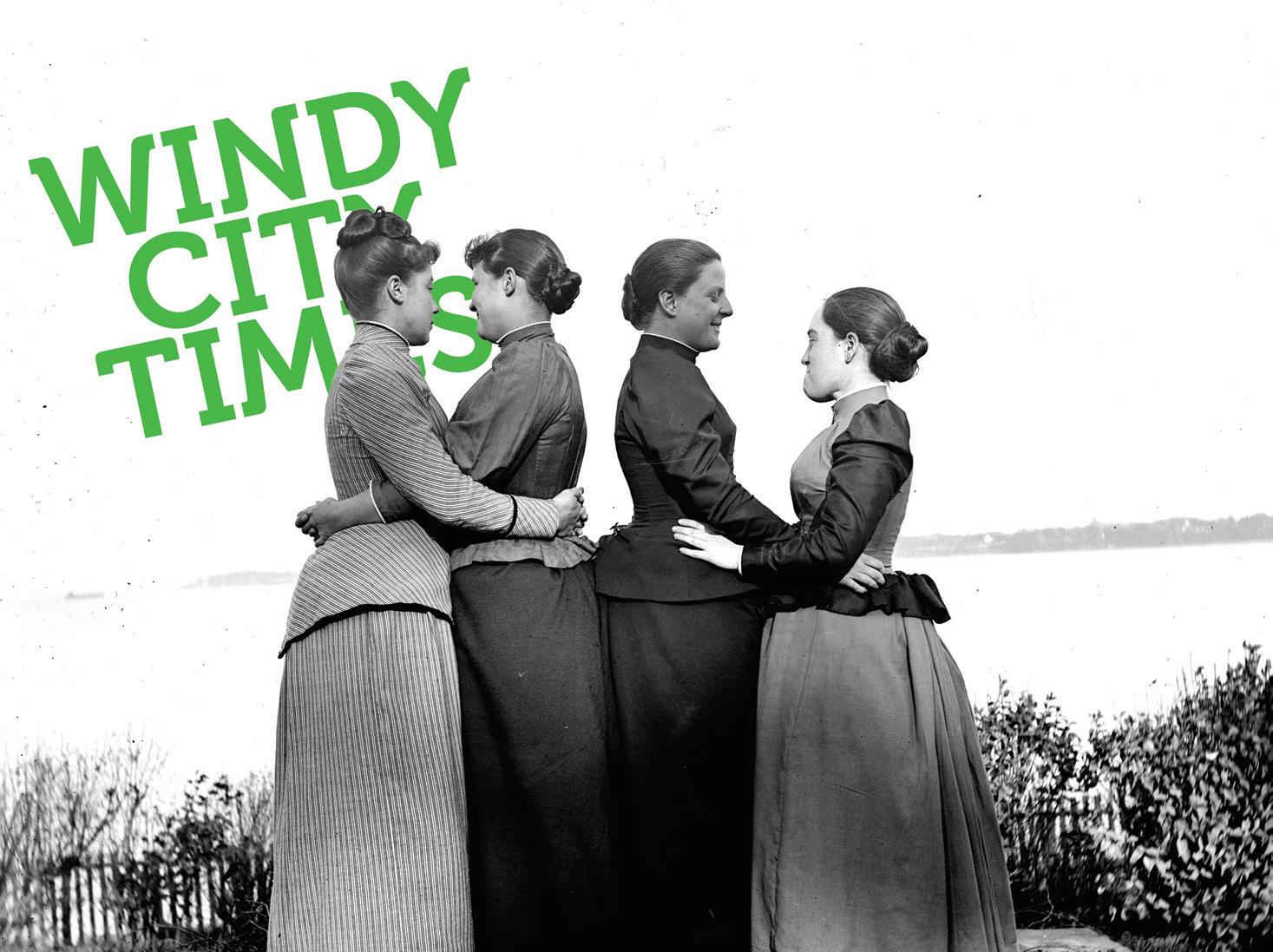



This is only a brief summary of important information about BIKTARVY and does not replace talking to your healthcare provider about your condition and your treatment.

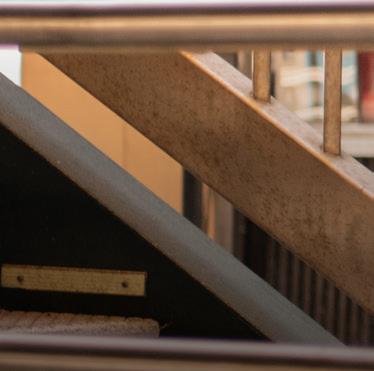
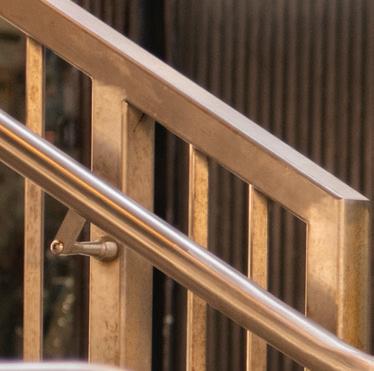

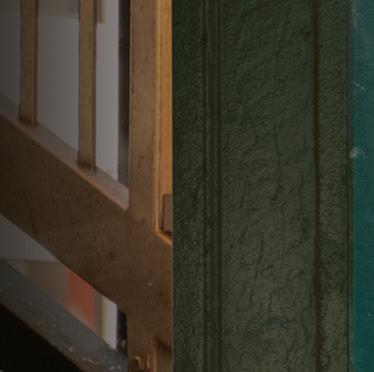
BIKTARVY may cause serious side e ects, including:
Worsening of hepatitis B (HBV) infection. Your healthcare provider will test you for HBV. If you have both HIV-1 and HBV, your HBV may suddenly get worse if you stop taking BIKTARVY. Do not stop taking BIKTARVY without first talking to your healthcare provider, as they will need to check your health regularly for several months, and may give you HBV medicine.

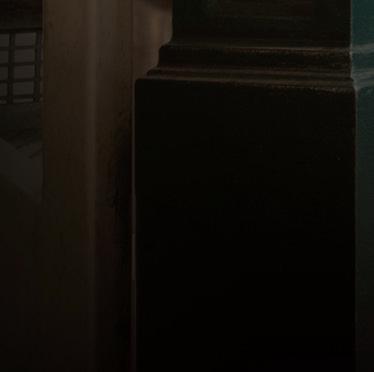


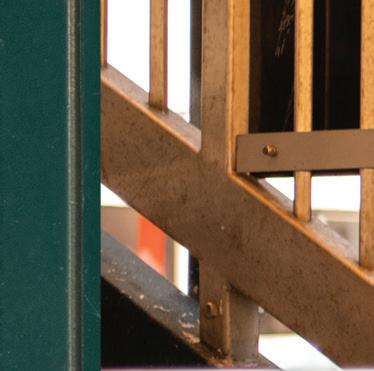

BIKTARVY is a complete, 1-pill, once-a-day prescription medicine used to treat HIV-1 in adults and children who weigh at least 55 pounds. It can either be used in people who have never taken HIV-1 medicines before, or people who are replacing their current HIV-1 medicines and whose healthcare provider determines they meet certain requirements.
BIKTARVY does not cure HIV-1 or AIDS. HIV-1 is the virus that causes AIDS.
Do NOT take BIKTARVY if you also take a medicine that contains:
dofetilide
rifampin
any other medicines to treat HIV-1
BEFORE TAKING BIKTARVY
Tell your healthcare provider if you:
Have or have had any kidney or liver problems, including hepatitis infection.
Have any other health problems.
Are pregnant or plan to become pregnant. It is not known if BIKTARVY can harm your unborn baby. Tell your healthcare provider if you become pregnant while taking BIKTARVY.
Are breastfeeding (nursing) or plan to breastfeed. Do not breastfeed. HIV-1 can be passed to the baby in breast milk.
Tell your healthcare provider about all the medicines you take:



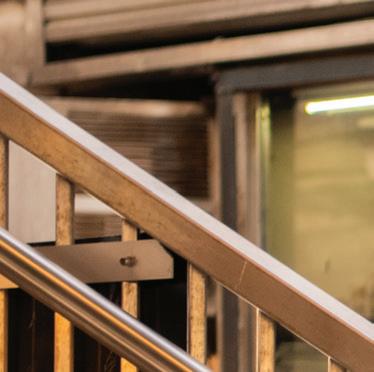
Keep a list that includes all prescription and over-the-counter medicines, antacids, laxatives, vitamins, and herbal supplements, and show it to your healthcare provider and pharmacist.
BIKTARVY and other medicines may a ect each other. Ask your healthcare provider and pharmacist about medicines that interact with BIKTARVY, and ask if it is safe to take BIKTARVY with all your other medicines.
BIKTARVY may cause serious side e ects, including:
Those in the “Most Important Information About BIKTARVY” section.
Changes in your immune system. Your immune system may get stronger and begin to fight infections that may have been hidden in your body. Tell your healthcare provider if you have any new symptoms after you start taking BIKTARVY.
Kidney problems, including kidney failure. Your healthcare provider should do blood and urine tests to check your kidneys. If you develop new or worse kidney problems, they may tell you to stop taking BIKTARVY.
Too much lactic acid in your blood (lactic acidosis), which is a serious but rare medical emergency that can lead to death. Tell your healthcare provider right away if you get these symptoms: weakness or being more tired than usual, unusual muscle pain, being short of breath or fast breathing, stomach pain with nausea and vomiting, cold or blue hands and feet, feel dizzy or lightheaded, or a fast or abnormal heartbeat.
Severe liver problems, which in rare cases can lead to death. Tell your healthcare provider right away if you get these symptoms: skin or the white part of your eyes turns yellow, dark “tea-colored” urine, lightcolored stools, loss of appetite for several days or longer, nausea, or stomach-area pain.
The most common side e ects of BIKTARVY in clinical studies were diarrhea (6%), nausea (6%), and headache (5%).
These are not all the possible side e ects of BIKTARVY. Tell your healthcare provider right away if you have any new symptoms while taking BIKTARVY.
You are encouraged to report negative side e ects of prescription drugs to the FDA. Visit www.FDA.gov/medwatch or call 1-800-FDA-1088.
Your healthcare provider will need to do tests to monitor your health before and during treatment with BIKTARVY.

Take BIKTARVY 1 time each day with or without food.
This is only a brief summary of important information about BIKTARVY. Talk to your healthcare provider or pharmacist to learn more.
Go to BIKTARVY.com or call 1-800-GILEAD-5
If you need help paying for your medicine, visit BIKTARVY.com for program information.

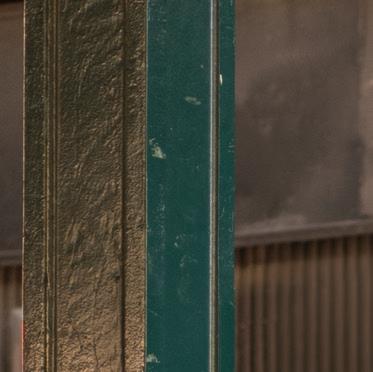



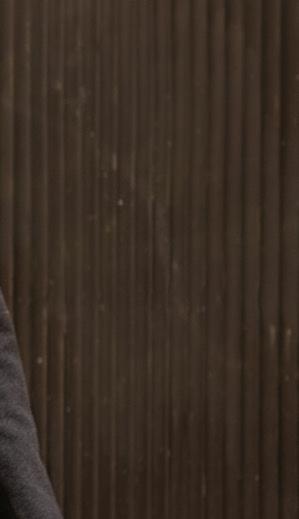

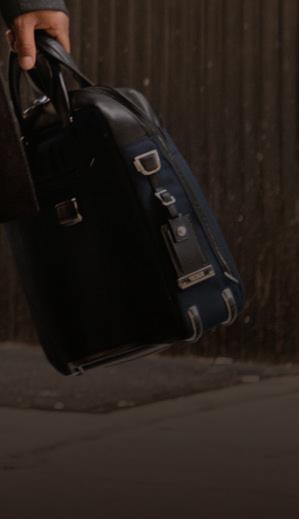









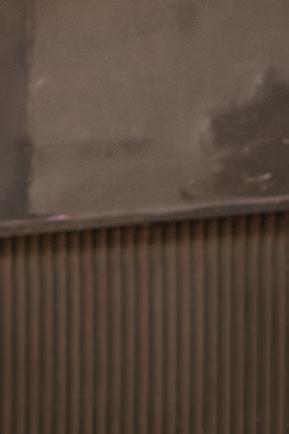

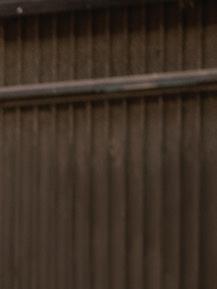


Girl, I
author Stephanie
discusses the impact of her voter guide 5
Keep on Trockin’: All-male ballet troupe mixes culture and comedy
Woman-owned Family Tree Resale shop helps Chicagoans in need
At ‘First(ish)’ Sight: Producer Ashley Flowers speaks on “honest” respresentation
TRAVEL: Jacksonville, Florida

10
PUBLISHER Terri Klinsky
EXECUTIVE EDITOR Matt Simonette
DIGITAL DIRECTOR Jean Albright
ART DIRECTOR Kirk Williamson
BUSINESS MANAGER Ripley Caine
SENIOR ACCOUNT EXECUTIVE Terri Klinsky CONTRIBUTORS
Joey Amato, Andrew Davis, Vernon Hester, Carrie Maxwell, Andrew Pirrotta, Matt Simonette, Michelle Zacarias WEB HOSTING LoveYourWebsite.com
(lead programmer: Martie Marro) (773) 871-7610 FAX (773) 871-7609

Editorial: matt@windycitymediagroup.com
Sales: terri@windycitymediagroup.com
14
Art/ad copy: kirk@windycitymediagroup.com
15
16
Copyright 2023 Lambda Publications Inc./Windy City Media Group; All rights reserved. Reprint by permission only. Back issues (if available) for $5 per issue (postage included). Return postage must accompany all manuscripts, drawings, and photographs submitted if they are to be returned, and no responsibility may be assumed for unsolicited materials. All rights to letters, art and photographs sent to Windy City Times will be treated as unconditionally assigned for publication purposes and as such, subject to editing and comment. The opinions expressed by the columnists, cartoonists, letter writers, and commentators are their own and do not necessarily reflect the position of Windy City Times. Publication of the name, photograph,
Howard Brown Health is pleased to o er a new more convenient way for current patients to schedule their visits!
Online scheduling is now available for in-person visits. For established primary care patients, making an appointment is quick and easy, and available 24 hours a day, seven days a week for your convenience at howardbrown.org/mychart. Please visit howardbrown.org for information about our walk-in clinics.
If you have any questions about becoming a new patient, the new patient portal, or need assistance to sign up for MyChart, please call us at 773.388.1600.

Stephanie Skora, co-creator of the Girl, I Guess (GIG) voter guide, has always loved election season. Some of her earliest childhood memories entailed watching the results of the infamous 2000 presidential election between George W. Bush and then-Vice President Al Gore.
Skora’s interest in politics is in fact one of the few things for which she actively gives credit to her parents.
“We were a working-class family,” she recalled. “Whenever we needed the extra money, my mom would work as an election judge.” Even Skora’s elementary school “mock elections” left an impression, which is why, when it came time to attend college, she decided to pursue a political science degree at the University of Illinois.
From the start, Skora has been drawn to the drama and workings of electoral politics. It wasn’t until she moved to Chicago in 2015, however, that she became immersed in the inner workings of municipal and general elections.
The conceptualization for the voter guide came after a Facebook post made by co-creator (and retired GIG co-writer) Ellen Mayer. At the time, Mayer was working as an editor for South Side Weekly and was heavily involved in the coverage of election cycles.
Skora remembers the post asking, “Wouldn’t it be cool if somebody made a voter guide for leftists and progressives, then we can get everybody to turn out without having to deal with people’s feelings about whether or not voting is colonialism?”
Skora messaged Mayer immediately and encouraged her to push forward with the idea. The pair then teamed up to draft the first GIG guide for the 2018 Democratic primary. Although Skora claims the first version of the guide was not up to her current standards, it nevertheless became popular among leftist circles, close friends and organizing acquaintances.
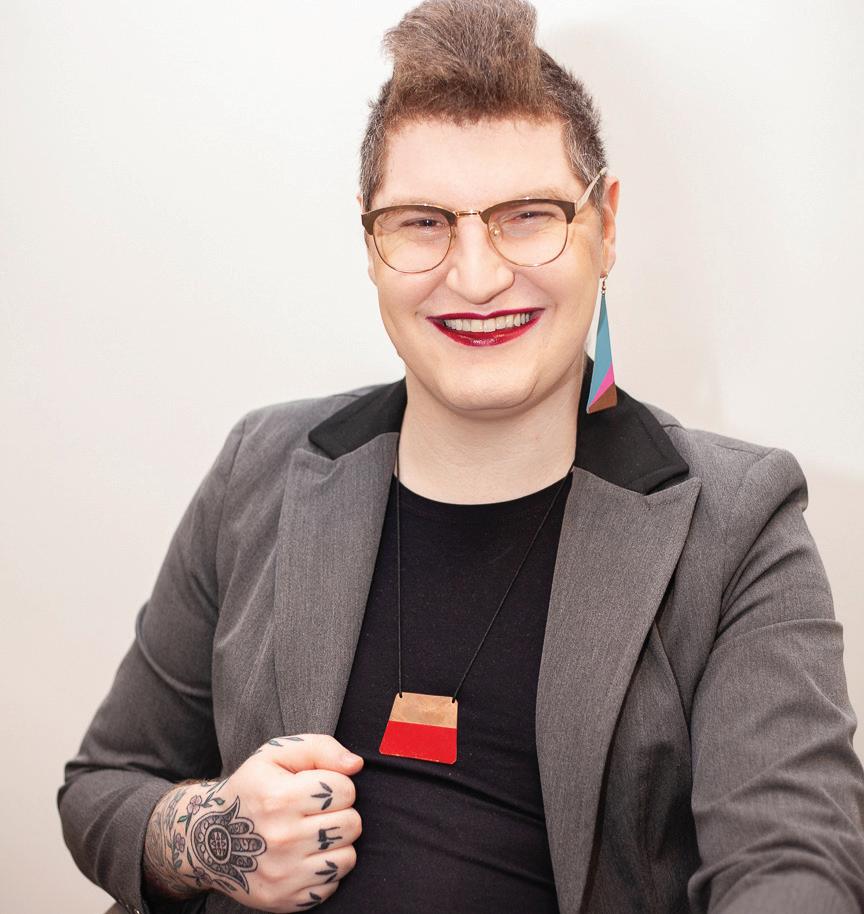
“The order wasn’t coherent,” she recalls. “We didn’t cover all the races. It was just the stuff that we thought was interesting.”
Skora and Mayer were nonetheless confident
the guide would be a good resource to combat low voter-turnout, particularly for working-class individuals who didn’t have time to do intensive electoral research.
It wasn’t until the 2018 midterm general election that the popularity of the GIG voter guide really took off, making its way beyond the demographics of leftist spaces. That second edition was also when the Girl, I Guess brand was codified, and became the permanent identifier for the voter guide. In addition to making its way onto Reddit threads, Skora and Mayer received plenty of local news coverage, including a feature from the Chicago Sun- Times.
Skora realized the magnitude of the guide’s impact after a Northwestern professor studying judicial retention elections reached out to GIG: “He said in the nicest way possible, y’all fucked up my research.” That professor noted a spike in voter participation during the 2018 judicial election, estimating that 4% of Cook County voters had utilized Girl, I Guess in their polling decisions.
Although the research and drafting take several weeks (Skora admits to using up her paid time off to binge-write), the process begins long before election season takes off.
Skora explained, “I like to follow local politics, I follow state politics. I follow federal politics. This is just something that I pay attention to in my everyday life.”
Skora’s attuned political observations and community relationships drive many of her final endorsement decisions; she is frequently familiar with candidates long before she begins her election evaluations. “When I’m getting ready to write, I have an idea of who I’m looking for anyway. So I’m able to just do a deep dive into their donors and their policies without having to start from scratch when I’m looking into their campaign.”
Skora has developed a grading rubric to evaluate candidates seeking endorsements and establish consistent metrics. The 2019 Municipal Guide used a “Red Light, Yellow Light, Green Light’’ system for alderperson races—with green serving as
an endorsement and red being “candidates that you should not vote for under any circumstance, or are significantly inferior to the endorsee.” It is not uncommon for people to reach out directly to Skora, or respond online, if they are unhappy with an endorsement, or lack thereof.
When asked how she feels about going from a relatively unknown local organizer to “political influencer,” Skora said she is still surprised, adding, “What is really wild to me is that the guide has gotten to the point now where it’s like helping swing elections.”
Skora cited Hoan Huynh, who is currently representing District 13 in the Illinois House of Representatives, as an example. Huynh caught Skora’s attention during the 2022 General Election, bestowing him with the highest GIG endorsement, a “golden shrug.” The endorsement resulted in additional press coverage for Huynh and gave him a competitive edge over his opponents, who Skora had not reviewed favorably. In the end, Huyhn won with 45.2% of the vote.
Despite her undeniable influence, Skora has faced criticism for candidates she’s supported in the past. On other occasions she’s faced backlash for not endorsing popular Democratic candidates, especially those predicted to win by their party. To this note, Skora reminds people that the guide is meant to be a resource: “I’m not trying to be
a kingmaker in local elections or anything. The voter guide is a turnout tool.”
Although GIG users have rapidly expanded, the overall aloof and sometimes gossipy tone of the guide has remained consistent. In fact, since the creation of the guide Skora has rarely ever remained neutral about anything political, which she said is a reflection of both her values and Chicago’s political landscape: “This is Chicago—If you think somebody’s a clown and corrupt, we’re gonna call them a corrupt clown.”
Skora insisted she doesn’t villainize “good candidates” over singular mistakes, adding that—while politicians and candidates hold an incredible amount of power and have a lot of responsibilities—at the end of the day, “They’re just people.”
As someone who takes pride in calling herself an anarchist, Skora conceded that progressives won’t be voting their way to a revolution anytime soon. But she maintained that it is their civic responsibility to use every tool in the toolbox to create the best conditions possible in the fight for liberation.
“We can elect people who are on our side, or who are part of our movements,” Skora said. “There are genuinely good people who want to help create a more just world.”
 BY ANDREW DAVIS
BY ANDREW DAVIS
Few people outside of New York may know about 19th-century photographer Alice Austen (18661952)—but author/historian/Northwestern University professor Pamela Bannos wants to change that.
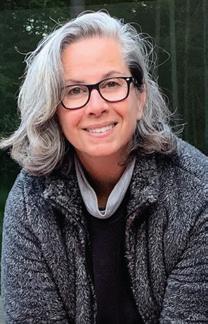
Bannos recently completed a podcast series about Austen, My Dear Alice, which she based on hundreds of letters now housed at the Alice Austen House museum in Staten Island, New York (Austen took more than 8,000 photographs over the course of her life). The letters were given to the museum 40 years after they were discovered by the family who had moved into the home Austen had been evicted from in 1945, when she was 79.
“I discovered the letters because I was invited to do a Vivian Maier talk at the Alice Austen House,” Bannos said. (Maier was a 20th-century photographer who took thousands of photos, mainly of Chicago, New York City and Los Angeles.) “Christina Allegretti, who’s still with the place, took me on a tour of the place and even showed me where they still had the darkroom [Austen] used. She didn’t show me the letters, but I said, ‘This is very interesting.’”
Bannos eventually was taken to the room where the letters were. “I didn’t read them then. They let you take photos with your phone, however. They were behind mylar so there were reflections and there were boxes. This was in 2018 and I was still overwhelmed giving book talks, so I shelved it until the pandemic. In the spring of 2020, I had all these files and I transcribed the whole letter collection, which they didn’t know I was doing.
“I’m always interested in uncovering history,” Bannos said, noting she first became aware of Austen’s work while living in Des Moines, Iowa, in 1980. “It’s interesting that I do these obsessive projects. I wrote that Vivian Maier book,
which was a whole other situation.”
Austen’s life was one full of peaks (finding the love of her life, Gertrude Tate), valleys (losing her wealth in the stock market crash of 1929) and travel, with excursions taking her to many places such as Chicago, where she visited the World’s Columbian Exposition in 1893.
“She visited and photographed it,” Bannos said. “There’s been this urge to give her more credit as a photographer. She’s not in the canon because she did this as a hobby and didn’t really sell her work. But I discovered she sold photographs at this exposition.”
And Austen definitely had her own style of photography, at least in terms of process. For example, at that exposition, “so many people went there and photographed it because photography was becoming more accessible—little pocket cameras and things. But she was shooting with glass plates and everything was a production. That was an arduous process.”
When asked what surprised her about Austen, Bannos listed several items. “The surprise was, first, that she was selling her photographs,” she said. “The fact that she was making money from the photographs was something that had not been focused on, historically speaking.
“I was more surprised by what I was learning about the culture of the time, and I was probably learning more about these women who were writing to her than [about] Alice herself—but that was obviously the point. I was surprised by all these women who never got married and that there wasn’t more talk about anything than everyday things—except then Daisy [friend and gymnast Daisy Elliott] comes in and that there is such a thing as desire.
“What I liked was discovering the full picture as these letters are coming at her. Austen, like Vivian Maier, was a hoarder—and that was really
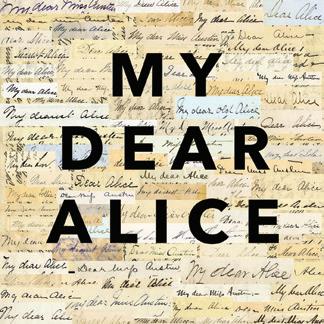
helpful. But I was surprised at how thoroughly I was able to put the story together. I was also surprised that this archive existed, and that it ended up at the house 40 years after she left. I was surprised to see handwriting all over from children. I was really enamored of the women who wrote to her; the personalities of those women became a lot clearer.”
My Dear Alice helps bring Austen and the people who wrote the letters to life—and makes things more engaging by using actors (students
from Northwestern). Bannos admitted that she encountered many obstacles in putting the podcast together, ranging from casting to time management to her own voice changes.
“I auditioned all these Northwestern theater students; I got 30 auditions back,” she said.

“All the voices started sounding the same after a while, [but] I ended up picking people who sounded different from each other. And I was still writing the script while I was still recording it. And a friend of mine with a short attention span
kept falling asleep while listening to the recordings—so I added more music and sound effects to bring it to life.”


Of course, no discussion of Austen would be complete without discussing the queer aspects of her life, from being with Tate to the photos Austen took of her women friends, who often dressed in men’s clothing for the images.
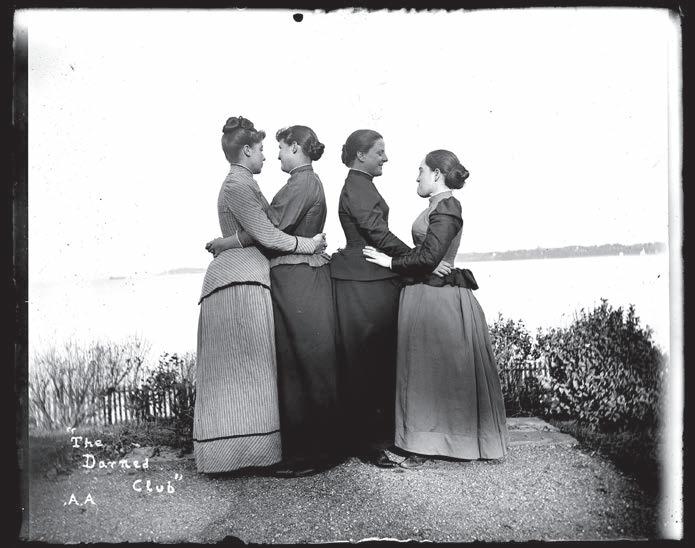

“I don’t love that there are no letters from Gertrude from that period, but I love that there’s a picture from the time that they met,” said Ban-


nos, who’s part of the LGBTQ+ community herself. “I found the waterfall that’s in the photograph.” And what did Bannos think Austen would make of contemporary photography? “I think [Austen] was very curious about people and making photographs,” Bannos said. “She, like Vivian Maier, would be out in the street”—but probably not using a cellphone.
To listen to the My Dear Alice podcast series and learn more about Austen, visit https:// mydearalice.org/.

ALMA—which stands for Association of Latinos Motivating Action—was established in Chicago in 1989, making it one of the oldest Latinx LGBTQ organizations in the country. After over three decades of operation, the organization last summer hired its first executive director, Manuel Hernandez.
A New York native, Hernandez began as a math educator, then moved into higher-education administration; he has worked on diversity, equity and inclusion initiatives in a number of different capacities, among them at Hampshire College (Massachusetts) and University of Chicago.

Windy City Times recently spoke with Hernandez regarding his new position at ALMA.
Windy City Times: What’s been the biggest difference for you living here in Chicago versus New York?
Manuel Hernandez: I would say the everyday hustle and bustle of New York can be overwhelming, even for a New York native, [and] especially compared to Chicago. I like to say that New York is a lot of everything in a little place, whereas Chicago is a little bit of everything in a lot of space … I love Chicago. I visited Chicago several times before I decided to move. February makes it exactly four years.
WCT: How did you find out about ALMA?
MH: I was actually recommended by several
individuals from Chicago. … At the time, I was a little hesitant. I wasn’t too sure … I’ve been doing non-profit work for over a decade. So, I just did it. I thought, I’m only 30 years old. I had the [needed] experience, but still doubted myself slightly. But then I just went for it. I kind of threw my hat in the ring, thinking if something comes out of it, great. If not, then I’m ok. I went through the process and, in the very end, got the offer.
WCT: How is it working with organization members at your age? How has it been being this young leader?
MH: So far it has been pretty good. I haven’t
had any negative experiences yet in this current role.
I have in the past had assistant director and associate director positions—my very first associate director position was when I was about 25 or 26 years old. That experience was tough, because I was constantly being told that I didn’t know what I was talking about when I definitely did know what I was talking about. But in this role, I haven’t encountered any issues of any kind with being too young. I’ve actually been praised for being in the position I am with being so young, because I bring in a new perspective, which I think is great for any organization. To have someone young and kind of vibrant and
bringing in new ideas is something that is great for an organization, especially one that has been around for 34 years. … ALMA wants to include the voices of young adults and youth, and I feel with bringing me in I can use that to my advantage and tap into those communities.
WCT: Regarding the intersectionality of the Latinx and LGBTQ communities, could you speak a little bit of your own experiences?
MH: In my experience there is an added layer. I was raised extremely religious. I was raised Pentecostal Christian. So being queer, and Latinx, living in a religious home was extremely difficult. And many times, [when] growing up, even when I left the church, I still battled internal struggles. When I present myself, do I consider myself Latinx and then a gay man, or a gay man and then Latinx? I actually heard an interview not too long ago from a Black, gay reverend. And the question was, how do you identify or present yourself first? And he gave a response that stays with me now. And it is, “I identify with what you experience of me first.”
So, if you experience me as a gay man first, then that’s how I identify. If you feel that you identify with me as a Latinx man, then that is what I am at the same time. So, I don’t have to choose. Because I am all of these things. But that took years for me to process with the baggage of being raised in a religious home.
I always felt that my queerness and my faith were at odds with each other. I may not identify as Christian, but I have faith and I have my own belief, and I’m reconciling my queer identity and my spirituality, just like with my Latinx identity. They can all exist—even though with the Latinx community there is a lot of homophobia. So being able to reconcile those identities and know that I can coexist internally. It took many years, and as a young adult it was a struggle, finding that acceptance of who I am. That’s something we grow up with as queer people. How do I accept myself when society demonizes me for being me?
WCT: What are some things that you are really liking that ALMA is doing right now, and what are some of the larger, long-term steps you see for the future?
MH: What I truly like about ALMA is the engagement with the community. An organization that has been around for so long has created a strong relationship with the community. That’s something that I value and love, because the community is going to show up. So creating that relationship is something that I truly value about the organization—and the fact that ALMA has almost informally created this environment for leadership development and helping our community leaders take that next step in their lives and careers and ambitions. Thinking about the long term, I want to formalize that, to create a leadership development academy that formalizes the leadership development we do informally. That’s the big plan for the future.
See almachicago.org.
Asians and Friends Chicago (AFC) hosted its annual Lunar New Year dinner and celebration on Feb. 7.


The event, which celebrated the Year of the Rabbit, took place at Chengdu Impressions restaurant, 5900 N. Broadway, and featured a red carpet experience that included drag bunnies, tongue-in-cheek musical performances, an exotic dinner and a raffle. Entitled “Bunny New Year,” the event marked the group’s first in person event in three years due to the COVID-19 pandemic.
AFC was formed in 1985 and, according to its website, was started by friends “who wanted to provide a supportive, non-threatening environment for gay Asians.”
Additionally, the website notes: “The purpose of AFC is to bring together gay people who are interested in developing a greater understanding for the culture of Asian and Asian Americans and in developing friendships through social, cultural, and educational activities.”
Spokesperson Angel Abcede said, “The group is an entry way for queer gays in Chicago, and serves as a welcome mat for people coming in from outside.”
Bunny New Year got off to a raucous start with club members both greeting one another in bunny ears and posing with a bevy of drag performers on the red carpet. After the dinner and raffle, members participated in a musical extravaganza featuring the “bunnies” performing songs such as “The Carrot Song,” “The Bunny Hop” and a heartfelt “My Bunny Valentine” from AFC President Frank Batusic.

See afchicago.org .
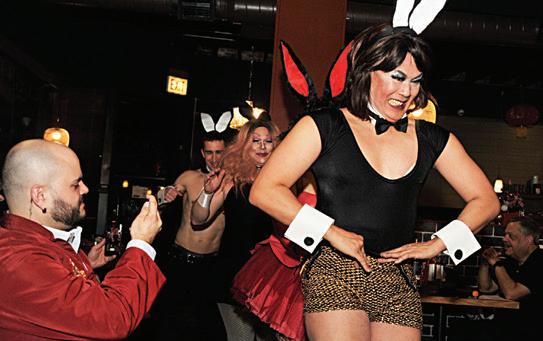
Performer Duane Gosa admits that going to the ballet can sometimes be intimidating for some audiences. But he is quick to reassure that the audience for his particular dance troupe—New York City-based Les Ballets Trockadero de Monte Carlo or, the “Trocks”—has nothing to worry about.

“It’s a fun show,” Gosa, a Chicago native who now calls Brooklyn home, explained. “This show really opens [ballet] up to all audiences—all types of people, demographics, ages. It becomes something you can easily enjoy and easily understand.”
The Trocks visited Chicago in February, appearing at the Auditorium Theatre downtown.
Gosa dances two key roles in various performances: ballerina Helen Highwaters and danseur Vladimir Legupski. There is always kind of a meta aspect to a Trocks show, since Gosa and his colleagues are interpreting the roles of performers interpreting their dance roles.
“It feels a little bit more light-hearted,” Gosa said. “If you do make a mistake in a rehearsal, you’re not so anxious about trying to cover it up. Maybe that mistake can turn into something that works onstage. You can take those mistakes and
use them, or try to act your way out of it, rather than trying hard to hide something.”
Director Tory Dobrin describes a Trocks performance as “very high-level dancing and very high-level comedy…The most important element is for the audience to enjoy themselves—and they usually do.”
The Trocks hadn’t performed at the Auditorium in many years, so Dobrin assembled a greatest-hits program from the Trocks’ repertoire for the February performance.
As director, it is Dobrin’s job to set the tone for the Trocks’ performances and performers. He
admitted that it’s not an easy job managing a troupe with myriad personalities and sensibilities, but he likened the Trocks’ organization to a “mom-and-pop store,” with just a handful of individuals responsible for numerous logistical duties.

Dobrin matches new performers with their names and dance personae. Usually when a dancer is hired, there is not enough time for them to develop their own characterizations, so Dobrin has a veritable stock company of characters to choose from.
“I have a library on my computer,” he explained. “I go through and I kind of feel out who that person is, and I pick a name that suits them. We bring in new names all the time, but I like to keep the older names around too. I’m really into the continuity of the past into the present. … I talk a lot about the past and where we’re coming from so that the younger generation of dancers know that it didn’t just start with them—[the Trocks] started in 1974.”
Dobrin began as a performer with the Trocks in 1980.
“It’s kind of indicative of my personality—I’m someone who just kind of goes with the flow,” he said. That year, he was in a dance class with someone who’d danced with the Trocks and knew that the troupe was looking for performers for a tour in South America. “I went and I was hired— it was as simple as that.”
Dobrin added, “My aunt was a PR person in Los Angeles and did their PR [there]. … So I was aware of the company already, and the tour in South America was super-fascinating.”
Gosa came to the Trocks about 10 years ago. He had been dancing in New York for several years and had in fact stopped doing ballet because “I was really over the role of a traditional male dancer. I felt like I didn’t have the characteristics and qualities to be that great at it—I wasn’t that strong.”
But he was tempted to audition for the Trocks when he saw an opening come up, and he was quickly hired.
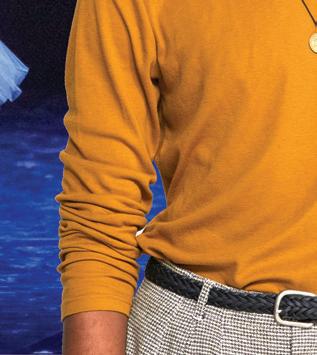
“I looked forward to being in a queer space,” Gosa recalled. “Growing up in dance, you are around a lot of females, so you don’t really have that kind of space to connect with people. I remember being really excited to work in a queer male environment.”

At the time of his hiring, Gosa was also excited for the chance at full-blown drag. “Everyone has done it for Halloween…It’s close, but not close enough. I knew I could do that better. I was excited to be in an environment where people are really skilled at this…I’ve changed so much being in a group like this.”
He called Helen Highwaters a mix of Lucille Ball and Regina King: “She is very subtle—not over-the-top—but somebody who commands your attention with a variety of facial expres-

sions. She is also Black—trying hard to be a Black ballerina on the stage.”
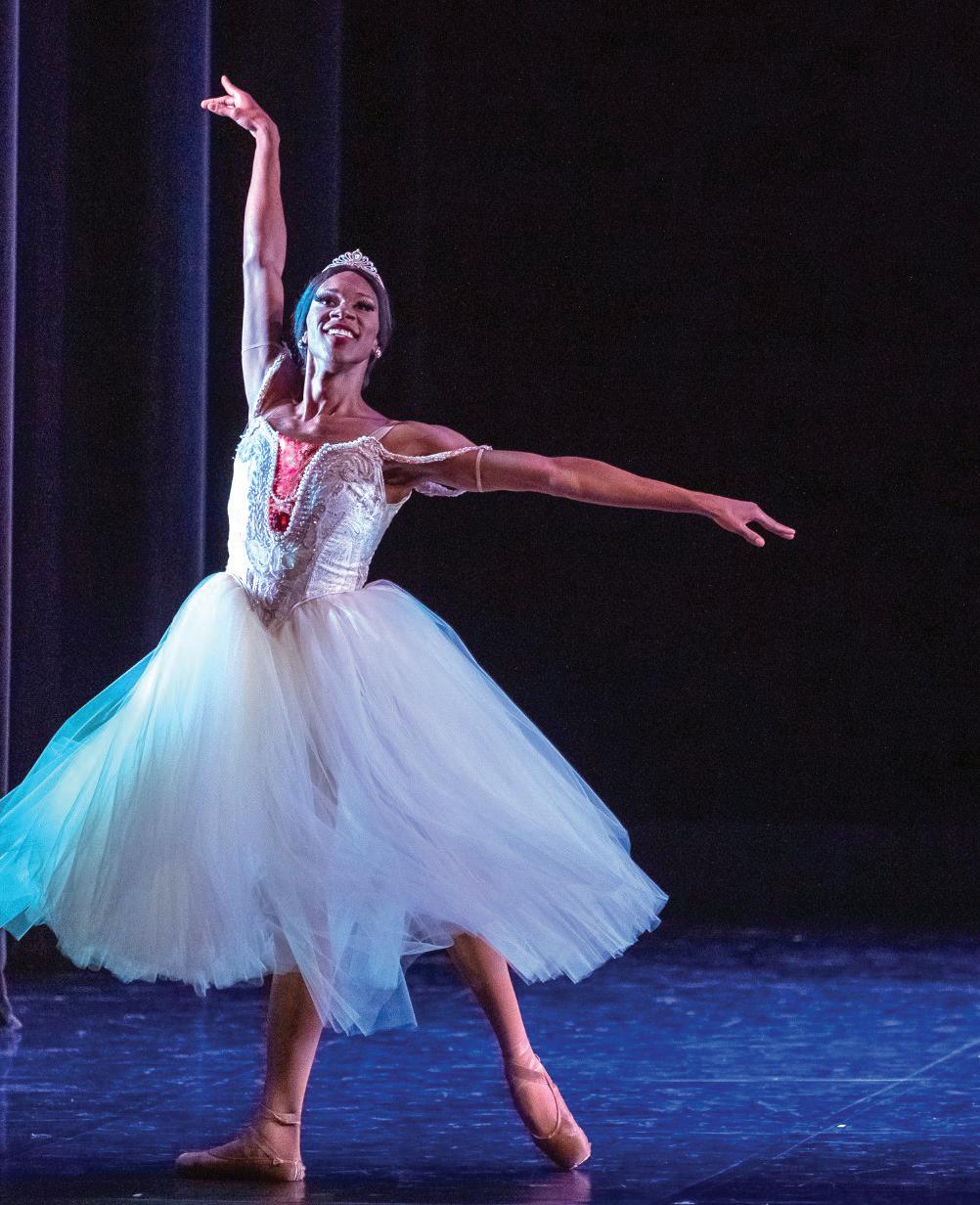

He likened Vladimir Legupsky, meanwhile, as a “macho Disney prince”—someone who parodies the cavalier masculine dancer’s qualities Gosa years ago had been made to feel he was lacking. Legupsky has “a big, puffed-up chest, and is really arrogant, with a coiffed wig,” he said.
Shortly before the February performance, Gosa was eagerly anticipating returning to Chicago. He was born in the Windy City, and though he left at a young age, he spent numerous summers there as a youngster.
“I have so much family there who hasn’t had a chance to see me perform, so I’m really excited to be there,” he said.

When Elizabeth Basa opened Family Tree Resale shop in 2009 at 5066 N. Lincoln Ave. in Chicago’s Lincoln Square neighborhood, her mission was “to build an environmentally sustainable shop centered on helping those in need in the local community” in an inclusive way.

Basa’s mother raised her on thrift shopping in Chicago during the ’70s, so Basa developed a “thrill of treasure hunting for a great deal.” Now she wants her shoppers to get that same thrill, as well as, for those in need, a helping hand.
“I envisioned a win-win-win place that would be a fabulous thrift experience for our shoppers, friendly to the planet, and help people who needed free clothing and other goods,” said Basa. “Since opening, the plan has remained intact, and over the years, we have built a substantial network of schools and charities that partner with us through our community voucher program.”
The community voucher program was inspired by the help Basa’s mother, who struggled with mental health issues, received when Basa was growing up. Basa’s mother got support from a local thrift shop give-back program which helped sustain their family. Basa now wants to do the same for others.
Local schools and organizations are given Family Tree’s free community vouchers, which are then in turn passed on to families in need. Families or organization members with the means to do so are simultaneously encouraged to donate. Basa called it “a sort of ecosystem or cycle of resources that ties the communities to Family Tree, and vice-versa.”
Vouchers come in $20 increments and are given to each of the partnering local schools or
charities in $200 to $800 increments per quarter. The voucher money given out to each entity depends entirely on the amount of donations the store receives from each partnering local school or charity.
“They can pick out whatever they need like any other customer,” said Basa. “Since it began, we have serviced thousands of families. We do not have an exact number, but we do know we have donated back over $260,000 in vouchers.”
Among the partnering schools and charities are Chicago Public Schools—Budlong, Waters, Peterson, Jamieson, Ravenswood, Stone Academy, Bateman and Chappell—as well as Truman College, St. Matthias and St. Hilary’s School. Charities include Heartland Alliance, The Friendship Center, Syrian Community Network, Apna Ghar, Swedish Hospital, Rohingya Culture Center, The Children’s Place, EZRA, Friedman Place, Refugee One, Parish for St. Matthias and Queen of Angels (St. Vincent De Paul), World Relief and Common Pantry.
Basa believes that her voucher program is the only one that services public schools anywhere in the United States. She added that the most popular items people seek out are clothing and home décor items.

“We also have a fantastic kids’ department and a large jewelry selection people love,” said Basa. watching each item find a new use when it leaves our store feels great. I enjoy expressing my creativity at work, and I genuinely enjoy working with my co-workers.”
She has employed LGBTQ+ people since the store’s founding, and told Windy City Times that she “would be happy to learn if there is something we can do” in terms of outreach to the LGBTQ+ community.

“I am happy to work for Family Tree, where I can help neighbors help their neighbors through the community voucher program,” said Family Tree Resale Community Outreach Coordinator Hillary Moon, who identifies as pansexual. “It is a good feeling to be a part of the change I wish to see in the world and participate in mutual aid.”
“People ask about things you find going through donations, and the items themselves are definitely interesting, but sometimes the story they tell is more so,” said Family Tree Resale staff member Sean Selbach. “The postcards, mugs, shirts and books they do not want or have a need for, why it could be. Even photographs and old notes. It is like a little window into their lives, being with them for a second without actually being with them, but I guess the short answer is, a Star Trek: The Next Generation uniform costume with com badge and ranking pipes included.”
In terms of Family Tree’s green model, Basa said that her resale shop is a way to prevent goods from entering the waste stream when items get thrown in the trash in lieu of being reused by other people. They also use non-toxic cleaners and products as well as recycle in multiple ways.
She added, “Our name, Family Tree, is based on the fact that we are one human family, and in our neighborhood, we are like branches of the same tree. Our aim is to be a bright spot for everyone in our community, respecting and welcoming everyone with open hearts and being a place where everyone can feel comfortable, which of course, includes our LGBTQ+ neighbors.”
See familytreeresale.com/.
Ashley Flowers—a producer, co-creator and actor in the short film First(ish) Date, now in pre-production—wears many creative hats. She also has an extensive resume working with stage and film props as well; Flowers has been working this television season on background props for the NBC drama “Chicago Med.”

“That includes all the ID badges and stethoscopes, for example, that the background actors use,” Flowers explained. “I also help with the directors’ chairs. It’s really nice, because I am used to being the propmaster, the person who’s all in charge and with all the responsibilities. It’s nice to be able to breathe and say, ‘Okay, not all of this is on me right now.’”
But Flowers, who only recently moved to Chicago from California, has set her sights on getting some of her own projects into gear.
“I’ve gotten to the point in my career where I just want to make my own stuff, because I’m not seeing what I want to see,” Flowers explained. “As a lesbian, I’m wanting to see those queer characters, and I’m wanting to see non-problematic queer stories. I thought, ‘It’s not really happening as much as I want, so I’m just going to kind of do it.’”
In early 2022, Flowers had her initial idea, a film about two women on a first date. She met Erica Romero, an actor and improvisation performer, and the two set about embellishing the storyline. Molly, whom Flowers would eventually play, is excited and anxious about her first date with Jess (Romero), whom Flowers described as “a more avoidant character, who uses sarcasm to hide her trauma.”
She added, “We wanted to show how emotionally vulnerable two women can be on a first date. We have that old joke about ‘U-Haul lesbians.’ Why do we have that? Because our dates can be anywhere from six- to 72-hours-long.”
Another character, Dirty Molly, is also there to embody Molly’s anxieties, literally bringing her face-to-face with the insecurities she lives with every day.
“[Dirty Molly] is there the entire date, judging what Molly is doing,” said Flowers, who is now running an online fundraiser to help pay for various production costs.
“We’re scheduled to film at the beginning of
March,” she said. “We’ve got our director, our [director of photography], our sound person. We’re solidifying our locations next. So far, everyone who’s been hired is part of the LGBTQ community, which is amazing.”
She said the costs were going towards location rental, equipment rental and paying cast and crew.
“I truly believe that you need to pay people properly,” Flowers said. “There’s this huge belief in the industry that, ‘Oh, you can do it for free.’ It’s like, ‘No, people have lives—pay them for doing this.’ I’m not going to pay myself because this is a passion project, but if I’m bringing somebody on, they should be paid.”
She produced two “no-budget” short films for friends in California, which gave her the confidence to launch First(ish) Date. Flowers had no inclination to direct the new film, adding, “I have such respect for people who can direct, and I know that’s not where my talent lies. … I’ve been very blessed to work with some amazing producers and directors with my prop and acting careers, who really helped and guided me.”
A native of Indiana, Flowers ended up in the Windy City because of a relationship.
“Being a typical U-Haul lesbian, love brought me here,” she said. “I met my wife online through friends, and she was living in Chicago. She came out to visit me—we were just friends. And then, ‘Oh you make complete sense for me.’ Then, long-distance dating and I finally thought, ‘You know what, there’s film in Chicago, I’m just going to move and see what happens.’ My best decision yet.’’
She’s observed that Chicago’s production community is fundamentally different for Los Angeles’.
“In L.A., it’s almost over-saturated—there’s a million projects, but when you try to get on one, there’s somebody already there, since there are so many people,” Flowers said. “Here, it’s a smaller community and it’s about who you know, which is nice, because I feel like we have built this little family. You always know somebody on the next shoot that you go to.”
The fundraiser for First(ish) Date is at https://givebutter.com/firstishdate.
Ashley Flowers. Courtesy of FlowersThe last time I visited Jacksonville, I was probably in my early-mid 20s and living in Orlando. It was a very long time ago. I was eager to visit again as I know much has changed in the city since the early 2000s.
Getting around and where to stay
If you are ever planning on visiting Jacksonville, I would highly recommend renting a car. Jacksonville is the largest city in the country by land mass, and many of its popular attractions are spread out, especially if you want to get a good idea of all the city has to offer.

I decided to stay downtown for this trip, as much of my itinerary was within a few miles of the city center. The Residence Inn Downtown Jacksonville is a beautiful property located within walking distance to some of the city’s attractions, great restaurants, and a block from one of Jacksonville’s popular LGBTQ nightlife spots, Incahoots. The bar offers some incredible drink specials, so be sure to check their social media before you go. It is also the place to catch a fabulous drag show while in town.
I wanted to make the focus of this trip about budget travel. Many times, people tend to not visit certain destinations, or travel at all, because they think it isn’t affordable. Before setting out on my Jacksonville adventure, I did some research and discovered some restaurants and attractions that are not only affordable, but also some of the most highly recommended in the city.
Breakfast is the most important meal of the day, and the Residence Inn offers a compli-
mentary breakfast for guests, but if you are in the mood to try out a local breakfast spot, head to Cool Moose Cafe. I met my friend there and we both had a delicious meal for around $10. Everything was scratch-made and the service was wonderful.
Next, head over to the Cummer Museum of Art, which offers free admission on the first Saturday of each month. I visit so many art museums that sometimes they can become monotonous, but this museum happened to be exhibiting two very cool exhibitions during my visit. The first was The Age of Armor, an incredible collection of dozens of pieces of armor dating back hundreds of years. Most of the pieces in the collection were of European descent but there were a few pieces from other civilizations.
Another interesting exhibition is a display of movie posters from Norman Studios. Jacksonville was a filmmaking hotspot prior to Hollywood, with 26 movie companies calling Jacksonville home during the silent movie era. In the earliest years, Black actors and actresses were only cast as extras in films—studios were mostly catering to white audiences. Richard Norman purchased the Eagles Studio complex and went on to create one of the top production companies featuring prominently black cast members. Unfortunately, Norman was forced to close his studio during the Great Depression, but his legacy can be seen in this wonderful exhibition at the museum. The Norman Studio building itself is the last known silent film studio still standing in Jacksonville, and efforts are underway to make it into a museum.
For a quick lunch, head over to Arepa Please, just a few blocks from the museum. Try their signature Pabellon arepa, which contains shredded
beef, sweet plantains, queso blanco, and black beans. It was delicious and filling, but didn’t break the bank.
I always like to visit local art galleries when I travel. On the way out to Jacksonville Beach is Gallery 725, one of the top galleries in the city. The gallery was showcasing the works of the late animator Ron Campbell, which included artworks based on the Beatles Yellow Submarine and the Beatles Saturday morning TV cartoon series—as well as Scooby Doo, Smurfs, Rugrats, Jetsons, and Flintstones.
The gallery also features works from internationally renowned pop artists Peter Max and Roy Lichtenstein among other artists.
Jacksonville’s beaches are beautiful and not as crowded as South Florida’s so I would recommend spending the morning or afternoon exploring the area, which also includes Atlantic Beach and Neptune Beach. You’ll find a ton of wonderful seafood restaurants in the area as well.
The highlight of my trip was a visit to Catty Shack Wildlife Sanctuary, which provides a safe, loving and forever home to endangered big cats. The sanctuary’s mission is to educate the public about their plight in the wild and in captivity. The sanctuary is home to a variety of big cats, but the majority of the residents are tigers. While most of them have their own individual space, the siblings share an enclosure.
I was most intrigued by the black leopard. I don’t think I’ve ever seen one before. Khala Hala was born at Catty Shack Ranch on June 16, 2004. She was happily positioned on her perch and made eye contact with every visitor who passed
by her enclosure.
Catty Shack is undergoing a large expansion which will include some additional large enclosures to give the cats more room to roam and play.
Shopping—when you’re not on a budget (and a few more eats)
If you are in the mood to do some shopping during your stay, head to St. Johns Town Center, a beautiful outdoor shopping experience featuring a variety of retailers ranging from Tiffany and Louis Vuitton to Pottery Barn and Restoration Hardware. There are many dining options available there, including a great Mediterranean fast-causal chain called Cava, but if you are looking for a local option, head back downtown and try S & R Dim Sum, which is located not too far from Memorial Park. I ordered the shrimp dim sum, as well as the sweet and sour chicken, and both were wonderful. I especially liked the chicken dish, as it was only lightly breaded and sauteed rather than deep fried like in other Chinese restaurants.
For one last cocktail in Jacksonville, head to Park Place Lounge, just a short five-minute drive from downtown. Park Place boasts an extensive Happy Hour from noon-7p.m., and you can mingle with the locals on their outdoor patio.
If you are looking to escape the harsh winter but avoid the crowds of other beach cities, then Jacksonville is a great option. The city provides a variety of indoor and outdoor activities for every budget. River City Pride will take place in November, so there is more than enough time to make your Jacksonville pride plans.
Enjoy the Journey!